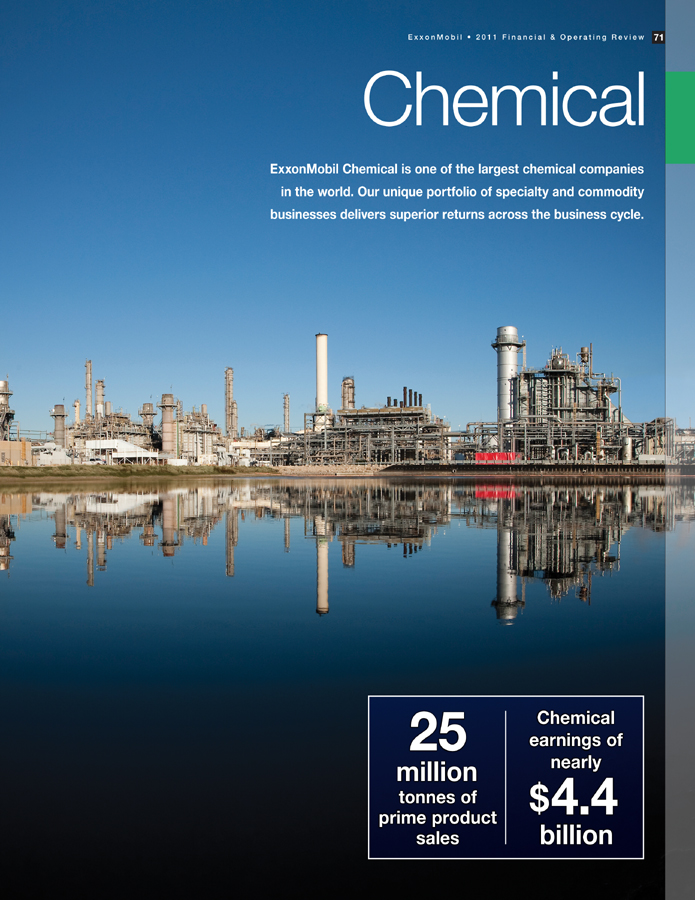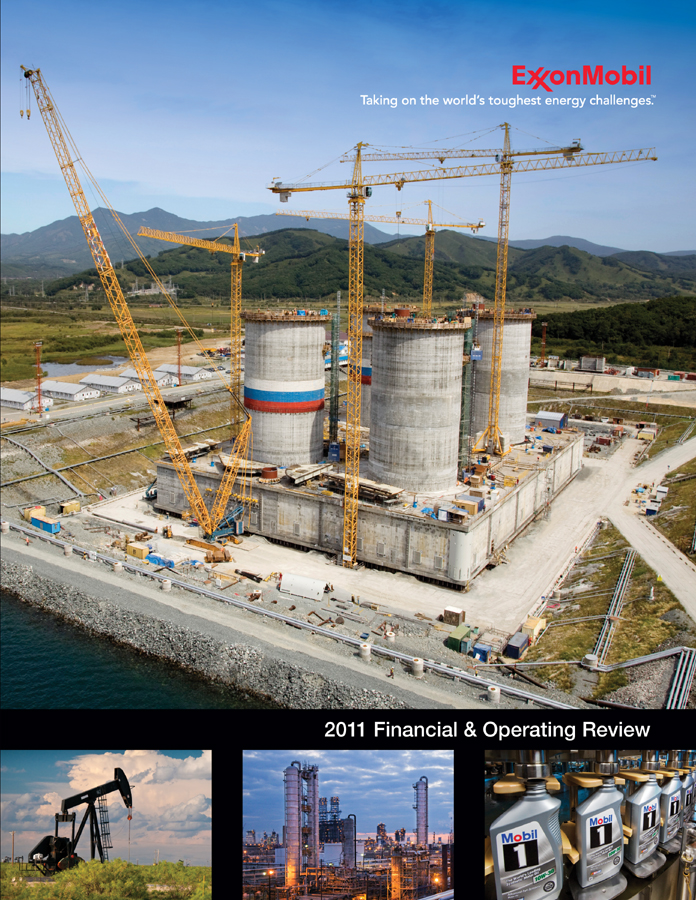
| ExxonMobil Taking on the world’s toughest energy challenges. 2011 Financial & Operating Review |
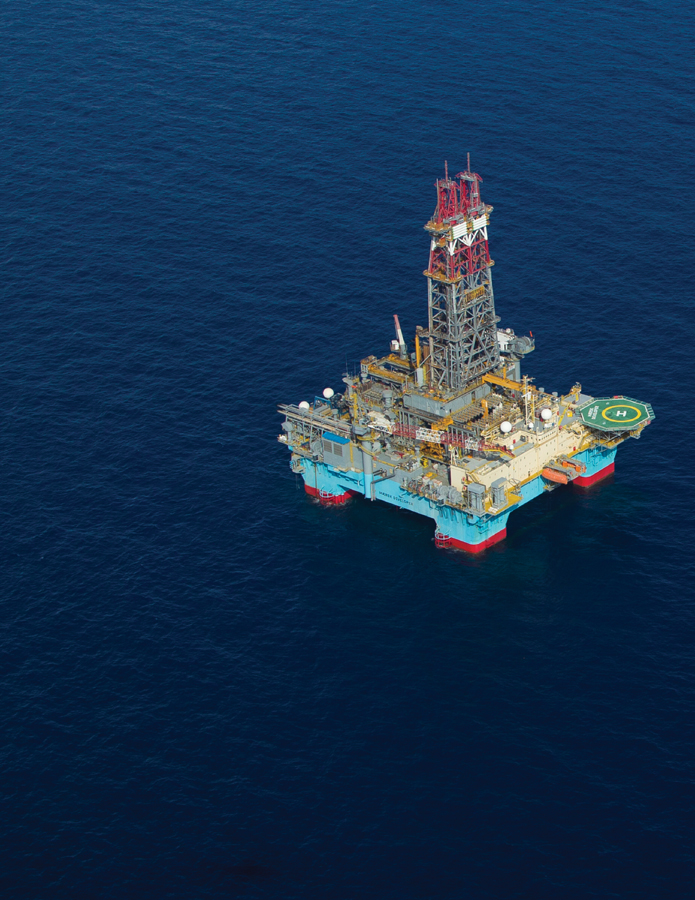 |
| Financial & Operating Summary | 1 | |||
| Business Model | 2 | |||
| Competitive Advantages | 3 | |||
| Global Operations | 4 | |||
| Upstream | 6 | |||
| Downstream | 52 | |||
| Chemical | 70 | |||
| Financial Information | 84 | |||
| Frequently Used Terms | 93 | |||
| Index | 96 | |||
| General Information | 97 |
On the Cover:Fabrication of the offshore platform for the
Arkutun-Dagi phase of the Sakhalin-1 project in Russia is nearing completion.
Arkutun-Dagi phase of the Sakhalin-1 project in Russia is nearing completion.
Inside Cover:In the U.S. Gulf of Mexico, we made a significant oil discovery with the Hadrian-5
exploration well. We estimate a recoverable resource in this area of more than 700 million oil-equivalent barrels,
making this one of the largest discoveries in the Gulf of Mexico in the last decade.
exploration well. We estimate a recoverable resource in this area of more than 700 million oil-equivalent barrels,
making this one of the largest discoveries in the Gulf of Mexico in the last decade.
The termUpstream refers to exploration, development, production, and gas and power marketing.Downstream refers to the refining and marketing of petroleum products such as motor fuels and lubricants.
Statements of future events or conditions in this report, including projections, targets, expectations, estimates, and business plans, are forward-looking statements. Actual future results, including demand growth and energy mix; capacity growth; the impact of new technologies; capital expenditures; project plans, dates, costs, and capacities; production rates and resource recoveries; efficiency gains; cost savings; product sales; and financial results could differ materially due to, for example, changes in oil and gas prices or other market conditions affecting the oil and gas industry; reservoir performance; timely completion of development projects; war and other political or security disturbances; changes in law or government regulation; the actions of competitors and customers; unexpected technological developments; the occurrence and duration of economic recessions; the outcome of commercial negotiations; unforeseen technical difficulties; unanticipated operational disruptions; and other factors discussed in this report and in Item 1A of ExxonMobil’s most recent Form 10-K.
Definition of certain financial and operating measures and other terms used in this report are contained in the section titled “Frequently Used Terms” on pages 93 through 95. In the case of financial measures, the definitions also include information required by SEC Regulation G.
“Factors Affecting Future Results” and “Frequently Used Terms” are also available on the “investors” section of our website.
Prior years’ data have been reclassified in certain cases to conform to the 2011 presentation basis.
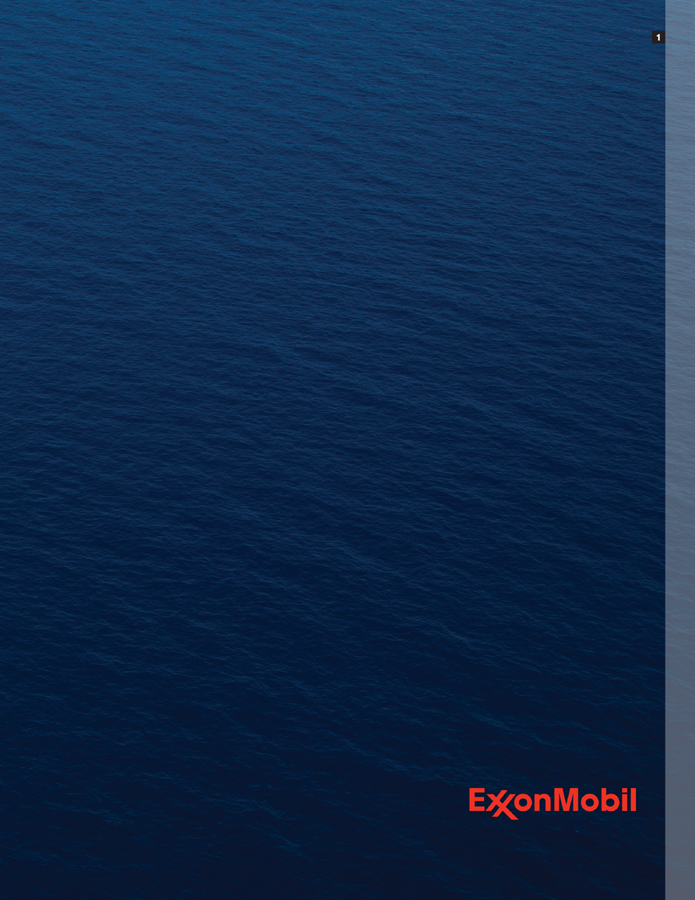 |
2011: Financial & Operating Summary
Our competitive advantages formed the framework for solid financial and operating results across all key measures and businesses in 2011. We achieved strong earnings and generated robust returns for our shareholders. We also continued to invest in attractive projects that position the company for sustained long-term growth and profitability.
FINANCIAL HIGHLIGHTS
| Average | Return on | Capital and | ||||||||||||||
| Earnings After | Capital | Average Capital | Exploration | |||||||||||||
| (millions of dollars, unless noted) | Income Taxes | Employed | (1) | Employed (%) | (1) | Expenditures | (1) | |||||||||
| Upstream | 34,439 | 129,807 | 26.5 | 33,091 | ||||||||||||
| Downstream | 4,459 | 23,388 | 19.1 | 2,120 | ||||||||||||
| Chemical | 4,383 | 19,798 | 22.1 | 1,450 | ||||||||||||
| Corporate and Financing | (2,221 | ) | (2,272 | ) | N.A. | 105 | ||||||||||
Total | 41,060 | 170,721 | 24.2 | 36,766 | ||||||||||||
OPERATING HIGHLIGHTS
Liquids production(net, thousands of barrels per day) | 2,312 | |||
Natural gas production available for sale(net, millions of cubic feet per day) | 13,162 | |||
Oil-equivalent production(2)(net, thousands of oil-equivalent barrels per day) | 4,506 | |||
Refinery throughput(thousands of barrels per day) | 5,214 | |||
Petroleum product sales(thousands of barrels per day) | 6,413 | |||
Chemical prime product sales(thousands of tonnes) | 25,006 |
OTHER RESULTS & HIGHLIGHTS
| Safety performance remains strong in industry | Total shareholder return of 19 percent(1) | |
Strong cash flow from operations and asset sales of $66.5 billion(1) | Total shareholder distributions of $29 billion(1) | |
Proved oil and gas reserve additions of 2.0 billion oil-equivalent barrels, replacing 116 percent of production, excluding asset sales(1) | Annual dividend per share growth of 6 percent versus 2010, the 29th consecutive year of dividend per share increases |
(1) See Frequently Used Terms on pages 93 through 95.
(2) Natural gas converted to oil-equivalent at 6 million cubic feet per 1 thousand barrels.

2 | ExxonMobil• 2011 Financial & Operating Review |
Business Model We employ a business model focused on achieving excellence in our daily operations, generating superior cash flow, and creating long-term shareholder value. As a result of the consistent application of this proven business model, we possess competitive advantages that support strong results today and position us well for decades to come. Rex W. Tillerson Chairman and CEO | 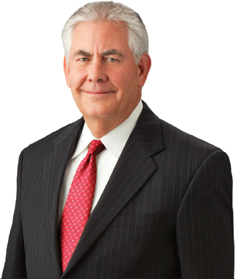 |
OUR BUSINESS MODEL IS SUPPORTED BY THE FOLLOWING FUNDAMENTAL ELEMENTS:
Operate in a Safe and Environmentally Responsible Manner
ExxonMobil employees are committed to excellence in safety, health, and the environment. Safety is a core value for us, one that shapes our decisions every day and at every level in our operations. A commitment to safety is the cornerstone of responsible operations and leads to better business results. In addition, in the area of environmental protection, we expect each of our businesses to deliver superior performance, lower incidents toward zero, and achieve industry-leading results.
We conduct business using an approach that is compatible with both the environmental and economic needs of the communities in which we operate. We have a number of programs to help advance the skills of local populations. These programs improve local business environments, lead to economic growth, and build stronger communities.
Uphold High Standards
We know that how we achieve results is as important as the results themselves. We choose the course of highest integrity in all of our business interactions. To support this objective, we have established a wide range of management systems that address critical aspects of our business. We expect disciplined application of these systems throughout the organization. Directors, officers, and employees must comply with our Standards of Business Conduct. ExxonMobil adheres to all applicable laws and regulations, and, when requirements do not exist, we apply responsible standards to our operations. We believe that a well-founded reputation for high ethical standards, strong business controls, and good corporate governance is a priceless asset.
Attract and Retain Exceptional People
Our goal is to develop our employees to have the best technical and leadership capabilities in the industry. We focus on merit-based, long-term career development and are committed to maintaining a diverse workforce. We recruit talented people from around the world and provide them with formal training and a broad range of global experiences to develop them into the next generation of ExxonMobil leaders. We know that delivering outstanding performance requires exceptional people.
Maintain Financial Strength
We maintain a financial position unparalleled in industry. Rating agencies Moody’s and Standard & Poor’s recognize our superior financial strength by assigning the highest credit rating to our financial obligations. We are one of very few public companies that have maintained this credit rating consistently for decades. Our financial strength gives us the capacity to pursue and finance attractive investment opportunities.
Competitive Advantages
As a result of our proven business model, ExxonMobil has established competitive advantages that are evident across all three of our business lines – Upstream, Downstream, and Chemical. These competitive advantages set us apart from industry and serve as the foundation for ongoing superior performance and the creation of long-term shareholder value.
Balanced Portfolio The quality, size, and diversity of our portfolio of resources, projects, products, and assets are unparalleled. The portfolio provides economies of scale and contains a large inventory of high-quality investment options across all business lines. It also provides us with the flexibility to take advantage of opportunities, supports future growth, and leads to strong financial and operating results.
Disciplined Investing We carefully assess investments over a range of potential market conditions and across time horizons that can span decades. Our approach to investing is to advance only those opportunities that are likely to provide long-term shareholder value. We focus on the efficient use of capital to achieve superior investment returns.
High-Impact Technologies ExxonMobil is an industry leader in the development and application of technology. We pursue high-impact technologies that can significantly improve our projects, operations, and products. Our ongoing technology investments, supported by dedicated technology centers, provide the company with competitive advantages in key aspects of our business.
Operational Excellence We employ management systems that are rigorously applied to our worldwide operations. These systems are designed to enable the consistent application of the highest operational standards. We also focus on maximizing value and enhancing efficiency in each of our businesses.
Global Integration The global integration of our business lines and functional organizations allows us to capture significant value across the supply chain, at manufacturing sites, and more broadly, in the management of critical, shared activities. The level of integration results in structural advantages that are difficult for competitors to replicate.
3 |
| Global Operations |
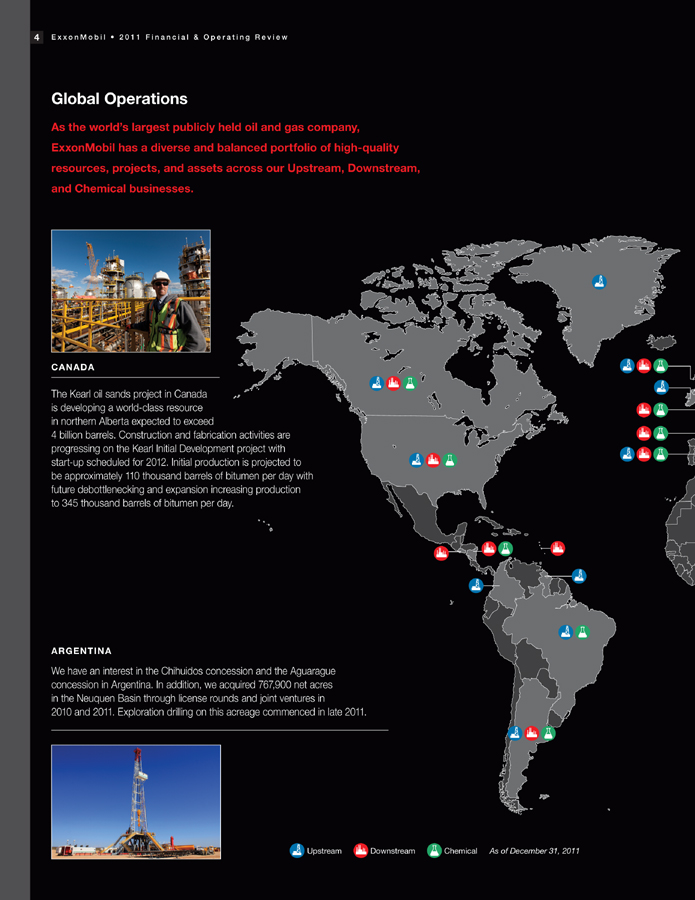
| ExxonMobil• 2011 Financial & Global Operations As the world’s largest publicly held oil and gas company, ExxonMobil has a diverse and balanced portfolio of high-quality resources, projects, and assets across our Upstream, Downstream, and Chemical businesses. CANADA The Kearl oil sands project in Canada is developing a world-class resource in northern Alberta expected to exceed 4 billion barrels. Construction and fabrication activities are progressing on the Kearl Initial Development project with start-up scheduled for 2012. Initial production is projected to be approximately 110 thousand barrels of bitumen per day with future debottlenecking and expansion increasing production to 345 thousand barrels of bitumen per day. ARGENTINA We have an interest in the Chihuidos concession and the Aguarague concession in Argentina. In addition, we acquired 767,900 net acres in the Neuquen Basin through license rounds and joint ventures in 2010 and 2011. Exploration drilling on this acreage commenced in late 2011. Upstream Downstream Chemical As of December 31, 2011 |
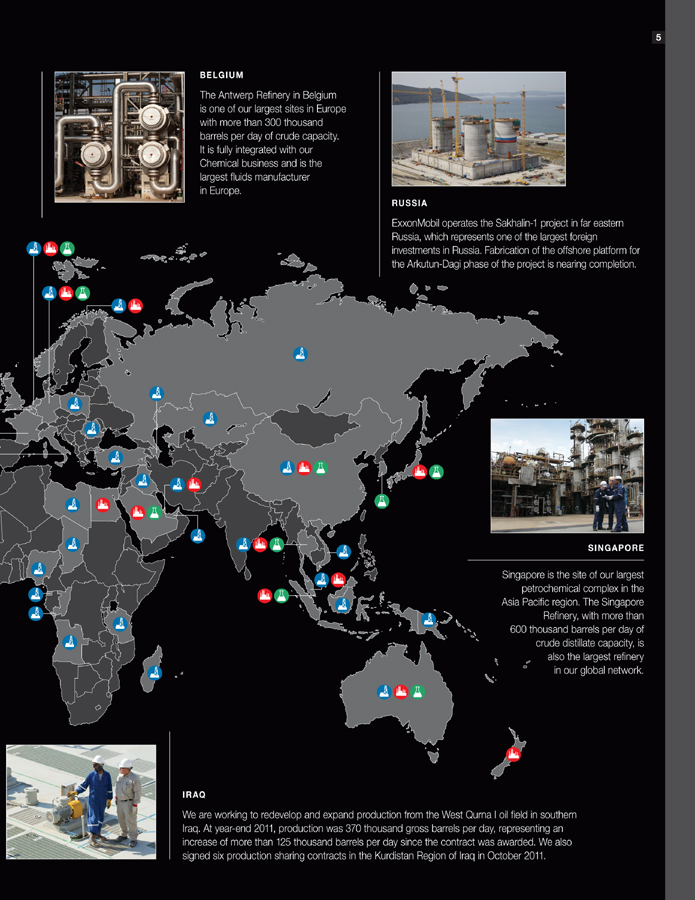
| BELGIUM The Antwerp Refinery in Belgium is one of our largest sites in Europe with more than 300 thousand barrels per day of crude capacity. It is fully integrated with our Chemical business and is the largest fluids manufacturer in Europe. RUSSIA ExxonMobil operates the Sakhalin-1 project in far eastern Russia, which represents one of the largest foreign investments in Russia. Fabrication of the offshore platform for the Arkutun-Dagi phase of the project is nearing completion. SINGAPORE Singapore is the site of our largest petrochemical complex in the Asia Pacific region. The Singapore Refinery, with more than 600 thousand barrels per day of crude distillate capacity, is also the largest refinery in our global network. IRAQ We are working to redevelop and expand production from the West Qurna I oil field in southern Iraq. At year-end 2011, production was 370 thousand gross barrels per day, representing an increase of more than 125 thousand barrels per day since the contract was awarded. We also signed six production sharing contracts in the Kurdistan Region of Iraq in October 2011. |
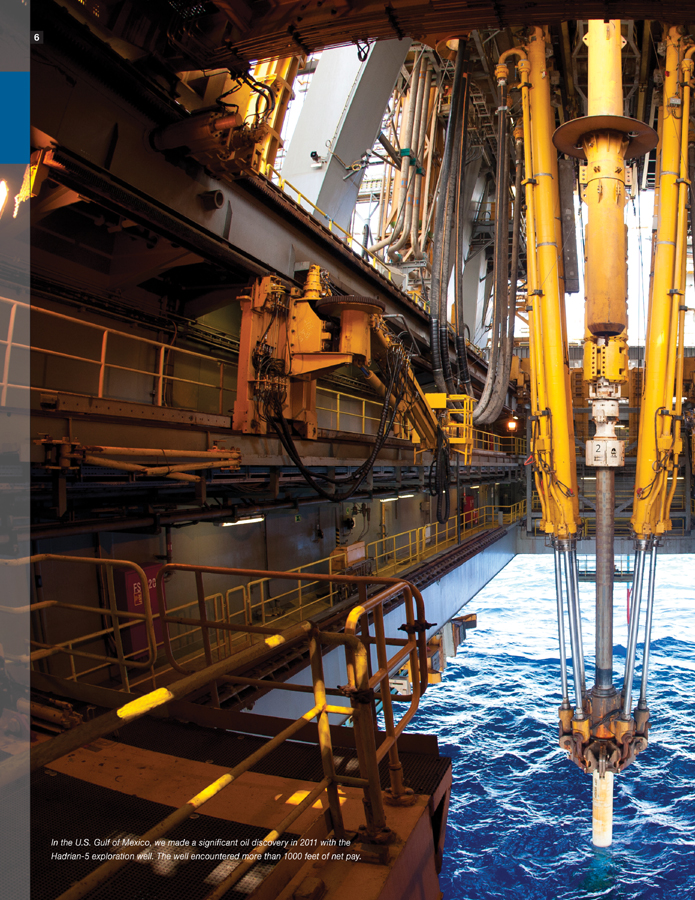
| In the U.S. Gulf of Mexico, we made a significant oil discovery in 2011 with the Hadrian-5 exploration well. The well encountered more than 1000 feet of net pay. |
| Upstream |
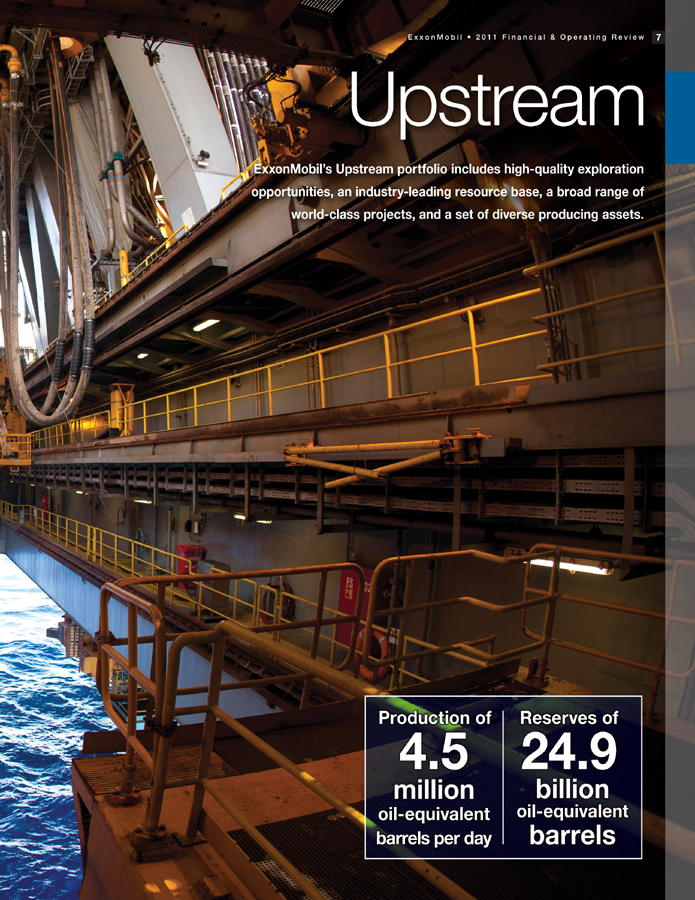
| ExxonMobil• 2011 Financial & 7 Upstream ExxonMobil’s Upstream portfolio includes high-quality exploration opportunities, an industry-leading resource base, a broad range of world-class projects, and a set of diverse producing assets. Production of Reserves of 4.5 24.9 million billion oil-equivalent oil-equivalent barrels per day barrels |
 | 8 |
ExxonMobil• 2011 Financial & Operating Review

ExxonMobil’s 2011 Upstream financial and operating results included strong safety and environmental performance, high facility reliability, continued operational and capital spending discipline, and solid production volume growth.
RESULTS & HIGHLIGHTS
Strong safety and operations performance supported by effective risk management
Industry-leading earnings of $34.4 billion
Return on average capital employed of 26.5 percent, averaging 33.7 percent over the last five years
Earnings per oil-equivalent barrel of $20.94
Total net production of 4.5 million oil-equivalent barrels per day, an increase of 1 percent versus 2010
Proved oil and natural gas reserve additions of 2.0 billion oil-equivalent barrels, replacing 116 percent of production, excluding asset sales
Resource base additions totaling 4.1 billion oil-equivalent barrels, increasing the overall resource base to 87 billion oil-equivalent barrels
Exploration resource addition cost of $1.40 per oil-equivalent barrel
Upstream capital and exploration spending of $33.1 billion with total investment over the past five years at more than $116 billion
Made a significant oil discovery in the U.S. Gulf of Mexico with the Hadrian-5 exploration well
Signed a strategic cooperation agreement with Rosneft
| UPSTREAM STATISTICAL RECAP | 2011 | 2010 | 2009 | 2008 | 2007 | |||||||||||||||
Earnings(millions of dollars) | 34,439 | 24,097 | 17,107 | 35,402 | 26,497 | |||||||||||||||
Liquids production(net, thousands of barrels per day) | 2,312 | 2,422 | 2,387 | 2,405 | 2,616 | |||||||||||||||
Natural gas production available for sale(net, millions of cubic feet per day) | 13,162 | 12,148 | 9,273 | 9,095 | 9,384 | |||||||||||||||
Oil-equivalent production(1)(net, thousands of barrels per day) | 4,506 | 4,447 | 3,932 | 3,921 | 4,180 | |||||||||||||||
Proved reserves replacement(2)(3)(percent) | 116 | 211 | 100 | 143 | 107 | |||||||||||||||
Resource additions(2)(millions of oil-equivalent barrels) | 4,086 | 14,580 | 2,860 | 2,230 | 2,010 | |||||||||||||||
Average capital employed(2)(millions of dollars) | 129,807 | 103,287 | 73,201 | 66,064 | 63,565 | |||||||||||||||
Return on average capital employed(2)(percent) | 26.5 | 23.3 | 23.4 | 53.6 | 41.7 | |||||||||||||||
Capital and exploration expenditures(2)(millions of dollars) | 33,091 | 27,319 | 20,704 | 19,734 | 15,724 | |||||||||||||||
| (1) | Natural gas converted to oil-equivalent at 6 million cubic feet per 1 thousand barrels. | |
| (2) | See Frequently Used Terms on pages 93 through 95. | |
| (3) | Proved reserves exclude asset sales and the 2007 Venezuela expropriation. Includes non-consolidated interests and Canadian oil sands. | |
| Note: Unless otherwise stated, production rates, project capacities, and acreage values referred to on pages 8 through 41 are gross. | ||

BUSINESS OVERVIEW
Our Upstream business includes exploration, development, production, natural gas and power marketing, and research activities. ExxonMobil pursues a balanced global exploration program designed to test new high-potential exploration areas, explore emerging unconventional opportunities, and add resources through ongoing activity in established areas. We have an industry-leading resource base and a diverse portfolio of projects that span a broad range of environments, resource types, and geographies. We continue to grow our resource base through successful by-the-bit drilling, capture of undeveloped resources, strategic acquisitions, and increased recovery from existing fields. Our approach to investing is to advance opportunities that are likely to provide competitive returns across a broad range of potential market conditions. We have nine projects expected to come online during 2012 and 2013, including three in Nigeria, one in Australia, one in Canada, one in Angola, and one in Malaysia. During this time frame, we also expect to start up the Kearl Initial Development project in Canada and the first phase of the Kashagan development in Kazakhstan. These projects will provide us with a strong foundation for future production growth and add to our existing world-class global portfolio of producing assets.
By 2040, unconventional natural gas is forecast
to account for 30 percent of global natural gas
production, up from 10 percent in 2010.
to account for 30 percent of global natural gas
production, up from 10 percent in 2010.
BUSINESS ENVIRONMENT
Oil and natural gas are expected to continue to play a leading role in meeting the world’s growing demand for energy. In fact, by 2040, oil and natural gas are projected to be the world’s top two energy sources, accounting for about 60 percent of global demand, versus about 55 percent today.
Demand for oil and other liquid fuels is forecast to increase by almost 30 percent over the next 30 years. As conventional oil production holds relatively flat through 2040, demand growth is expected to be met by new sources. The largest volume gain is likely to come from global deepwater production, which is estimated to more than double through 2040. We also project significant growth in production from oil sands, tight oil, and natural gas liquids. As a result of the growth in these newer resources, we anticipate that conventional oil will account for only about 60 percent of liquid fuels supply by 2040, down from 80 percent in 2010.
Natural gas is expected to be the fastest-growing major fuel through 2040, with demand increasing by more than 60 percent. A rising share of global natural gas demand will likely be met by unconventional gas supplies, such as those produced from shale and other rock formations.
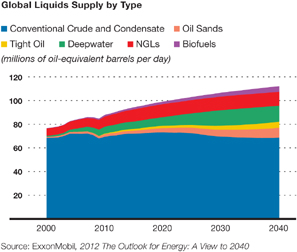
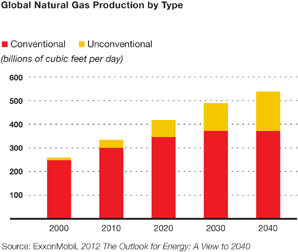
9 |  |
 | 10 |
ExxonMobil• 2011 Financial & Operating Review
UPSTREAM:
Balanced Portfolio
ExxonMobil’s Upstream portfolio includes high-quality exploration opportunities, an industry-leading resource base, a broad range of world-class development projects, and a set of diverse producing assets.
OVERVIEW
Our fundamental exploration strategy is to identify, evaluate, pursue, and capture the highest-quality opportunities across all resource types and in any environment. The combination of technical expertise, extensive global databases, and industry-leading research facilities provides us with a distinct competitive advantage in the pursuit, capture, and commercialization of new resources. In fact, recognition of these capabilities creates opportunities for us as other organizations seek a partner with our broad skills and experience.
We screen prospects for quality, materiality, and commercial viability. Technical capabilities and knowledge of the global hydrocarbon endowment allow us to identify and evaluate quality resources in the highest-potential basins. Careful consideration is given to ensure diversity and balance in our exploration portfolio with respect to resource type and risk. Only the best opportunities are selected for further investment. Once an opportunity is captured, we evaluate it in the most cost-effective manner and then apply what we learn to future investment decisions. This approach has led to the successful capture of new, high-potential resource opportunities every year.
We significantly expanded our prospective exploration portfolio in 2011 with the successful capture of 24 new opportunities in seven countries. At year-end 2011, net exploration acreage totaled 61 million acres in 32 countries. This strong position provides us with a high-quality, geographically and geologically diverse portfolio of prospects that underpins future resource additions and production growth. We participated in exploration drilling in 2011 involving conventional opportunities in established basins such as the Gulf of Mexico, frontier basins in the Black Sea, liquefied natural gas (LNG) opportunities in Australia, and unconventional oil and gas assets in the United States and Canada. We added approximately 4.1 billion oil-equivalent barrels to our resource base as a result of these successful efforts to identify, capture, and test new opportunities.
Our global portfolio of high-quality development projects and producing assets reflects a diverse range of resource types and operating environments. These projects and producing assets also span a broad range of maturities including new greenfield developments such as Kearl, Papua New Guinea (PNG) LNG, and Gorgon Jansz; early production assets like Odoptu in Sakhalin; and long-life assets such as Qatar, Tengiz, and Cold Lake.
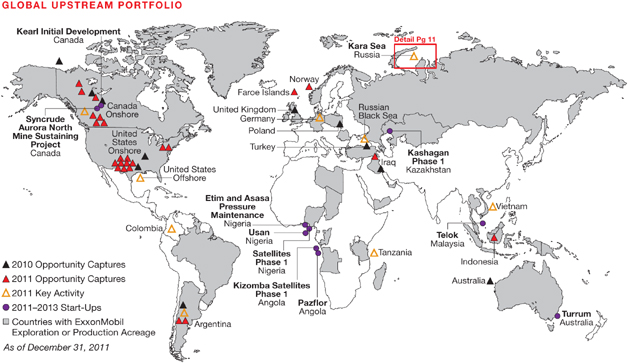
UP CLOSE:
ROSNEFT STRATEGIC COOPERATION AGREEMENT
Rosneft and ExxonMobil signed a Strategic Cooperation Agreement on August 30, 2011, to jointly participate in exploration and development activities in Russia, the United States, and other parts of the world. Both companies will share their expertise and technology to address the challenges of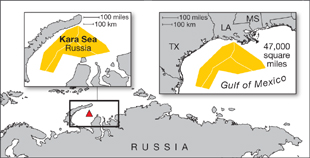 oil and natural gas exploration and production associated with diverse resource types including conventional reservoirs located in offshore arctic regions and unconventional reservoirs found onshore. A key aspect of this agreement involves 31 million acres in the Kara Sea, which is one of the world’s most prospective hydrocarbon provinces with a high potential for liquids. The Kara Sea is a very large area similar in size to the entire central U.S. Gulf of Mexico or the central North Sea. Seismic surveys are planned in the Kara Sea for 2012. Also included in the scope of the agreement is a 3-million-acre Black Sea block where seismic surveys are already under way. The partnership includes establishment of an Arctic Research and Design Center for Offshore Developments. An integral part of this research effort is the development of new, state-of-the-art, safety and environmental protection systems. In addition, a Joint Technical Study team will evaluate a tight oil project in the West Siberia Basin.
oil and natural gas exploration and production associated with diverse resource types including conventional reservoirs located in offshore arctic regions and unconventional reservoirs found onshore. A key aspect of this agreement involves 31 million acres in the Kara Sea, which is one of the world’s most prospective hydrocarbon provinces with a high potential for liquids. The Kara Sea is a very large area similar in size to the entire central U.S. Gulf of Mexico or the central North Sea. Seismic surveys are planned in the Kara Sea for 2012. Also included in the scope of the agreement is a 3-million-acre Black Sea block where seismic surveys are already under way. The partnership includes establishment of an Arctic Research and Design Center for Offshore Developments. An integral part of this research effort is the development of new, state-of-the-art, safety and environmental protection systems. In addition, a Joint Technical Study team will evaluate a tight oil project in the West Siberia Basin.

2011 OPPORTUNITY CAPTURES
In 2011, we continued to build on our already strong and diverse resource position with the capture of 24 new opportunities. These opportunities included both unconventional and conventional play types. As part of this successful effort, we leveraged experience gained in unconventional plays in North America to capture new acreage positions in both Argentina and Indonesia.
Argentina • ExxonMobil acquired an additional 636,000 net acres in the potentially liquids-rich portion of the Neuquen Basin in Argentina through strategic joint ventures. Two wells to evaluate the potential of this acreage commenced drilling in late 2011.
Canada • We expanded our position in the unconventional plays of the Western Canada Basin by adding 499,000 net acres through various provincial lease sales during the year. Exploration drilling also continued to test these highly-prospective plays.
Faroe Islands • In March 2011, ExxonMobil acquired a 49-percent interest in license L006 and a 50-percent interest in licenses L009 and L011 in the Faroe Islands, covering 1.1 million acres. The Statoil-operated Brugdan-2 wildcat is scheduled to be drilled on license L006 in 2012.
Indonesia • Early in 2011, we joined a production sharing contract to explore 700,000 net acres in Kalimantan to evaluate coal bed methane potential.
Iraq • In October 2011, ExxonMobil signed production sharing contracts for six blocks covering 848,000 acres in the Kurdistan Region of Iraq.
Norway • In May 2011, we acquired a 35-percent operating interest in the PL596 Møre Vest license, covering 787,000 acres, and a 30-percent interest in the PL598 Ygg High license, covering 409,000 acres.
U.S. Onshore • During the year, we increased by 80 percent our position in the Marcellus Shale gas play in the United States by acquiring approximately 310,000 net acres. Acquisitions also included roughly 45,000 net acres in the emerging, liquids-rich Utica Shale play in eastern Ohio, bringing our total position in that play to roughly 75,000 net acres at year-end 2011. In addition, through leasing and multiple acquisitions, we captured an industry-leading position of 172,000 net acres in the liquids-rich Woodford Ardmore Shale play of southern Oklahoma. ExxonMobil also added more than 154,000 net acres in the prospective tight oil plays of the Permian Basin in West Texas.
11 |  |
 | 12 |
ExxonMobil• 2011 Financial & Operating Review
Upstream: Balanced Portfolio, continued
RESOURCES AND PROVED RESERVES
Resources
ExxonMobil has a diverse, global portfolio of resources and reserves. We expanded our industry-leading resource base in 2011 by adding 4.1 billion oil-equivalent barrels. After adjusting for production, asset sales, and revisions to existing fields, the
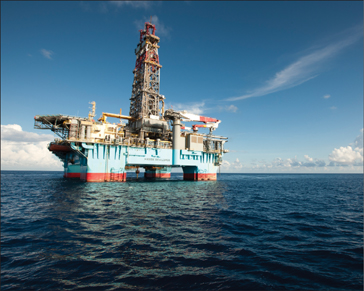
The Hadrian-5 well in Keathley Canyon Block 919 was the first exploration
well permitted and drilled following the U.S. Outer Continental Shelf Drilling
Moratorium.
well permitted and drilled following the U.S. Outer Continental Shelf Drilling
Moratorium.
resource base now totals more than 87 billion oil-equivalent barrels. Proved reserves comprise approximately 29 percent of the resource base, or 24.9 billion oil-equivalent barrels.
The success of our global strategy to identify, evaluate, pursue, and capture opportunities is demonstrated by the addition of an average of 5.2 billion oil-equivalent barrels to our resource base per year over the past five years. ExxonMobil’s resource base is the largest among international oil companies, resulting in a significant competitive advantage. The size and diversity also support risk management and investment flexibility.
We continue to grow the resource base through successful by-the-bit drilling, capture of undeveloped resources, strategic acquisitions, and increased recovery from existing fields. We added resources in 2011 from the deepwater
Gulf of Mexico, Australia, Indonesia, Vietnam, the Athabasca and Horn River plays in Canada, and onshore fields in the United States.
The success of our global strategy to identify, evaluate, pursue, and capture opportunities is demonstrated by the addition of an average of 5.2 billion oil-equivalent barrels to our resource base per year over the past five years. ExxonMobil’s resource base is the largest among international oil companies, resulting in a significant competitive advantage. The size and diversity also support risk management and investment flexibility.
We continue to grow the resource base through successful by-the-bit drilling, capture of undeveloped resources, strategic acquisitions, and increased recovery from existing fields. We added resources in 2011 from the deepwater
Gulf of Mexico, Australia, Indonesia, Vietnam, the Athabasca and Horn River plays in Canada, and onshore fields in the United States.
Our exploration by-the-bit drilling program added 2.3 billion oil-equivalent barrels in 2011 with additions from multiple resource types around the world. Additions from exploration drilling averaged approximately 2 billion oil-equivalent barrels per year over the past decade. The resource base managed by XTO Energy totaled approximately 13.6 billion oil-equivalent barrels at year-end 2011, and included shale gas, tight gas, shale oil, coal bed methane, and conventional resources.
Resource Base Changes(1)
| 5-Year | ||||||||
| (billions of oil-equivalent barrels) | 2011 | Average | ||||||
| Resource additions/acquisitions | 4.1 | 5.2 | ||||||
| Revisions to existing fields | 0.9 | (0.3 | ) | |||||
| Production | (1.7 | ) | (1.6 | ) | ||||
| Sales | (0.6 | ) | (0.6 | )(2) | ||||
| Net change versus year-end 2010 | 2.7 | 2.7 | ||||||
| (1) | See Frequently Used Terms on pages 93 through 95. | |
| (2) | Includes impact of the Venezuela expropriation in 2007. |
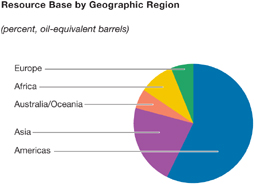
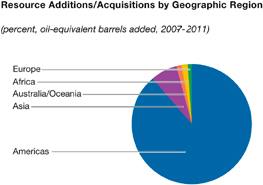
Our resource base is updated annually for new discoveries and changes in estimates for existing resources. These changes may result from additional drilling, revisions to recovery estimates, or the application of new technology. Updates may occur due to changes in fiscal regime, equity, or depletion plans. They also come from ongoing and rigorous geoscience and engineering technical evaluations. The volumes we produce during the year and the resources associated with asset divestments are also removed from the resource base at year end.
The largest component of ExxonMobil’s resource base remains conventional oil and gas and deepwater, which comprises 29 percent of the total. Heavy oil, predominantly located in Canada, accounts for just over 21 percent. Over the last decade, our position in both liquefied natural gas and unconventional gas and oil has increased significantly and makes up about 31 percent of total resources. The remainder is made up of arctic and acid/sour gas resources.
Application of proprietary processes and best practices has resulted in consistently low exploration resource addition costs. For example, in 2011, our exploration resource addition cost was $1.40 per oil-equivalent barrel, with the five-year average cost at $1.15 per oil-equivalent barrel. The 2011 resource additions provide us with an attractive set of future development opportunities.
Proved Reserves
ExxonMobil’s resource base includes 24.9 billion oil-equivalent barrels of proved oil and gas reserves, equating to 15 years of reserves life at current production rates. These reserves represent a diverse global portfolio distributed across all geographic regions and resource types, with an almost equal split between oil and natural gas.
We replaced 107 percent of the reserves we produced in 2011, including the impact of asset sales. We added 1.8 billion oil-equivalent barrels to proved reserves while producing 1.7 billion oil-equivalent barrels. Excluding asset sales, our proved reserves replacement ratio was 116 percent. Key proved reserve additions came from the Kearl Expansion project, which was sanctioned in 2011, and from unconventional assets in North America.
ExxonMobil has added 10 billion oil-equivalent barrels to proved reserves over the last five years, more than replacing production in that time frame. The development of new fields and extensions of existing fields have resulted in the addition of an average of 1 billion oil-equivalent barrels per year to proved reserves. Revisions to proved reserves have averaged about 0.7 billion oil-equivalent barrels per year over the last five years, driven by effective reservoir management and the application of new technology. We have more than replaced our production for 18 consecutive years. Proved reserve estimates are managed by a team of experienced reserve experts, and are the result of a rigorous and structured management review process.
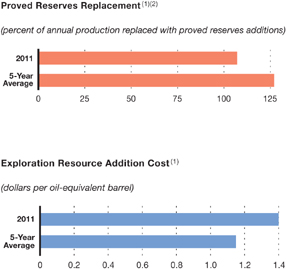
| (1) | See Frequently Used Terms on pages 93 through 95. | |
| (2) | Includes asset sales and the 2007 Venezuela expropriation. |
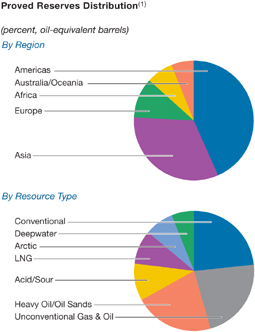
13 |  |
 | 14 |
E x x o n M o b i l • 2 0 1 1 F i n a n c i a l & O p e r a t i n g R e v i e w
UPSTREAM:
Disciplined Investing
A disciplined approach to investing combines effective project assessment and development with technical and commercial expertise. We apply this approach to initial resource capture, project execution, and ongoing operations to achieve superior returns on investment.
DISCIPLINED PROCESSES
Investment decisions in the energy industry are characterized by a time horizon measured in decades. As such, our projects are tested over a wide range of economic scenarios to ensure risks are properly identified, evaluated, and managed. ExxonMobil’s approach to investing in this cyclical business is to advance opportunities that will provide the most attractive returns across a broad range of potential market conditions, while maintaining a focus on the efficient use of capital. Proven project management systems incorporate best practices and are applied consistently around the world. Utilizing a disciplined gate review process, experienced global project teams rigorously manage our project portfolio from initial discovery to start-up.
We have a large, geographically diverse portfolio of more than 120 projects targeting development of 23 billion oil-equivalent barrels. These projects span a wide range of environments, resource types, and geographies, and provide us with the ability to selectively invest in those projects that are likely to deliver robust financial performance and profitable volumes growth.
Portfolio management is also a key aspect of disciplined investing. In 2010 and 2011, we completed sales involving interests in the Beryl field in the North Sea, the Gassled Transportation System in Norway, a gas storage business in Germany, conventional gas properties in western Canada, XTO’s legacy Gulf of Mexico properties, more than 50 shallow-water platforms in the Gulf of Mexico, and the Tempa Rossa joint venture in Italy.
MAJOR DEVELOPMENT PROJECTS
ExxonMobil participated in the start-up of one major project in 2011 and plans to bring 21 major projects online before year-end 2014. An additional 34 major projects are in various stages of planning, design, and execution.
Project Execution Performance – ExxonMobil Projects
| (Percent of plan, 2007-2011 Average) | Cost | Schedule | ||||||
| ExxonMobil Operated | 103 | 109 | ||||||
| Operated by Others | 109 | 114 | ||||||
Pazflor• (ExxonMobil interest, 20 percent) Pazflor started up in August 2011 utilizing a floating production, storage, and offloading (FPSO) vessel located approximately 100 miles offshore Angola in Block 17. The facility is expected to produce approximately 220 thousand barrels of oil per day through three subsea separation units.
Kizomba Satellites Phase 1• (ExxonMobil interest, 40 percent) Kizomba Satellites Phase 1 is scheduled to start up in the third quarter 2012 as a subsea tie back to the existing FPSO facilities in Angola Block 15. The project is expected to drill 18 wells and recover nearly 250 million barrels of oil, with a peak production rate of 100 thousand barrels of oil per day.
Kearl Initial Development• Kearl Initial Development (combined ExxonMobil and Imperial Oil interest, 100 percent) is expected to start up by year-end 2012. The Initial Development is anticipated to produce 110 thousand barrels of bitumen per day, with future potential of up to 170 thousand barrels of bitumen per day after debottlenecking. Kearl represents the first mining operation to employ a new proprietary paraffinic froth treatment technology, which produces a salable crude oil without an upgrader. As a result, Kearl’s life cycle greenhouse gas emissions will be no greater than that of the average crude oil consumed in the United States.
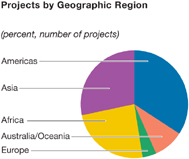
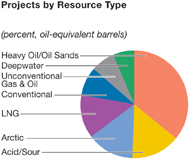
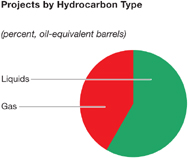
MAJOR PROJECT START-UPS
| Target Peak | ||||||||||||||||
| Production (Gross) | ExxonMobil | |||||||||||||||
| Liquids | Gas | Working | ||||||||||||||
| (KBD) | (MCFD) | Interest (%) | ||||||||||||||
| 2011(Actual) | ||||||||||||||||
| Angola | Pazflor | 220 | – | 20 | l | |||||||||||
| 2012-2014(Projected) | ||||||||||||||||
| Angola | Cravo-Lirio-Orquidea-Violeta | 160 | – | 20 | l | |||||||||||
| Kizomba Satellites Phase 1 | 100 | – | 40 | n | ||||||||||||
| Australia | Kipper/Tuna | 15 | 175 | 40 | n | |||||||||||
| Turrum | 20 | 200 | 50 | n | ||||||||||||
| Canada | Cold Lake Nabiye Expansion | 40 | – | 100 | n | |||||||||||
| Hibernia Southern Extension | 55 | – | 27 | n | ||||||||||||
| Kearl Initial Development | 170 | – | 100 | n | ||||||||||||
| Syncrude Aurora North | 215 | – | 25 | ▲ | ||||||||||||
| Mine Sustaining Project | ||||||||||||||||
| Syncrude Mildred Lake | 180 | – | 25 | ▲ | ||||||||||||
| Mine Sustaining Project | ||||||||||||||||
| Indonesia | Banyu Urip | 165 | 15 | 45 | n | |||||||||||
| Kazakhstan | Kashagan Phase 1 | 290 | – | 17 | l | |||||||||||
| Malaysia | Damar Gas | 5 | 200 | 50 | n | |||||||||||
| Telok | – | 370 | 50 | n | ||||||||||||
| Nigeria | Etim/Asasa Pressure Maintenance | 50 | – | 40 | n | |||||||||||
| Usan | 180 | – | 30 | l | ||||||||||||
| Satellite Field Development Phase 1 | 70 | – | 40 | n | ||||||||||||
| Papua New Guinea | PNG LNG | 30 | 940 | 33 | n | |||||||||||
| Russia | Sakhalin-1 Arkutun-Dagi | 90 | – | 30 | n | |||||||||||
| Qatar | Barzan | 85 | 1400 | 7 | ▲ | |||||||||||
| U.S. | Hadrian South | – | 300 | 47 | n | |||||||||||
| Lucius | 100 | 90 | 25 | l | ||||||||||||
| 2015+(Projected) | ||||||||||||||||
| Angola | AB32 Kaombo Split Hub | 210 | – | 15 | l | |||||||||||
| Kizomba Satellites Phase 2 | 65 | – | 40 | n | ||||||||||||
| Australia | Gorgon Area Expansion | 10 | 850 | 25 | l | |||||||||||
| Gorgon Jansz | 20 | 2835 | 25 | l | ||||||||||||
| Scarborough | – | 1190 | 50 | n | ||||||||||||
| Target Peak | ||||||||||||||||
| Production (Gross) | ExxonMobil | |||||||||||||||
| Liquids | Gas | Working | ||||||||||||||
| (KBD) | (MCFD) | Interest (%) | ||||||||||||||
| 2015+(Projected, continued) | ||||||||||||||||
Canada | Aspen | 80 | – | 100 | n | |||||||||||
| Firebag | 280 | – | 80 | n | ||||||||||||
| Hebron | 130 | – | 36 | n | ||||||||||||
| Kearl Expansion | 175 | – | 100 | n | ||||||||||||
| Mackenzie Gas Project | 10 | 830 | 56 | n | ||||||||||||
| Syncrude Aurora South Phase 1 and 2 | 200 | – | 25 | ▲ | ||||||||||||
Indonesia | Cepu Gas | – | 210 | 41 | n | |||||||||||
| Natuna | – | 1100 | ** | n | ||||||||||||
Iraq | West Qurna I* | 2825 | – | 60 | ▲ | |||||||||||
Kazakhstan | Kashagan Future Phases | 1260 | – | 17 | l | |||||||||||
| Aktote | 50 | 850 | 17 | l | ||||||||||||
| Tengiz Expansion | 250 | – | 25 | l | ||||||||||||
Nigeria | Bonga North | 100 | 60 | 20 | l | |||||||||||
| Bonga Southwest | 200 | 15 | 16 | l | ||||||||||||
| Bosi | 135 | 140 | 56 | n | ||||||||||||
| Erha North Phase 2 | 60 | – | 56 | n | ||||||||||||
| Satellite Field Development Phase 2 | 80 | – | 40 | n | ||||||||||||
| Uge | 110 | 20 | 20 | n | ||||||||||||
| Usan Future Phases | 50 | – | 30 | l | ||||||||||||
| Usari Pressure Maintenance | 50 | – | 40 | n | ||||||||||||
Norway | Aasgard Subsea Compression | 35 | 360 | 14 | l | |||||||||||
| Dagny | 65 | 185 | 33 | l | ||||||||||||
| Luva | – | 600 | 15 | l | ||||||||||||
Russia | Sakhalin-1 Future Phases | 30 | 800 | 30 | n | |||||||||||
United Arab Emirates | Upper Zakum 750 | 750 | – | 28 | ▲ | |||||||||||
U.K. | Fram | 20 | 140 | 69 | l | |||||||||||
U.S. | Alaska Gas/Point Thomson | 70 | 4500 | 36 | ** | |||||||||||
| Hadrian North | 100 | 100 | 50 | n | ||||||||||||
| Julia Phase 1 | 30 | – | 50 | n | ||||||||||||
KBD = Thousand barrels per day MCFD = Million cubic feet per day
n ExxonMobil Operated ▲ Joint Operation l Co-Venturer Operated
* Field debottlenecking in 2012 ** Pending Final Agreements
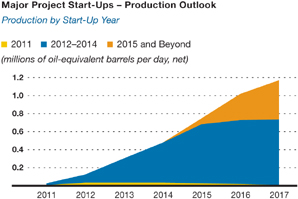

15 |  |
 | 16 |
E x x o n M o b i l • 2 0 1 1 F i n a n c i a l & O p e r a t i n g R e v i e w
UPSTREAM:
High-Impact Technologies
ExxonMobil’s commitment to invest in technology enables us to develop innovative solutions to improve safety, minimize environmental impact, reduce costs, increase reliability, and maximize resource value. Integrated technologies have unlocked value from previously uneconomic resources, including heavy oil and those trapped in tight reservoirs, as well as in difficult environments such as the Arctic and deep water.
HIGH-PERFORMANCE COMPUTING
High-performance computing (HPC) is a key enabling technology for our Upstream business. We are investing in massively parallel computational capability to support advanced seismic imaging and other research. Successful results at ExxonMobil’s Upstream Research Company have created demand in our business lines for early application of these technologies. Based on continued success, a next-generation petascale computing facility is being constructed. This new system will allow us to take on technical and computational challenges that until recently were considered impossible to solve.
3D Geomechanical Models
HPC capabilities allow us to run advanced numerical models to predict the stress field near salt bodies that are located in areas where significant exploration, development, and production activities take place. This new capability enhances our understanding of the irregular stress field around
| Our petascale computational capability allows 1015 operations per second |
salt and is critical for planning safe and economic drilling programs. These predictions help us to identify optimum drilling trajectories, reduce drilling-related wellbore instabilities, and decrease the likelihood of sidetrack drilling.
This approach requires high-performance computing to enable the development of 3D full-field model solutions on a schedule compatible with well planning. We are applying this emerging geomechanical modeling technology to salt provinces in the Caspian Sea, Angola, and the Gulf of Mexico. Recent applications of this technology resulted in the elimination of hole-related, nonproductive rig time in wells located near salt. This compares with five to eight days of nonproductive rig time for previously drilled wells nearby.
Advanced Seismic Imaging
One of the key technologies enabled by ExxonMobil’s petascale high-performance computing facility is our industry-leading seismic imaging capability.
Our researchers are developing seismic imaging technology that will generate high-definition subsurface models of geologic structures and rock properties. Proprietary computer algorithms accelerate massive computational tasks allowing our geophysicists to incorporate the full physics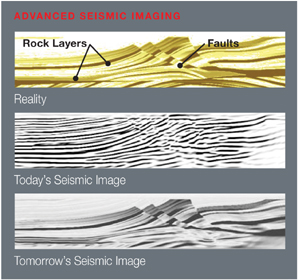 response, which is well beyond what is possible by conventional methods today. One such advance is the ability to simulate the full complexity of seismic wave propagation in the earth. ExxonMobil’s proprietary inversion methodology, which usesiterative inversion of data from simultaneous sources,is the basis for ourEMPrisetechnology. This recently patented seismic imaging technology positions us to be the industry leader in full wavefield inversion.
response, which is well beyond what is possible by conventional methods today. One such advance is the ability to simulate the full complexity of seismic wave propagation in the earth. ExxonMobil’s proprietary inversion methodology, which usesiterative inversion of data from simultaneous sources,is the basis for ourEMPrisetechnology. This recently patented seismic imaging technology positions us to be the industry leader in full wavefield inversion.

Full wavefield inversion will provide our geoscientists with focused 3D models of subsurface rock properties, predicted from seismic data, well in advance of drilling activities. At the initiation of this research program, we estimated that a single project would take tens of thousands of years to compute using the fastest computing technology then
High-performance computing enables advanced seismic
imaging, providing high-resolution images of the subsurface.
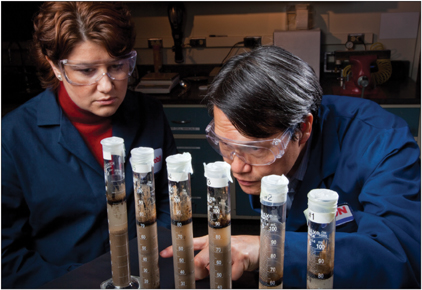
Our researchers are developing new recovery methods to increase the amount of bitumen
extracted from oil sand deposits with a fraction of the current water use.
extracted from oil sand deposits with a fraction of the current water use.
available. Capitalizing on advances in computing, and with proprietary technologies, we expect to produce high-fidelity subsurface images that are unmatched in industry, and in a time frame that is practical for business application.
EXTENDED-REACH DRILLING
We have an impressive record of completing successful developments in challenging environments, with over 90 years of experience in the Arctic, and a suite of patented technologies that position us as the industry leader in extended-reach drilling (ERD). We have drilled 23 of the world’s 27 longest-reach wells. These long-reach wells enable development of oil and gas with a reduced footprint and less environmental impact.
We continue to advance ERD by progressing several additional drilling and completion technologies. ExxonMobil’s patented Internal Shunt Alternate Path Technology (ISAPT) saw its first commercial application with zonal isolation in 2011. ISAPT enables reliable long horizontal well completions in
ExxonMobil has drilled 23 of the 27 longest-reach
wells in the world, the longest exceeding 7.1 miles.
wells in the world, the longest exceeding 7.1 miles.
unconsolidated sandstone formations. Our cuttings transport approach is supported by large-scale experiments and advanced physics-based modeling. In addition, ExxonMobil’s patented VYBS technology reduces drill string vibration.
OIL SANDS RESEARCH
We are developing technologies to reduce both the environmental impact and the cost of extracting bitumen, a heavy oil resource that is either mined or developed in situ.
New stratigraphic and geologic modeling technologies allow for more accurate predictions of the oil sands resources in place, reducing the number of core holes drilled for development. New land and shallow seismic methods are also providing low-cost geophysical data for resource characterization.
As a founding member of the Oil Sands Tailings Consortium (OSTC), Imperial Oil, an ExxonMobil affiliate, is working to accelerate industry-wide solutions to one of the largest environmental challenges for heavy oil assets. This unique partnership opens the door for collaboration in the development of next-generation reclamation technologies. We are leveraging the OSTC to evaluate new tailings treatment technologies prior to start-up of our Kearl oil sands project in late 2012. Additionally, we are progressing the development of proprietary technology to allow for nonaqueous extraction of bitumen, which has the potential to significantly reduce water usage and ultimately eliminate the need for wet-tailings ponds.
ExxonMobil and Imperial Oil are also advancing bitumen recovery technologies to facilitate commercial development of additional in situ bitumen resources, which are buried too deep for mining, while improving environmental performance. Current efforts are focused on the use of solvents to access undeveloped resources, improve bitumen recovery, and reduce greenhouse gas emissions. The patentedLiquid Assisted Steam Enhanced Recovery (LASER)technology, first commercially applied at Cold Lake, increases bitumen recovery rates by adding a small amount of solvent to an existing high-pressure cyclic steam injection technology application. Additionally, we are progressing a Cyclic Solvent Process field pilot, which is scheduled for a 2013 start-up. Results from pre-commercial trials and pilots of these technologies will provide invaluable information, allowing us to optimize our long-term resource development plan and increase bitumen production.
17 |  |
 | 18 |
E x x o n M o b i l • 2 0 1 1 F i n a n c i a l & O p e r a t i n g R e v i e w
UPSTREAM:
Operational Excellence
We rigorously apply management systems worldwide to enable consistent application of the highest operational standards. We maximize the value of existing assets through strong reliability performance and selective investment.
OPERATIONAL INTEGRITY AND RISK MANAGEMENT
Operational integrity is an essential aspect of our ongoing success. ExxonMobil’s Operations Integrity Management System (OIMS) encompasses all aspects of our operations and enables us to understand and minimize risks. OIMS is used consistently around the world with compliance tested on a regular basis.
In addition to OIMS, ExxonMobil employs a comprehensive set of risk management systems to address the risks found in all aspects of our operations. For example, we have risk management systems tomonitor drilling, construction and project management, facility integrity, and well work. We also manage the risks associated with supporting activities such as aviation and logistics, business controls, and the oversight of joint-venture assets.
We employ a comprehensive set of risk
management systems to minimize the risks
inherent in our business.
management systems to minimize the risks
inherent in our business.
RELIABILITY
ExxonMobil achieves high facility uptime by leveraging a suite of equipment maintenance best practices that we have developed over our considerable operational history. Large-scale maintenance activities are rigorously planned and executed using a globally consistent shutdown management process to minimize production impact.
MANAGING THE BASE
We focus on the effective management of base performance through rigorous operational surveillance and optimization. Through effective reservoir management and depletion planning, we increase economic resource recovery, maximize profitability, and ensure optimum long-term field performance. New production volumes are added through drill wells, workovers of existing wells, and secondary and tertiary recovery programs. These programs increase resource recovery using water, gas, or carbon dioxide, heavy oil steam flooding, and sour gas injection techniques. We continue to selectively progress an inventory of investment opportunities to derive the most value from existing assets. ExxonMobil also seeks to maximize efficiencies and cost savings in drilling operations with the application of our proprietaryFast Drillprocess and extended-reach drilling capabilities.
We develop and deploy management systems across the various aspects of our business to maximize the efficiency and value of our assets.
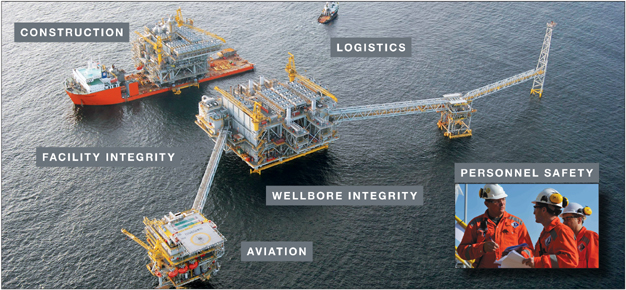
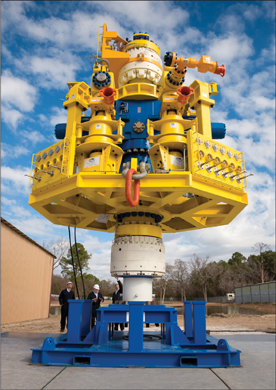
UP CLOSE:
MARINE WELL CONTAINMENT
ExxonMobil, along with other companies, is leading the development of a rapid-response oil spill containment system for the Gulf of Mexico. The system involves a commitment in excess of $1 billion on behalf of 10 member companies of the Marine Well Containment Company (MWCC), a not-for-profit industry organization. The system will be adaptable for a wide range of well designs, oil flow rates, and environmental conditions. It will be available to initiate deployment within 24 hours of notification, and able to capture, store, and offload up to 100 thousand barrels of oil per day in water as deep as 10,000 feet. Engineering and construction activities are progressing for this purpose-built system which, when complete, will be owned and operated by MWCC.
PRODUCTION VOLUMES
ExxonMobil’s approach to operational excellence allows us to deliver consistent volumes growth and maximize the profitability of existing oil and gas production. Net oil-equivalent production in 2011 of 4.5 million barrels per day increased by 1 percent over 2010 levels. Excluding the impacts associated with entitlement volume effects, quotas, and divestments, our net oil-equivalent production increased by more than 4 percent versus 2010, primarily driven by unconventional activities in the United States and project activity in Qatar, Angola, Russia, and Iraq, which more than offset field decline.
Near-term volume growth will focus on large liquids projects in Iraq and Canada, liquefied natural gas projects in Papua New Guinea and Australia, and unconventional gas and liquids activity in the United States. Longer-term growth will leverage our technical expertise in developing a diverse global project portfolio. We are already pursuing a number of these projects, many of which will result in long-plateau production profiles that run for decades.
The forward-looking projections of production volumes in this document are reflective of our best assumptions regarding technical, commercial, and regulatory aspects of existing operations and new projects. Factors that could impact actual volumes include project start-up timing, regulatory changes, quotas, changes in market conditions, asset sales, operational outages, severe weather, and entitlement volume effects under certain production sharing contracts and royalty agreements.
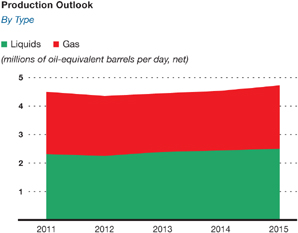
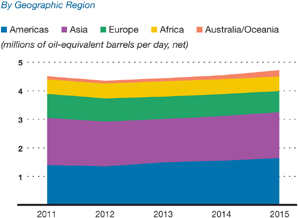
19 |  |
 | 20 |
E x x o n M o b i l • 2 0 1 1 F i n a n c i a l & O p e r a t i n g R e v i e w
UPSTREAM:
Global Integration
The benefit we derive from a globally integrated business model is one of the primary reasons we are able to successfully develop some of the most challenging energy projects. Global functional organizations, robust management processes, and best practices combined with an ability to leverage expertise across ExxonMobil’s Upstream, Downstream, and Chemical businesses enable us to identify and deliver innovative solutions for our operations and projects.
GLOBAL FUNCTIONAL ORGANIZATION
Our global functional organization allows us to leverage expertise and knowledge in every location where we conduct business. In doing so, we combine the strengths of local affiliates and centralized locations to maximize the value of our global portfolio. Utilizing global engineering organizations, we deploy technical expertise to develop optimal solutions to the operational challenges we face around the world. For example, Maximizing Recovery Workshops are designed to identify opportunities to profitably capture additional hydrocarbons in existing assets. Over the past four years, we have conducted these workshops on many of the major fields operated by ExxonMobil, which has led to resource additions of approximately 1.8 billion oil-equivalent barrels. As a result, we defined and
documented numerous potential activities with several of the more material opportunities now progressing through the project review process.
The benefits of a global functional organization extend to our operations as well, where we are
Global functional organizations, processes, and best practices enable us to deliver innovative solutions.
deploying a global Work Management System. This system helps to ensure work activities at operating sites are planned and executed in a structured and controlled manner, allowing us to effectively manage risks and safety exposures. We developed the Work Management System by utilizing an electronic work permit process, and by leveraging operational experience from around the globe. We anticipate the system will deliver additional work execution efficiencies and improvements in safety performance.
In addition, ExxonMobil employs a worldwide team of commercial experts, armed with detailed knowledge of global energy markets, to maximize the value of our natural gas and natural gas liquids production.
INTEGRATION ACROSS THE VALUE CHAIN
Integrated commercial activities across the resource value chain support development of our Upstream projects. For example, the mega-train ventures in Qatar demonstrated the importance of economies of scale and the competitive advantages obtained through the integrated development of large gas resources. The integration of field development, liquefaction, shipping, and regasification in key global markets resulted in significant benefits for the Qatar projects.
We also continue to find innovative ways to further integrate our natural gas and natural gas liquids production activities. Well-established business teams, with representatives from across ExxonMobil, work together to ensure that the value of natural gas and natural gas liquids production is maximized through integration with our refining and chemical facilities. For example, in the United Kingdom, we maximize the throughput from our North Sea natural gas liquids extraction plants to provide ethane feedstock to processing facilities at our Fife ethylene plant. In the United States, we also optimize our portfolio of natural gas and natural gas liquids to provide a secure supply for ExxonMobil’s refining and chemical facilities. In North America, we are expanding these activities with the increase in natural gas liquids volumes from liquids-rich unconventional production from our extensive portfolio of resources.
Our internal power requirements also provide another opportunity for integration. Power generation and purchasing expertise enable us to capture additional value while increasing efficiency and reducing emissions. We are an industry leader in the application of cogeneration technology with interests in almost 5 gigawatts of capacity across 100 installations. We continue to pursue cogeneration opportunities around the world to efficiently supply the power and steam demands of ExxonMobil’s Upstream, Downstream, and Chemical facilities. In 2011, we progressed construction of 220 megawatts of additional cogeneration capacity in Singapore. Similar projects in Canada and Europe are in the advanced stages of development.
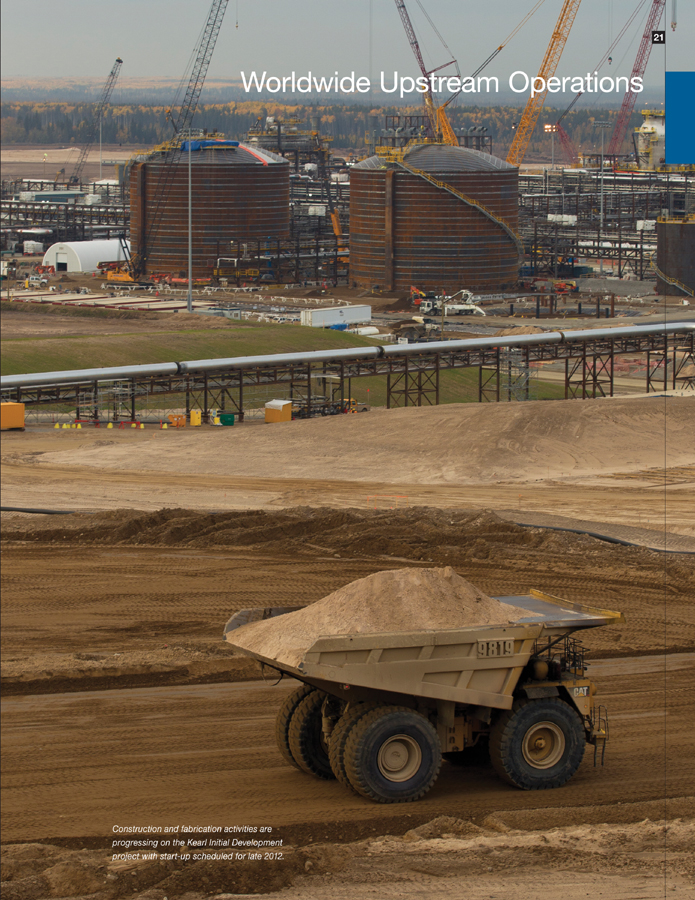
| Worldwide Upstream Operations Construction and fabrication activities are progressing on the Kearl Initial Development project with start-up scheduled for late 2012. |
 | 22 |
ExxonMobil• 2011 Financial & Operating Review
UPSTREAM:
Worldwide Upstream Operations
ExxonMobil has an interest in exploration and production acreage in 36 countries and production operations in 23 countries.
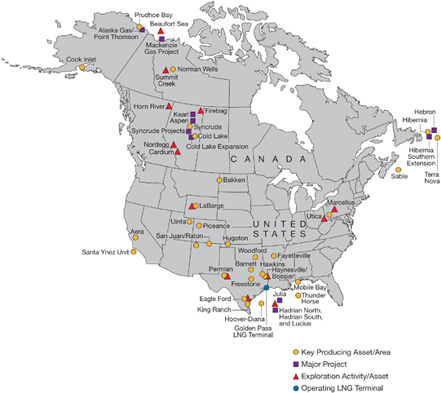
THE AMERICAS
Our portfolio in the Americas includes conventional fields onshore, ultra-deepwater developments, various unconventional gas and oil opportunities, and oil sands and heavy oil plays. Operations in the Americas contributed 31 percent of net oil-equivalent production and 23 percent of Upstream earnings in 2011.
UNITED STATES
ExxonMobil is a leading reserves holder and producer of oil and natural gas in the United States.
We maintain a significant position in all major producing regions, including the offshore Gulf of Mexico, the Gulf Coast, the mid-continent, California, and Alaska. Technological improvements, operational efficiency, and high-quality drilling programs are extending the lives of our base producing fields, some of which have been onstream for decades. Our portfolio is further augmented by activity in unconventional gas and oil plays and future developments arising from ExxonMobil’s extensive deepwater Gulf of Mexico acreage position.
Gulf of Mexico/Gulf Coast
We produced oil and gas in the offshore Gulf of Mexico with average net production of 57 thousand barrels of liquids per day and 254 million cubic feet of gas per day in 2011.
Over the past two years, we highgraded our Gulf of Mexico portfolio through three separate transactions, including the sale of selected properties to Energy XXI, which closed in late 2010 with operatorship transferred in 2011, the sale of Eugene Island block 314 to Arena Energy in June 2011, and the divestment of XTO Energy’s legacy offshore Gulf of Mexico properties to a private operator in August 2011.
| Americas Highlights | 2011 | 2010 | 2009 | |||||||||
Earnings(billions of dollars) | 7.8 | 5.9 | 3.8 | |||||||||
Proved Reserves(BOEB) | 10.8 | 9.8 | 7.1 | |||||||||
Acreage(gross acres, million) | 50.2 | 51.4 | 49.5 | |||||||||
Net Liquids Production(MBD) | 0.7 | 0.7 | 0.7 | |||||||||
Net Gas Available for Sale(BCFD) | 4.3 | 3.2 | 1.9 | |||||||||
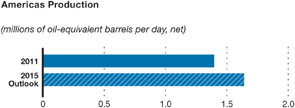
Deepwater • In the deepwater Gulf of Mexico, drilling operations on the Hoover platform (ExxonMobil interest, 67 percent) resumed on September 19, 2011, following a delay resulting from the Outer Continental Shelf Drilling Moratorium in 2010. The Hoover platform is located in more than 4800 feet of water, and produces oil and gas from the Hoover field and several subsea tiebacks.
Activity also continues at the Hadrian discovery (ExxonMobil interest, 50 percent) in Keathley Canyon (KC). The resource size in the Hadrian area has grown with additional discoveries. The Hadrian-5 exploration well in KC919 discovered more than 1000 feet of net pay in a compartment adjacent to the Hadrian North discovery. We will develop the Hadrian-5 discovery under a unit agreement as part of the Anadarko-operated Lucius field. ExxonMobil and the co-venturers in the field are progressing engineering and design activities
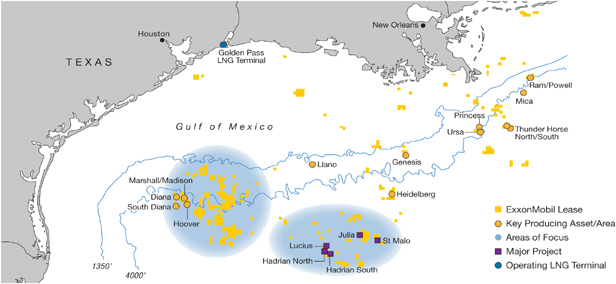
for the Hadrian North oil discovery, which is situated on blocks KC918 and KC919. We also funded the Hadrian South project for subsea tie-back to Anadarko’s Lucius platform with start-up planned for mid-2014. Engineering and technology qualification activities for the Julia discovery (ExxonMobil interest, 50 percent) in Walker Ridge are also progressing.
Additionally, we have a substantial exploration portfolio of 1.3 million net acres in the deepwater Gulf of Mexico and continue to make significant investments in advanced seismic data to further enhance our position. ExxonMobil was also the high bidder on 50 Offshore Continental Shelf (OCS) blocks in Sale 218 held in December 2011.
Conventional • The Mobile Bay development offshore Alabama contributed net production of 137 million cubic feet of gas per day during 2011. We realized significant cost efficiency and environmental benefits in 2011 with the completion of a project to consolidate sour gas treating plants in late 2010.
LNG • The Golden Pass liquefied natural gas (LNG) regasification terminal (ExxonMobil interest, 18 percent) in Sabine Pass, Texas, completed commissioning in June 2011. The terminal has the capacity to supply up to 2 billion cubic feet of natural gas per day to the U.S. market.
U.S. Onshore Texas and Louisiana
ExxonMobil is a leading producer in Louisiana and Texas with a strong position in multiple unconventional gas plays and in the Permian Basin. Onshore net production in Texas and Louisiana added 97 thousand barrels of liquids per day and 2 billion cubic feet of gas per day in 2011.
Conventional • During the year, we shifted drilling activity to liquids opportunities to take advantage of strong realizations. In the liquids-rich Permian Basin, we completed 63 wells across multiple legacy fields, primarily Goldsmith, Russell, and University Block 9. Across our portfolio, we are developing several enhanced oil recovery projects to extend the life of mature assets, including the Means, Talco, and Hawkins fields. The Means Residual Oil Zone project in West Texas commenced in 2011 with the first carbon dioxide injection in December. ExxonMobil also constructed the Hawkins Nitrogen Recovery Unit in 2011, with start-up anticipated in early 2012. We finalized partial unitization of the Talco field in 2011, laying the foundation for future projects. In South Texas, the King Ranch gas plant processed an average of more than 500 million cubic feet of inlet gas per day.
Unconventional • ExxonMobil holds 250,000 net acres in the Haynesville/Bossier Shale of East Texas and Louisiana, one of our strongest onshore production growth areas. Average production more than doubled in 2011, driven by the completion of 66 wells, mainly in the southern core area. By-the-bit drilling success also included completion of seven wells in the overlying Bossier Shale reservoir, which is in place across much of the southern area of the Haynesville play.
In the Barnett Shale play in North Texas, we completed 180 wells in 2011 across a leasehold of 235,000 net acres. Despite a 14-percent increase in per-well measured depth, resulting from longer laterals, we have reduced drilling days per well by 58 percent over the past six years as a result of continuous improvements in efficiency.
23 |  |
 | 24 |
ExxonMobil• 2011 Financial & Operating Review
Upstream: Worldwide Upstream Operations, continued
In the Freestone tight gas trend, ExxonMobil has approximately 305,000 net acres under lease. We brought 154 wells online in the Freestone in 2011, balancing traditional, multipay vertical well completions with increasing horizontal development of the prolific Cotton Valley Lime and Bossier horizons.
In the South Texas Eagle Ford Shale play, we drilled 23 wells as delineation progressed across our 90,000 net acres. We are processing the liquids-rich gas through our King Ranch facility. In the Permian Basin, ExxonMobil is evaluating the unconventional potential across roughly half of our approximately 800,000 net acres of leasehold. We also acquired an additional 154,000 acres in 2011 and commenced a drilling program to test new tight liquids plays.
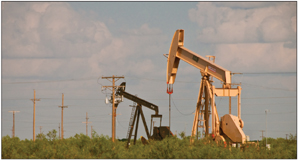
Evaluation of unconventional potential continues across our liquids-rich Permian Basin acreage.
Mid-Continent and Appalachia
ExxonMobil produces oil and gas throughout the mid-continent states, including Wyoming, Utah, North Dakota, Montana, Colorado, Kansas, Oklahoma, Arkansas, and New Mexico, and the Appalachian states of Pennsylvania and West Virginia. Average net production from these areas in 2011 was 25 thousand barrels of liquids per day and 480 million cubic feet of gas per day.
Conventional• The LaBarge development (ExxonMobil interest, 100 percent) in Wyoming comprises the Madison, Tip Top, and Hogsback fields, and the Shute Creek gas processing plant. It includes the longest sour gas pipeline in the United States and the world’s largest helium recovery and physical solvent gas sweetening plants. The operation celebrated its 25th anniversary in 2011. Implementation of a project to improve environmental performance of the Shute Creek plant’s compressor engines is progressing, with expected start-up in early 2012. The LaBarge facilities processed an average of 705 million cubic feet of inlet gas per day in 2011.
A demonstration plant at the Shute Creek facility tested ExxonMobil’s proprietaryControlled Freeze Zone(CFZ) technology in 2011, with testing continuing in 2012. By using a single-step cryogenic separation process, CFZ could lower the cost of removing carbon dioxide and hydrogen sulfide from natural gas. It could also assist in the application of carbon capture and storage to help reduce greenhouse gas emissions.
Unconventional• Following an acquisition in late 2010 and the completion of 185 wells, gas production from the Fayetteville Shale doubled in 2011. Pad drilling, optimized well spacing, and improved drilling processes are increasing efficiencies as development proceeds on ExxonMobil’s 535,000 net acres of leasehold. For example, using mud drilling instead of air drilling has reduced both well costs and environmental footprint. In addition, a pilot is under way to apply ExxonMobil’sJust-In-Time-Perforating(JITP) fracture stimulation process to horizontal wells, which holds significant potential for further efficiency improvement.
We are involved in several emerging liquids-rich shale plays, the most active of which is the Woodford Shale in the southern Oklahoma Ardmore Basin. By year-end 2011, ExxonMobil established a leadership position of 172,000 net acres in the Woodford Ardmore, and tripled both operated rig count and production. In addition, 31 Ardmore wells were brought on production during the year.
In the tight oil reservoirs of the Bakken Shale, we completed 51 wells in 2011 to delineate multiple core areas across our 395,000 net acre leasehold. We plan to move the play from delineation to development in 2012, using optimized drilling, spacing, and proprietary completion processes.
In the Marcellus Shale, ExxonMobil completed the acquisition of the Phillips Companies in June 2011, which coupled with the purchase of additional assets in West Virginia, increased our Marcellus acreage position to approximately 660,000 net acres. Following these acquisitions and the completion of 38 wells, production in the Marcellus Shale increased more than threefold during the year. In addition, the acquisition of the Phillips Companies provided an entry into the liquids-rich Utica Shale play of eastern Ohio, a position that was increased to roughly 75,000 net acres by year-end 2011 through additional leasing. We expect to drill and complete our first wells in the Utica Shale in 2012.
In Colorado, the Piceance development (ExxonMobil interest, 100 percent) contributed net production of 133 million cubic feet of gas per day in 2011. ExxonMobil has approximately 300,000 net acres under lease in the Piceance Basin. During 2011, we made significant progress to enhance drilling technology to reduce the overall footprint of future drilling well pads, thereby reducing development costs and environmental impacts. For example, we completed the first pitless fracturing operation in October 2011.
California
Net production from fields both onshore and offshore California averaged 92 thousand barrels of liquids per day and 26 million cubic feet of gas per day during 2011.
The Santa Ynez development (ExxonMobil interest, 100 percent) consists of three platforms located 5 miles offshore Santa Barbara and a processing plant in Las Flores Canyon. We continue to successfully employ world-class extended-reach drilling from these platforms to increase recovery. In offshore California, drilling operations resumed in November 2011 following delays resulting from the Outer Continental Shelf Drilling Moratorium in 2010. In onshore California, continuous single rig drilling commenced in late 2010. ExxonMobil also has a 48-percent equity share in Aera Energy LLC’s operations, comprising eight fields and about 11,000 wells that produce 66 thousand net oil-equivalent barrels per day of a mixture of heavy and conventional oil with associated natural gas.
Alaska
Average net production in Alaska was 114 thousand barrels of liquids per day in 2011. ExxonMobil is the largest holder of discovered natural gas resources on the North Slope of Alaska. ExxonMobil and the State of Alaska are working on a comprehensive plan to bring Point Thomson on production, including options for full development of Alaska’s gas resources over the long term. ExxonMobil and other working interest owners are identifying resource development alternatives and progressing associated agreements.
CANADA
We are one of the leading oil and gas producers in Canada through our wholly owned affiliate, ExxonMobil Canada, and majority-owned affiliate Imperial Oil (ExxonMobil interest, 69.6 percent). Through these entities, we have one of the largest resource positions in Canada and possess a significant portfolio of major projects, both onshore and offshore.
Offshore Canada Operations
The Hibernia field (ExxonMobil interest, 33 percent) offshore Newfoundland is operated by Hibernia Management and Development Company Ltd., using ExxonMobil personnel and processes. Hibernia’s production averaged 154 thousand barrels of oil per day in 2011.
In February 2011, ExxonMobil signed final commercial agreements allowing the co-venturers to proceed with development of the Hibernia Southern Extension project (ExxonMobil interest, 27 percent). The project will include a subsea tieback to the existing Hibernia platform, and will access recoverable resources of approximately 140 million oil-equivalent barrels. Early oil production from platform wells started in June 2011. Contracts were awarded in 2011 and detailed design and fabrication are progressing.
The co-venturer-operated Terra Nova development (ExxonMobil interest, 19 percent) produced 43 thousand barrels of oil per day in 2011. Located in 300 feet of water, Terra Nova consists of a unique, harsh-environment-equipped floating production, storage, and offloading vessel and 28 subsea wells that are expected to recover approximately 400 million oil-equivalent barrels.
The ExxonMobil-operated Sable Offshore Energy project (ExxonMobil interest, 51 percent; Imperial Oil interest, 9 percent) in Nova Scotia consists of five producing fields. Production in 2011 averaged 248 million cubic feet of gas per day and 12 thousand barrels of associated natural gas liquids per day.
The Hebron project (ExxonMobil interest, 36 percent) is an ExxonMobil-operated oil development located in 300 feet of water offshore Newfoundland. Engineering and contracting activities are progressing, as we leverage our extensive global experience with gravity-based facilities and project execution expertise in challenging arctic conditions. We submitted the Hebron project development plan to the Canada-Newfoundland and Labrador Offshore Petroleum Board, and the public review process is now complete. In addition, we initiated site preparation activities for construction of the gravity-based structure in eastern Canada. The development is expected to recover more than 650 million barrels of oil.
Early oil production from the Hibernia Southern Extension project started in 2011.
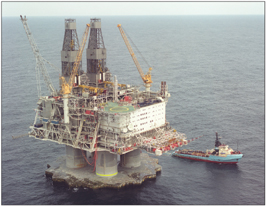
25 |  |
 | 26 |
ExxonMobil• 2011 Financial & Operating Review
Upstream: Worldwide Upstream Operations, continued
In 2007, ExxonMobil and Imperial Oil acquired interests in the EL 446 Block located in the Beaufort Sea (ExxonMobil interest, 50 percent; Imperial Oil interest, 50 percent). The block covers 500,000 acres and is 75 miles offshore. In 2010, ExxonMobil and Imperial Oil entered into a Joint Operating Agreement resulting in a 50-percent interest in EL 446 and an adjoining block, EL 449. The combined blocks cover approximately 1 million acres. Interpretation of 3D seismic data collected on EL 446 in 2008 and on EL 449 in 2009 is ongoing while plans for the first exploration well in this operationally challenging arctic area are progressing.
Onshore Canada Operations
The majority of ExxonMobil’s liquids production in western Canada is from heavy oil and oil sands, areas in which we are considered leaders in research to identify methods to improve efficiency and reduce environmental footprint.
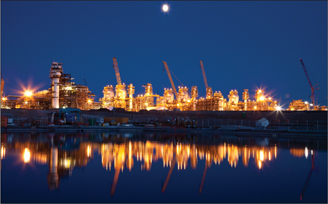
The Kearl oil sands project will develop more than 4 billion barrels of bitumen and will start up by year-end 2012.
In 2011, the Cold Lake heavy oil field in Alberta (Imperial Oil interest, 100 percent) achieved record production of 160 thousand barrels of oil per day. Cold Lake is the largest thermal in situ heavy oil project in the world. It has over 4000 wells directionally drilled from multiple satellite pads tied back to central facilities, which reduces surface land requirements. Cyclic steam stimulation is used to recover bitumen, and recovery is increased through the use of leading-edge thermal recovery technologies. Engineering is nearing completion and early construction work has commenced on the Nabiye project, the next expansion phase of Cold Lake. Steam injection will produce an additional 40 thousand barrels of bitumen per day at peak rate.
The Syncrude oil sands mining operation (Imperial Oil interest, 25 percent) produced synthetic crude averaging 290 thousand barrels per day in 2011.
The Kearl oil sands project (combined ExxonMobil and Imperial Oil interest, 100 percent) is developing a world-class resource in northern Alberta expected to exceed 4 billion barrels. Construction and fabrication activities are well-advanced on the Kearl Initial Development project with mining and extraction facilities scheduled for start-up by year-end 2012. Initial production will start at approximately 110 thousand barrels of bitumen per day with future debottlenecking and expansion increasing production to 345 thousand barrels of bitumen per day with full development. The Kearl Expansion project was sanctioned in 2011.
We also continue to evaluate oil sands acreage in the Athabasca region with the completion of core hole and seismic programs on both in situ and mining leases in 2011. ExxonMobil acquired an additional 12,000 acres of oil sands leasehold in 2011 through Imperial Oil.
The Mackenzie Gas project received regulatory approvals from the Canadian government in 2011. Once sanctioned, the project will develop three fields (ExxonMobil and Imperial Oil hold interests in two of the three fields) containing approximately 6 trillion cubic feet of natural gas and will deliver natural gas to
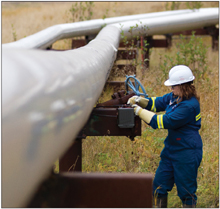
North American markets through a 740-mile pipeline system across the Mackenzie Valley.
Evaluation of our acreage in the Horn River Basin in northeast British Columbia continued with a five-well drilling program during the 2010-2011 winter drilling season (ExxonMobil interest, 50 percent; Imperial Oil interest, 50 percent). ExxonMobil and Imperial Oil currently hold 341,000 net acres and together are one of the largest landholders in the basin. Plans are progressing to drill two additional exploration wells during the 2011-2012 winter drilling season. We also drilled eight production pilot wells in 2011 that will be completed in 2012. Construction of facilities for the pilot is also under way with start-up planned for late 2012.
Cold Lake (Imperial Oil interest, 100 percent) achieved record production of 160 thousand barrels per day in 2011.
In 2011, ExxonMobil and Imperial Oil acquired a 100-percent interest in EL471 and EL472 in the Summit Creek Area of the Northwest Territories. These two blocks cover approximately 444,000 acres and are located near the Imperial Oil-operated Norman Wells field. Planning is currently under way to acquire additional seismic data and drill exploration wells. ExxonMobil and Imperial Oil acquired a 100-percent interest in an additional 56,000 acres in Alberta across a variety of plays. ExxonMobil also successfully tested and began production drilling in a Canadian tight oil play extension in western Alberta in 2011.
SOUTH AMERICA
Argentina
In Argentina, ExxonMobil holds a 51-percent interest in the Chihuidos concession and a 23-percent interest in the Aguarague concession. In 2011, we sold net daily gas production of 45 million cubic feet from these concessions into markets in Argentina.
ExxonMobil acquired an additional 636,000 net acres in the Neuquen Basin through joint ventures in 2011. With these acquisitions, we currently hold a total of 876,900 net acres in the basin. Exploration drilling to test unconventional gas and liquids potential on this acreage commenced in the fourth quarter of 2011.
Brazil
We hold a 40-percent interest in and operate Block BM-S-22, located in the pre-salt play of the Santos Basin offshore Brazil. BM-S-22 is a 342,000-acre deepwater block approximately 220 miles south of Rio de Janeiro.
Colombia
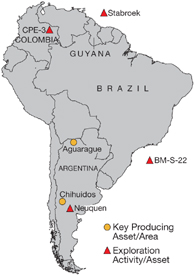
ExxonMobil holds a Technical Evaluation Agreement for Block CPE-3 onshore Colombia. The block is located in a remote and unexplored area of the eastern Llanos Basin on trend with the Orinoco heavy oil belt. Stratigraphic core hole drilling to evaluate the prospectivity of this large area commenced in the first quarter of 2012. 2D seismic data acquisition and additional core hole drilling are planned for 2012. If the initial program is successful, we will leverage our extensive global experience in heavy oil development to further evaluate and develop this potential resource.
Guyana
We have a 50-percent interest in and operate the Stabroek deepwater block (9.6 million acres) offshore Guyana. Interpretation of a newly acquired 2D seismic survey to evaluate prospectivity is under way. Additional 3D seismic acquisition is also planned.
Venezuela
The Cerro Negro and La Ceiba assets of ExxonMobil affiliates were expropriated without compensation by Venezuela on June 27, 2007. Prior to expropriation, ExxonMobil affiliates owned a 41.67-percent interest in Cerro Negro and a 50-percent interest in La Ceiba. ExxonMobil affiliates filed an arbitration against Venezuela with the International Centre for Settlement of Investment Disputes (ICSID) in September 2007. The ICSID arbitration is ongoing. An affiliate filed a related arbitration against Venezuela’s national oil company (PdVSA) and a PdVSA affiliate with the International Chamber of Commerce (ICC) in January
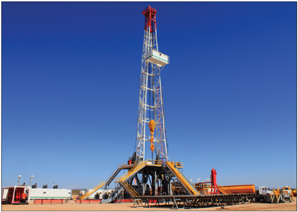
2008. The ICC issued a ruling in favor of ExxonMobil in late 2011, resulting in, among other things, a monetary award of approximately $908 million for PdVSA’s failure to comply with contractual terms. The tribunal deducted $161 million of uncontested debt owed to PdVSA, and the balance of the $747 million monetary portion of the award has been satisfied.
Exploration drilling to test unconventional gas and liquids in the Neuquen Basin, Argentina, commenced late 2011.
27 |  |
 | 28 |
ExxonMobil• 2011 Financial & Operating Review
Upstream: Worldwide Upstream Operations, continued
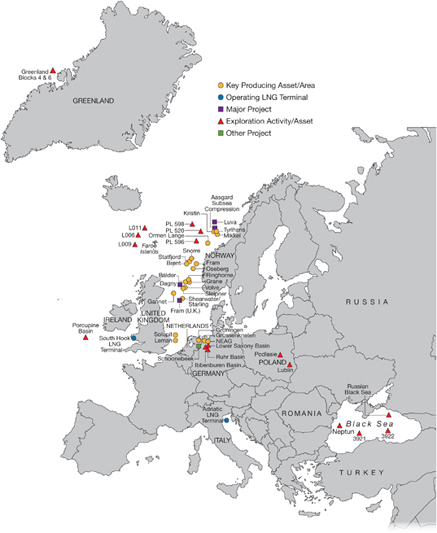
EUROPE
ExxonMobil is one of the largest producers of oil and gas in Europe. Key activities include North Sea oil and natural gas production and onshore natural gas production. In 2011, Europe accounted for 19 percent of ExxonMobil’s net oil and natural gas production and 21 percent of Upstream earnings.
We continue to progress exploration activities, development projects, and efforts to increase recovery from producing assets through work programs and the implementation of new technology. Frontier exploration activity is also under way. We participated in an exploration well in the Turkish sector of the Black Sea in 2011, and began drilling an exploration well in the Romanian sector of the Black Sea in late 2011. We also continued to progress the evaluation of significant unconventional natural gas and oil opportunities in Germany and Poland. Additionally, ExxonMobil operates liquefied natural gas (LNG) receiving terminals in the United Kingdom and Italy, which provide natural gas supply to the European market.
Norway
ExxonMobil is among the largest oil and gas producers in Norway with average net production of 205 thousand barrels of liquids per day and 663 million cubic feet of gas per day in 2011.
We operate producing fields in Norway including Ringhorne (ExxonMobil interest, 100 percent), Ringhorne East (ExxonMobil interest, 77 percent), and Balder (ExxonMobil interest, 100 percent), which are located 110 miles west of Stavanger. Since coming onstream in 2003, Ringhorne has produced over 200 million oil-equivalent barrels. In 2011, production averaged 39 thousand oil-equivalent barrels per day. We continued drilling operations from the Ringhorne platform in 2011, following a successful 4D seismic program in 2010. We plan to extend the 4D seismic coverage in 2012 to support continued Ringhorne drilling. A multiyear drilling program is also planned for the Balder field.
| Europe Highlights | 2011 | 2010 | 2009 | |||||||||
Earnings(billions of dollars) | 7.1 | 3.8 | 3.6 | |||||||||
Proved Reserves(BOEB) | 2.7 | 2.9 | 3.2 | |||||||||
Acreage(gross acres, million) | 44.1 | 43.1 | 35.2 | |||||||||
Net Liquids Production(MBD) | 0.3 | 0.3 | 0.4 | |||||||||
Net Gas Available for Sale(BCFD) | 3.4 | 3.8 | 3.7 | |||||||||
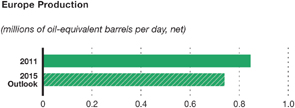
In addition, ExxonMobil is a partner in about 20 co-venturer-operated fields. There are active drilling programs in several core areas, with approximately 25 new wells drilled per year, as well as field extensions designed to fill available facility capacity as mature fields decline. Significant activities are taking place to progress new subsea technology with sanction of the Aasgard Subsea Compression (ASC) project in 2011 and advancement of a subsea compression pilot at Ormen Lange.
Conceptual engineering was completed in 2011 for the Dagny (ExxonMobil interest, 33 percent) and Luva (ExxonMobil interest, 15 percent) offshore development projects with front-end engineering design (FEED) planned in 2012 for both projects.
ExxonMobil participates in the ASC project (ExxonMobil interest, 13.5 percent) in the Aasgard area, which will maximize recovery from the Mikkel and Midgard fields by installing subsea compression near Midgard to maintain stable flow rates in the two flowlines. This project is in the execution phase and represents an industry first in the application of subsea compression.
In May 2011, we acquired a 35-percent-operated interest in the PL596 Møre Vest license, covering 787,000 acres, and a 30-percent interest in the PL598 Ygg High license, covering 409,000 acres in the Norwegian Sea. In both licenses, the primary objective is located beneath basalt that will require the application of specialized sub-basalt imaging technology to identify structures for future drilling. We acquired new ocean bottom cable seismic on PL596 in September 2011. Additional seismic programs are planned on both licenses during 2012. ExxonMobil is also the operator of PL520 (ExxonMobil interest, 50 percent) in the Norwegian Sea. The license covers 736,000 acres in water depths ranging from 4200 to 7800 feet. Processing of 3D seismic data acquired in 2010 continued during 2011. We will use this data to identify potential drilling opportunities.
United Kingdom
During 2011, we sold our interests in the Beryl field and associated subsea fields of Nevis, Ness, Buckland, and Skene (ExxonMobil interest, 50 percent) in the North Sea, the Scottish Area Gas Evacuation (SAGE) plant at St. Fergus and the associated Beryl/Brae gas pipeline, and the Benbecula exploration acreage west of Shetland to Apache. ExxonMobil continues to have significant equity participation in over 40 U.K. producing fields in the North Sea, principally through a Shell/Esso joint venture.
Conceptual engineering was completed and front-end engineering design commenced in 2011 for the Fram offshore development project (ExxonMobil interest, 72 percent; and 50 percent for two licenses currently under unitization).
The South Hook liquefied natural gas (LNG) regasification terminal (ExxonMobil interest, 24 percent) located in Milford Haven, Wales, reached full capacity in April 2010, achieving peak daily rates of 2 billion cubic feet. A total of 100 LNG cargoes were delivered during 2011, with 10.4 million tonnes of natural gas provided to the U.K. natural gas grid.
Germany
ExxonMobil is Germany’s largest natural gas producer with average net production of 518 million cubic feet per day in 2011. A total of 55 ExxonMobil-operated fields account for approximately 70 percent of all natural gas produced in the country. We continued a series of upgrades in 2011 to the large compressor stations used to maximize field production and resource recovery.
Our subsidiaries in Germany hold six exploration licenses in the states of Lower Saxony and North Rhine Westphalia. The licenses cover 3.2 million acres and include potential shale gas, tight liquids, and coal bed methane exploration plays. We operate these licenses with a 67-percent interest in five of the licenses, and a 100-percent interest in the sixth. Further exploration drilling is planned for 2012 to evaluate a number of unconventional play concepts.
In 2011, we employed three drilling rigs targeting conventional and unconventional opportunities in Lower Saxony, Germany.
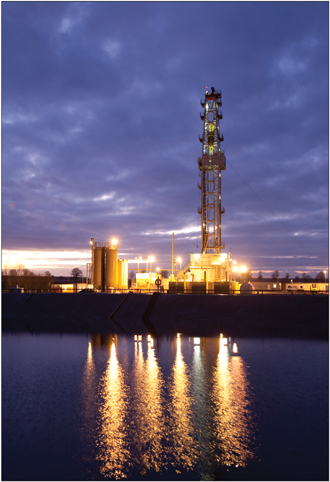
29 |  |
 | 30 |
ExxonMobil• 2011 Financial & Operating Review
Upstream: Worldwide Upstream Operations, continued
The Netherlands
ExxonMobil is one of the largest natural gas producers in the Netherlands, primarily through our shareholding in NAM (Nederlandse Aardolie Maatschappij), a 50-percent ExxonMobil equity company that produces gas from more than 100 fields located both onshore and offshore. Our net production in the Netherlands averaged 1.8 billion cubic feet of gas per day in 2011. The majority of this production comes from the Groningen field (ExxonMobil interest, 30 percent), which is Europe’s largest natural gas field.
NAM’s Schoonebeek Redevelopment project (ExxonMobil interest, 30 percent) came online in early 2011 and is expected to recover 120 million barrels of oil.
Italy
The Adriatic LNG Terminal (ExxonMobil interest, 71 percent) located 10 miles offshore of Porto Levante, Italy, in the northern Adriatic Sea, is the world’s first fixed offshore LNG storage and regasification terminal. The terminal has capacity to supply up to 775 million cubic feet of gas per day to the Italian market, approximately 10 percent of Italy’s natural gas demand. In 2011, 81 cargoes were delivered to the terminal totaling 5.5 million tonnes of LNG.
We sold our 25-percent interest in the Tempa Rossa joint venture and our 51.7-percent interest in the adjacent exploration licenses to Total in September 2011.
Other Europe
Faroe Islands • In March 2011, ExxonMobil acquired a 49-percent interest in license L006 and a 50-percent interest in licenses L009 and L011, covering 1.1 million acres. The Statoil-operated Brugdan-2 wildcat well on license L006 is planned for 2012.
Romania • We have a 50-percent interest in the 1.9 million-acre deepwater Neptun Block in the Black Sea. Processing of 3D seismic and other 2D seismic data continued during 2011 to identify potential drilling opportunities. Exploration drilling began in late 2011.
Ireland • ExxonMobil has interests in two exploration licenses (ExxonMobil interest in Dunquin, 27.5 percent; ExxonMobil interest in Cuchulain, 36 percent) covering almost 704,000 acres in the Porcupine Basin, located 125 miles off the southwest coast of Ireland. During 2011, we farmed out 12.5 percent of our equity in the Dunquin license to Repsol and relinquished interests in two other licenses, Drombeg and Drombeg Extension. Drilling is planned on the ExxonMobil-operated Dunquin license in 2013.
Turkey • ExxonMobil has interests in two licenses covering more than 15 million acres in the Turkish Black Sea in water depths ranging from 450 to 7250 feet. We operate the Kastamonu sub-block of license 3921 and the Samsun sub-block of license 3922 with a 50-percent interest. We also have a 25-percent interest in each of the Sinop, Ayancik, and Carsamba sub-blocks of the Petrobras-operated license 3922. The ExxonMobil-operated Kastamonu-1 wildcat was the first well drilled on license 3921 and was plugged and abandoned in 2011.
Poland • We have an interest in six licenses in the Podlasie and Lublin Basins of eastern Poland covering approximately 1.6 million acres (100-percent interest in the four Podlasie licenses and a 51-percent interest in the two Lublin licenses following a farm-out of 49 percent of our equity to Total in 2011). We acquired and processed a program of 2D and 3D seismic during 2011. The ExxonMobil-operated Krupe-1 and Siennica-1 shale gas wildcat wells were drilled in 2011.
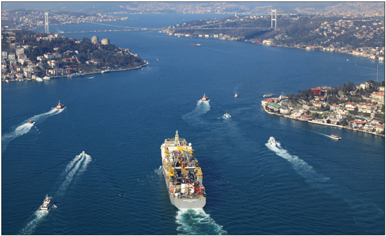
Greenland• In the West Disko area offshore western Greenland, we have interests in Block 6 (ExxonMobil interest, 44 percent) and Block 4 (ExxonMobil interest, 29 percent) totaling 6.7 million acres. Geological evaluation and environmental activities continued on these blocks in 2011.
Deepwater Champion drillship passing through the Bosporus Strait on its way to drill ExxonMobil’s first well in the Turkish Black Sea.
AFRICA
ExxonMobil is one of the leading oil producers in Africa. Our operations in Africa accounted for 11 percent of our 2011 net oil and natural gas production and 16 percent of total Upstream earnings. In addition to producing activities, we have ongoing exploration activities. ExxonMobil holds interests in 23 deepwater blocks offshore Africa totaling almost 14 million acres.
Angola
We have interests in four deepwater blocks covering 2.7 million acres in Angola. ExxonMobil and our co-venturers have announced a total of 63 discoveries in Angola, providing world-class development opportunities with a recoverable resource potential of approximately 14 billion oil-equivalent barrels. Including production from the co-venturer-operated Block 17, our net production in Angola averaged 99 thousand barrels of oil per day in 2011 with several new projects under construction or at the development planning stage.
Block 15 • We were awarded an interest in Block 15 in 1994 (ExxonMobil interest, 40 percent), and to date, have discovered total resources of approximately

5 billion oil-equivalent barrels on the block. The Xikomba field started production in November 2003, followed by start-ups of Kizomba A in 2004, Kizomba B in 2005, and Kizomba C in 2008. Production from the depleted Xikomba field ended in 2011, and all FPSO production facilities were cleaned and abandoned. With daily output of more than 440 thousand barrels of oil, Block 15 was Angola’s second-highest-producing block during the year, and facilities continue to operate with very high levels of reliability.
Additional Block 15 developments continue to progress in 2011, including the Gas Gathering and Kizomba Satellites projects. The Gas Gathering project initiated supply of Block 15 gas to the Angola LNG facility in Soyo. Execution activities are progressing on the Kizomba Satellites Phase 1 project that will include subsea tiebacks to the Kizomba A and B floating production, storage, and offloading (FPSO) vessels. The project is expected to recover nearly 250 million barrels of oil and is anticipated to start production in 2012. Through collaborative development efforts, we continue to utilize the local workforce to enhance Angolan industrial capabilities and competitiveness. Development planning continues for several of the remaining discovered resources on Block 15, including Kizomba Satellites Phase 2 and the 2009 Mondo South discovery.
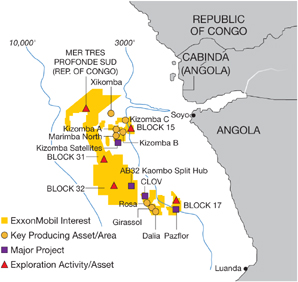
| Africa Highlights | 2011 | 2010 | 2009 | |||||||||
Earnings(billions of dollars) | 5.4 | 4.4 | 3.9 | |||||||||
Proved Reserves(BOEB) | 1.8 | 2.0 | 2.1 | |||||||||
Acreage(gross acres, million) | 15.1 | 16.5 | 17.7 | |||||||||
Net Liquids Production(MBD) | 0.5 | 0.6 | 0.7 | |||||||||
Net Gas Available for Sale(BCFD) | – | – | – | |||||||||
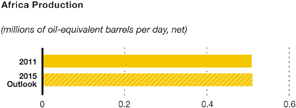
31 |  |
 | 32 |
ExxonMobil• 2011 Financial & Operating Review
Upstream: Worldwide Upstream Operations, continued
Block 17• ExxonMobil has a 20-percent interest in Block 17, where oil was first discovered in 1996. Through year-end 2011,15 discoveries have occurred on the block with a recoverable resource potential of approximately 6 billion oil-equivalent barrels. During 2011, production averaged about 490 thousand barrels of oil per day from the Girassol, Dalia, Rosa, and Pazflor projects.
The Pazflor project (ExxonMobil interest, 20 percent) started up in August 2011. Pazflor is located 100 miles offshore in 2600 feet of water and utilizes a floating production, storage, and
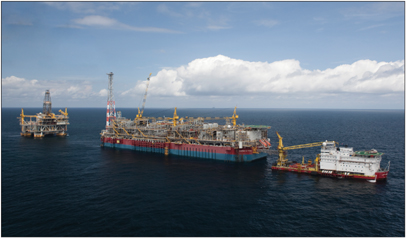
The Kizomba Satellites project in Angola is expected to start production in 2012.
offloading (FPSO) vessel to produce up to 220 thousand barrels of oil per day. The next development within Block 17 is Cravo-Lirio-Orquidea-Violeta (CLOV) (ExxonMobil interest, 20 percent), which was sanctioned by the co-venturers in 2010. Project execution activities for CLOV continued in 2011. CLOV is located in 4100 feet of water and will use an FPSO vessel to produce 160 thousand barrels of oil per day. The Tulipa-2 exploration well commenced drilling in October 2011 and is targeting resources to support future development plans.
Block 31• We were awarded a 25-percent interest in Block 31 in 1999, and the first discovery on the block occurred in 2002. Through year-end 2011,19 discoveries have been announced with a total resource of approximately 2 billion oil-equivalent barrels. The first development on the block is the Plutao-Saturno-Venus-Marte (PSVM) hub located in the northern part of the block in water depths ranging from 5900 to 6700 feet. A 150-thousand-barrel-per-day FPSO vessel conversion is under construction to produce an estimated 490 million barrels of oil. Planning is progressing for development of an additional hub in the southeastern and central parts of the block. As part of our portfolio optimization efforts, ExxonMobil is advancing the sale of our equity interest in Block 31.
Block 32• Development planning activities continue for Block 32 where ExxonMobil owns a 15-percent interest. Through year-end 2011,12 discoveries have been announced with a total resource of approximately 1.4 billion oil-equivalent barrels on the block. The first FPSO vessel development planned for Block 32 is the Kaombo Split Hub in the southeastern part of the block, with estimated recovery of about
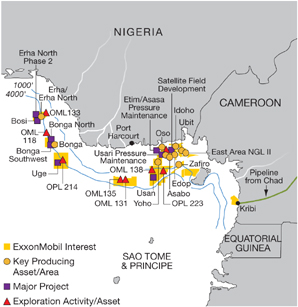
560 million barrels of oil. The water depths on this block range from 4700 to 5600 feet. An appraisal well was drilled in 2011 with additional appraisal drilling planned for 2012.
Nigeria
ExxonMobil continues to produce and develop interests offshore Nigeria both in shallow and deepwater acreage. We operate a shallow water joint venture with the Nigerian National Petroleum Corporation (NNPC) offshore southeastern Nigeria (ExxonMobil interest, 40 percent for crude and condensate; 51 percent for natural gas liquids) and the deepwater Erha and Erha North fields (ExxonMobil interest, 56 percent). ExxonMobil also produces from the co-venturer-operated Bonga and Amenam/Kpono fields, as well as the Usan development, which is expected to come online in early 2012. Development drilling and project activities using Nigeria’s expanding capabilities are under way to further develop our interests. In 2011, net production in Nigeria averaged 324 thousand barrels of liquids per day.
Nigeria – Deepwater
Erha/Erha North • The Erha development (ExxonMobil interest, 56 percent) is located 60 miles offshore in 3900 feet of water. Erha and Erha North, ExxonMobil’s first operated deepwater production in Nigeria, started in 2006. The development consists of more than 30 subsea wells tied back to a floating production, storage, and offloading (FPSO) vessel, with a capacity in excess of 200 thousand barrels per day.
The Erha North Phase 2 project (ExxonMobil interest, 56 percent) is a subsea tieback to the existing Erha FPSO vessel. The project will further develop the currently producing Erha North field, with a peak production rate of approximately 60 thousand barrels of oil per day. Engineering, procurement, and construction (EPC) contracting for the project is progressing.
Bosi • The Bosi development (ExxonMobil interest, 56 percent) is planned as a spread-moored FPSO vessel with associated subsea developments. The Bosi project phases are expected to develop approximately 500 million barrels of oil and up to 2.5 trillion cubic feet of natural gas. Project concept selection activities are progressing in participation with the Nigerian government and co-venture partner, Shell.
Bonga Northwest • Bonga Northwest (ExxonMobil interest, 20 percent) is planned as a subsea tieback to the existing Bonga FPSO vessel, which began production from the Bonga field in 2005. Project execution activities continue on Bonga Northwest, which is expected to develop approximately 125 million barrels of oil.
Bonga North • The Bonga North development (ExxonMobil interest, 20 percent) is planned as multiple subsea wells tied back to an FPSO vessel. Front-end engineering and design continues on the Bonga North subsea architecture. It is anticipated that this project will develop more than 350 million barrels of oil.
Bonga Southwest • The Bonga Southwest project (ExxonMobil interest, 16 percent) is planned as an FPSO vessel development with a dedicated gas export pipeline. The project is anticipated to develop more than 800 million barrels of oil.
Usan • Project execution continues on the Usan project (ExxonMobil interest, 30 percent) located 60 miles offshore Nigeria in 2500 feet of water. Full development, including future phases, is designed to recover up to 500 million barrels of oil using subsea wells connected to a 180-thousand-barrel-per-day capacity FPSO vessel. Major contracts were awarded in early 2008, and development drilling and offshore installation were progressed in 2011. Start-up is expected in early 2012.
OPL 223 • Following the Owowo South-1 discovery in 2009, we entered into the second exploration phase in OPL 223 (ExxonMobil interest, 27 percent) beginning in July 2010. Exploration drilling is planned for 2012.
OPL 214 • We were awarded operatorship of OPL 214 in 2001 (ExxonMobil interest, 20 percent) and discovered the Uge field in 2005. Development planning for Uge continues. Phase III exploration drilling commenced in late 2011 and will continue through early 2012 before conversion to an oil mining license (OML) in 2012.
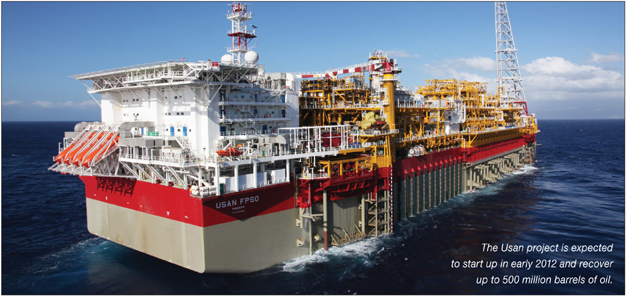
33 |  |
 | 34 |
ExxonMobil• 2011 Financial & Operating Review
Upstream: Worldwide Upstream Operations, continued
Nigeria Shelf – Joint Venture
ExxonMobil’s portfolio on the Nigerian shelf includes 69 fields. We have ongoing activities to increase liquids volumes, including an active development drilling program, installation of new platforms, enhanced oil recovery projects, and a series of platform upgrades. In addition, seismic and exploration activities continue in an effort to identify new opportunities within the joint venture.
Ocean bottom cable seismic data were acquired in 2010, and additional seismic acquisition is planned for 2013. Joint venture exploration drilling is also planned.
Natural Gas Liquids• Natural gas liquids plants along with pressure maintenance projects significantly reduce flaring and greenhouse gas emissions while improving oil recovery through reservoir pressure maintenance. Production of natural gas liquids began in 1998 with the OSO Natural Gas Liquids project and grew in 2008 with the East Area Natural Gas Liquids II project (ExxonMobil interest, 51 percent). Production from these two projects averaged 34 thousand barrels per day in 2011. The projects are expected to recover about 400 million barrels of natural gas liquids. In addition, they have contributed to a 70-percent reduction in flaring since 2007.
Satellite Field Development• Execution of ExxonMobil’s “design one, build multiple” approach for the Satellite Field Development project (ExxonMobil interest, 40 percent) is progressing. Phase 1 is under way with installation of three platforms currently planned for 2012. These additional offshore facilities will allow drilling in undeveloped areas of the joint venture and provide pipeline connections back to existing infrastructure. Peak production from Phase 1 is anticipated to reach 70 thousand barrels of liquids per day.
Domestic Power Generation and Natural Gas Supply• In 2011, ExxonMobil completed front-end engineering and design work for a joint venture project to construct a 500-megawatt power plant. The project is a component of an integrated plan to increase gas utilization and power generation capacity in Nigeria. In addition, the joint venture is constructing new facilities that will allow for delivery of natural gas to Nigeria’s domestic market.
Equatorial Guinea
ExxonMobil operates the Zafiro field in Equatorial Guinea (ExxonMobil interest, 71 percent) in water depths between 400 and 2800 feet. In 2011, net production averaged 45 thousand barrels of oil per day. A successful multiyear drilling program came to an end in 2011 with the addition of more than 25 million barrels of reserves. We continue to progress discussions with the government of Equatorial Guinea on projects aimed at enabling a reduction in flaring and the development of Zafiro gas resources. 2011 represented the 15th year of production from the Zafiro field during which more than 800 million barrels have been produced.
Chad
ExxonMobil began production in 2003 and is the leading oil producer in Chad (ExxonMobil interest, 40 percent), with average net production of 40 thousand barrels of oil per day in 2011. An active two-rig development drilling program continued in 2011, focused on the Kome, Bolobo, and Miandoum fields.
Other Africa
Republic of Congo• Through year-end 2011, five discoveries were announced in the Mer Tres Profonde Sud block (ExxonMobil interest, 30 percent) with a total resource of approximately 400 million oil-equivalent barrels. Additional exploration activity is planned in 2012.
Madagascar• ExxonMobil holds an interest in approximately 1.8 million acres in the Majunga Basin offshore Madagascar. We continue to closely monitor political developments in Madagascar, with exploration activities and drilling operations currently suspended.
Libya• We relinquished our interest in Contract Area 44 in Libya in November 2010. We also concluded studies in Contract Areas 20 and 21.
Tanzania• ExxonMobil entered Tanzania in 2010 by acquiring a 35-percent working interest in deepwater Block 2. A 3D seismic survey, acquired in 2010, is being interpreted to identify potential drilling prospects. The Zafarani-1 exploration well started drilling in January 2012 and, if successful, may result in the drilling of a second exploration well, Lavani-1.
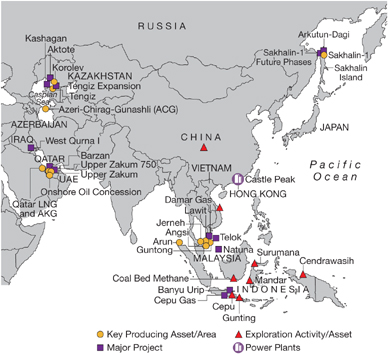
ASIA
In Asia, ExxonMobil is participating in the development of some of the world’s largest oil and gas prospects. Our production grew significantly in 2011 with the continued ramp-up of the Qatar projects. Overall, ExxonMobil operations in the Asia region contributed 37 percent to our net oil and gas production and 39 percent to Upstream earnings.
Qatar
Through the Qatar joint ventures, Qatar Petroleum and ExxonMobil continue to develop the North Field, the largest non-associated gas field in the world. These efforts will develop resources exceeding 25 billion oil-equivalent barrels through a suite of projects. ExxonMobil participates in all seven of the RasGas liquefied natural gas (LNG) trains and in five of the Qatargas LNG trains (ExxonMobil interest ranges from 10 to 34 percent). LNG production from ExxonMobil-interest trains in Qatar was 62 million tonnes in 2011. The Al Khaleej Gas facilities produced about 1.7 billion cubic feet per day in 2011, providing supplies primarily to the domestic market. ExxonMobil is also participating in the Barzan Gas project, which is expected to supply 1.4 billion cubic feet per day to the Qatar gas market.
Qatargas• We participate in the Qatargas 1 and Qatargas 2 joint ventures with interests ranging from 10 to 30 percent. Qatargas 1 consists of three trains with a total nominal capacity of 9.9 million tonnes per year, delivering LNG primarily to Japan and Spain. Qatargas 2, which started up in 2009, consists of two 7.8-million-tonne-per-year trains. These operations also produce associated products including condensate, liquefied petroleum gas (LPG), helium, and sulfur. Deliveries of LNG from Qatargas 2 utilize a fleet of Q-Flex and Q-Max vessels, the world’s largest LNG carriers. Shipments are delivered primarily to the United Kingdom through the South Hook LNG Terminal.
RasGas• RasGas is a joint operating company comprised of Qatar Petroleum and ExxonMobil, with 70-percent and 30-percent interests, respectively. The 7.8-million-tonne-per-year Train 7 started up in 2010, increasing total RasGas LNG production capacity to 36 million tonnes per year. LNG from the seven trains is primarily sold to the Asian and European markets. In addition to LNG, RasGas also produces considerable amounts of associated products including condensate, liquefied petroleum gas, helium, and sulfur.
| Asia Highlights | 2011 | 2010 | 2009 | |||||||||
Earnings(billions of dollars) | 13.4 | 9.4 | 5.2 | |||||||||
Proved Reserves(BOEB) | 8.1 | 8.6 | 9.1 | |||||||||
Acreage (gross acres, million) | 31.0 | 31.4 | 32.9 | |||||||||
Net Liquids Production(MBD) | 0.8 | 0.7 | 0.6 | |||||||||
Net Gas Available for Sale(BCFD) | 5.0 | 4.8 | 3.3 | |||||||||
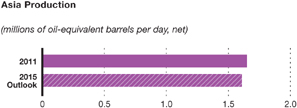
Al Khaleej Gas• The Al Khaleej Gas Phase 1 and 2 project facilities help meet the growing domestic demand in Qatar. The first phase started up in 2005 (ExxonMobil interest, 100 percent), and the second phase started up in 2009 (ExxonMobil interest, 80 percent). The combined capacity of these facilities is 2 billion cubic feet per day. Natural gas liquids recovery, including ethane sales to the domestic market, started up in 2010.
Common Facilities• RasGas and Qatargas participate in a range of common facilities for the storage and loading of LNG, condensate, liquefied petroleum gas, and sulfur on behalf of the Ras Laffan Industrial City joint venture companies. The utilization of shared facilities enables each participant to benefit from significant economies of scale.
35 |  |
 | 36 |
ExxonMobil• 2011 Financial & Operating Review
Upstream: Worldwide Upstream Operations, continued
Barzan• In 2007, Qatar Petroleum and ExxonMobil signed a Heads of Agreement (HOA) to jointly develop the Barzan project. In January 2011, a joint venture agreement, along with development and fiscal agreements, was signed for the initial phase of the project. This phase will supply up to 1.4 billion cubic feet per day of domestic natural gas to meet demand driven by Qatar’s rapidly growing infrastructure and industry requirements. Detailed engineering and early onshore construction activities are progressing. Early offshore development drilling is also under way.
United Arab Emirates
ExxonMobil holds two oil concessions in the United Arab Emirates. In 2011, net production from the onshore oil concession was 127 thousand barrels of oil per day. Net production from the Upper Zakum offshore concession was 151 thousand barrels of oil per day.
With our ability to deliver superior technology and project execution excellence, we gained entry into Upper Zakum (ExxonMobil interest, 28 percent) in 2006. Upper Zakum is one of the world’s largest oil fields, with an initial resource estimate of approximately 50 billion barrels of oil. The offshore Upper Zakum field covers more than 450 square miles and has production capacity of more than 550 thousand barrels per day. Along with our partners in the joint venture, we are applying leading-edge technology that will boost daily field production capacity by an additional 200 thousand barrels per day. Construction is under way on artificial islands that will utilize extended-reach drilling to help increase recovery at a lower cost. Front-end engineering and design activities are complete, and contracting activities are progressing.
Iraq
ExxonMobil signed agreements with the South Oil Company (SOC) of the Iraqi Ministry of Oil in 2010 to redevelop and expand production from the West Qurna I oil field in southern Iraq (ExxonMobil interest, 60 percent) and to develop additional discovered but undeveloped reservoirs within the contract area. Located in one of Iraq’s most prolific producing areas, field redevelopment and expansion will entail extensive infill drilling, reservoir pressure support, new production facilities, and associated support infrastructure. Our project execution experience and global procurement network will play a critical part in maximizing the value of this resource.
Since signing the agreements, we established offices in both Baghdad and Basra and awarded contracts for engineering services, drilling, workovers, power, and water. The West Qurna I project achieved the Initial Production Target in April 2011, representing a 10-percent increase in production and triggering cost recovery. At year-end 2011, production from the West Qurna I field was about 370 thousand gross barrels per day, representing an increase of over 50 percent since the contract was awarded.
ExxonMobil also led a group of international oil and Iraqi state companies in the study of the development of a large seawater supply facility on the Iraqi coast of the Arabian Gulf. This facility would supply seawater for pressure support for West Qurna I as well as most of the other large oil fields in southern Iraq. We are working with the Iraq Ministry of Oil, SOC, and other international oil company participants to establish the commercial and technical basis for this project.
In addition, in October 2011, we signed six production sharing contracts (PSC) (ExxonMobil interest, 100 percent) covering 848,000 gross acres in the Kurdistan Region of Iraq.
The West Qurna I project in Iraq achieved its Initial Production Target in April 2011.

Russia
ExxonMobil operates and holds a 30-percent interest in the Sakhalin-1 project, which comprises the Chayvo, Odoptu, and Arkutun-Dagi fields. The Sakhalin-1 project, which is being developed in phases, is one of the largest foreign investments in Russia.
Sakhalin-1 Chayvo and Odoptu• Oil production and gas sales to far east Russia commenced from the initial development phase of the Chayvo field in 2005. Exports of crude oil to international markets from the De-Kastri terminal started in 2006.
Production from the Odoptu field commenced in 2010. The Odoptu development utilized the Yastreb rig, one of the world’s most powerful land-based rigs, to drill nine extended-reach wells with a reach of up to 7.1 miles offshore.
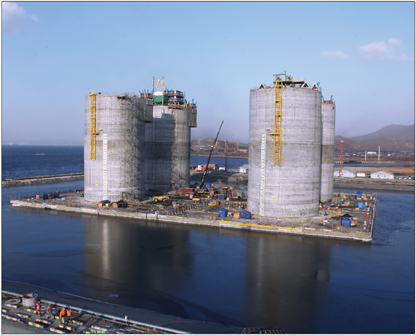
We achieved mechanical completion of the Arkutun-Dagi offshore platform concrete gravity-based substructure (GBS) in December in far east Russia.
Daily production from Chayvo and Odoptu averaged 163 thousand barrels of oil and 164 million cubic feet of natural gas in 2011. Since the initial start-up of Sakhalin-1 in 2005, almost 340 million barrels of oil have been produced and exported to world markets.
Sakhalin-1 Arkutun-Dagi•The project phase to develop the Arkutun-Dagi field is advancing fabrication and installation activities. Fabrication of the offshore concrete gravity-based substructure (GBS) achieved mechanical completion in December in far east Russia, and fabrication of the platform topsides is now under way in South Korea. Installation of the offshore pipelines has also commenced.
Sakhalin-1 Future Phases• Supported by a HOA signed with China National Petroleum Corporation (CNPC) in 2006, ExxonMobil continues to work toward gas pipeline sales from Sakhalin-1 to China. We are also evaluating other regional gas sales options, including sales to domestic gas markets.
Azerbaijan
ExxonMobil has an interest in the Azeri-Chirag-Gunashli (ACG) megafield (ExxonMobil interest, 8 percent). Since initial start-up in 1997, over 1.9 billion barrels of oil have been produced. In 2011, the ACG field achieved oil production rates in excess of 800 thousand barrels per day. Development of a sixth platform, which will contribute an additional 115 thousand barrels per day to existing volumes, continued in 2011.
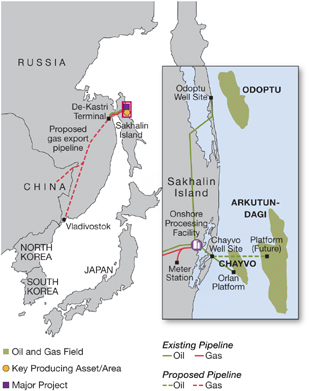
37 |  |
 | 38 |
ExxonMobil• 2011 Financial & Operating Review
Upstream: Worldwide Upstream Operations, continued
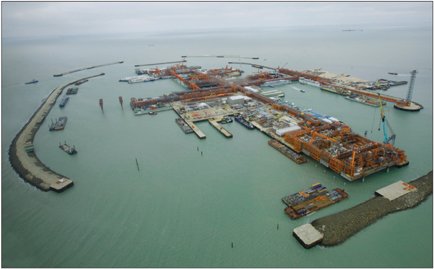
The Kashagan project facilities are 95 percent complete, and drilling is progressing
according to plan.
according to plan.
Kazakhstan
Tengiz•ExxonMobil participates in the Tengizchevroil (TCO) joint venture (ExxonMobil interest, 25 percent), which includes a production license area encompassing the super giant Tengiz field, an associated processing plant complex, and the nearby Korolev field. TCO holds a total of 380,000 acres. The Tengiz field has produced more than 1.8 billion barrels of oil from a total resource of nearly 6 billion barrels. In 2011, TCO achieved new record production rates in excess of 635 thousand barrels of oil per day. The TCO joint venture continues to invest in projects to improve the reliability and integrity of existing facilities. TCO is progressing a project to extend current production rates as reservoir pressure declines and is also considering the potential for a major expansion project.
Kashagan• As a participant in the North Caspian Production Sharing Agreement (ExxonMobil interest, 17 percent), we are working with consortium members to progress phased development of the massive Kashagan field located offshore in the Caspian Sea. Phase 1 includes an offshore production and separation hub on an artificial island, several drilling islands, and an onshore processing plant. The facilities for commercial production are 95 percent complete, and drilling is progressing according to plan. Plans for future phases are under evaluation.
Caspian Pipeline Consortium•The Caspian Pipeline Consortium (ExxonMobil interest, 7.5 percent), broke ground on an expansion project that will increase system capacity from 0.6 to 1.4 million barrels per day and will run from Kazakhstan to the Novorossiysk marine terminal on the Russian Black Sea coast. Construction is under way with expansion capacity being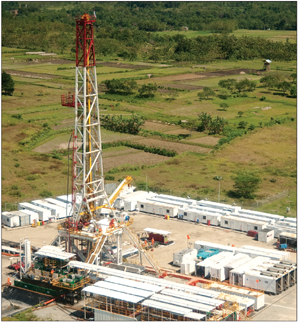 delivered in phases from the beginning of 2013 through 2015. This pipeline system represents the lowest-cost export option for Kazakhstan, with both Tengizchevroil and future Kashagan developments as major shippers.
delivered in phases from the beginning of 2013 through 2015. This pipeline system represents the lowest-cost export option for Kazakhstan, with both Tengizchevroil and future Kashagan developments as major shippers.

Indonesia
ExxonMobil operates the onshore Arun and Arun satellite fields and the North Sumatra offshore field that supply natural gas to the PT Arun LNG plant. In 2011, net production from these fields averaged 164 million cubic feet of gas per day and 1.7 thousand barrels of associated liquids per day.
In 2009, early oil production facilities were brought online for the Banyu Urip development in the Cepu Contract Area, onshore Java (ExxonMobil interest, 45 percent). Production through the early oil facility averaged 21 thousand barrels per day in 2011. Full field development is progressing and
In Indonesia, we continued exploration drilling in the Cepu Contract Area and made two discoveries in 2011.
will produce 165 thousand barrels of oil per day and include 49 wells, an onshore central processing facility, and a 60-mile pipeline that will transport oil to a floating storage and offloading vessel. All engineering, procurement, and construction (EPC) contracts were awarded in 2011. We also made two discoveries in the Cepu block in 2011. The Alas Tua West-1 well discovered gas and the Kedung Keris-1 well discovered a 561-foot oil column. Additional Cepu exploration drilling is planned for 2012.
In August 2011, we signed a Heads of Agreement (HOA) with Pertamina that included principles for unitization of the Jambaran and Tiung Biru gas fields and the appointment of PT Pertamina EP Cepu as the operator of the Jambaran-Tiung Biru unit. The Cepu producers are working to optimize the development and commercialization of gas resources from the Cepu block and support Indonesia’s priorities to meet domestic energy needs.
In 2008, ExxonMobil submitted a Plan of Development to the government of Indonesia and communicated intention to enter the next phase of development for the large offshore gas field within the Natuna D-Alpha PSC, which contains more than 70 percent carbon dioxide. Development activities commenced in 2009, and technical activities continue.
On December 3, 2010, ExxonMobil and Pertamina signed a Heads of Agreement (HOA) that provides the basis for negotiating a new East Natuna Area Production Sharing Contract (PSC) and Joint Operating Agreement (JOA). Following the HOA, ExxonMobil, Pertamina, Total, and Petronas signed a Principles of Agreement (POA) on August 19, 2011. The POA tabled key terms, working area, and a schedule to negotiate a new PSC. Negotiations are progressing toward completion of a new PSC.
Exploration drilling commenced in early 2011 to test coal bed methane potential in the Barito Basin in Kalimantan (ExxonMobil interest, 49 percent). Five wells were drilled by year end, and exploration evaluation will continue in 2012.
Work also continued on the deepwater Cendrawasih block offshore West Papua, with collection and processing of an aeromagnetic survey. Drop cores were also collected in late 2011 as studies continue for a potential wildcat well in 2013.
Malaysia
ExxonMobil operates 43 platforms in 17 fields as one of Malaysia’s major suppliers of crude oil and natural gas. Net production in 2011 averaged 38 thousand barrels of liquids per day and 420 million cubic feet of gas per day.
During 2011, design work was completed for the Tapis field Enhanced Oil Recovery and Telok Gas projects, and fabrication of associated offshore facilities commenced. In addition, we continued with development planning work on both the Guntong field Enhanced Oil Recovery and Damar Gas projects. The Damar Gas project along with the Telok Gas project will provide additional gas supplies for Malaysia’s power and industrial needs.
Other Asia
Philippines•We exited the deepwater SC-56 block after completing evaluation of the 2009-2010 exploration drilling results, which were deemed to be noncommercial.
Vietnam•ExxonMobil drilled two wells offshore Da Nang in 2011. The first well did not encounter hydrocarbons. The second well encountered hydrocarbons, and we are currently evaluating the results to determine next steps.
China•In July 2011, ExxonMobil signed a Joint Study Agreement covering 3640 square kilometers in the Sichuan Basin. Studies are progressing together with Sinopec to evaluate shale gas potential on the block.
The West Aquarius rig drilled two wells offshore Vietnam in 2011.
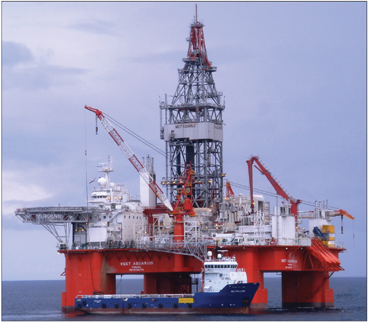
39 |  |
 | 40 |
ExxonMobil• 2011 Financial & Operating Review
Upstream: Worldwide Upstream Operations, continued
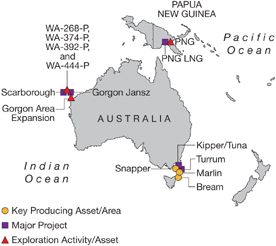
AUSTRALIA/OCEANIA
ExxonMobil is a leading oil and gas producer in the Australia/Oceania region. In 2011, net production averaged 51 thousand barrels of liquids and 331 million cubic feet of gas per day. The majority of our current production in the region is from the offshore Gippsland Basin in Australia. Future volume contribution from this region is anticipated to grow with the start-up of the Papua New Guinea (PNG) and Gorgon Jansz liquefied natural gas (LNG) projects.
Australia
The Kipper Tuna and Turrum projects are new developments in the Gippsland Basin (ExxonMobil interest, Kipper 32.5 percent, Tuna and Turrum 50 percent) consisting of installation of an additional offshore platform (Marlin B) and a subsea tie back to existing facilities. During 2011, significant progress was made in the offshore installation phase of the projects with the laying of all subsea equipment and pipelines and the setting of the Marlin B jacket.
Execution activities continued on the 15-million-tonne-per-year Gorgon Jansz LNG project (ExxonMobil interest, 25 percent), which will develop 25 trillion cubic feet of offshore gas resources. The development consists of a subsea infrastructure for offshore production and transportation of the gas, three 5-million-tonne-per-year LNG trains, and a 280-million-cubic-feet-per-day domestic gas plant located on Barrow Island, as well as the world’s largest carbon dioxide sequestration project. The project is well under way with significant progress made on Barrow Island to prepare the LNG facility site. Construction of LNG equipment modules and structures is also under way in South Korea, China, and Indonesia. Other project activities are progressing as well, including offshore drilling of the Gorgon wells, offshore pipeline construction, and construction of subsea production equipment in the United Kingdom.
ExxonMobil, as work operator for Jansz-lo drilling and completion, is finalizing detailed engineering and operations planning for the Jansz-lo field development. The gas will be produced via one of the world’s longest subsea tiebacks, located in 4300 feet of water. The first Gorgon Jansz LNG shipment is targeted for late 2014.
In 2011, we participated in an appraisal drilling program in the Greater Gorgon area aimed at maturing additional gas resources for a potential expansion of the Gorgon project. Appraisal wells were drilled on the Orthrus, Chandon, Chrysaor, and West Tryal Rocks fields.
Development and execution planning continues for the Scarborough LNG project (ExxonMobil interest, 50 percent). The field is located offshore western Australia in 3100 feet of water and has a resource of up to 10 trillion cubic feet of gas.
| Australia/Oceania Highlights | 2011 | 2010 | 2009 | |||||||
Earnings(billions of dollars) | 0.8 | 0.6 | 0.6 | |||||||
Proved Reserves(BOEB) | 1.5 | 1.5 | 1.5 | |||||||
Acreage(gross acres, million) | 7.8 | 7.1 | 11.7 | |||||||
Net Liquids Production(MBD) | 0.1 | 0.1 | 0.1 | |||||||
Net Gas Available for Sale(BCFD) | 0.3 | 0.3 | 0.3 | |||||||
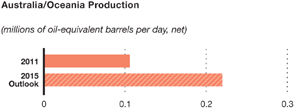
During 2011, significant progress was made on the kipper Tuna and Turrum projects in the Gippsland Basin, offshore Australlia.
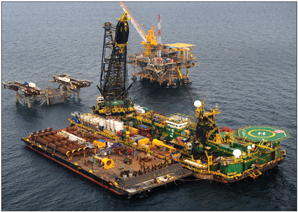
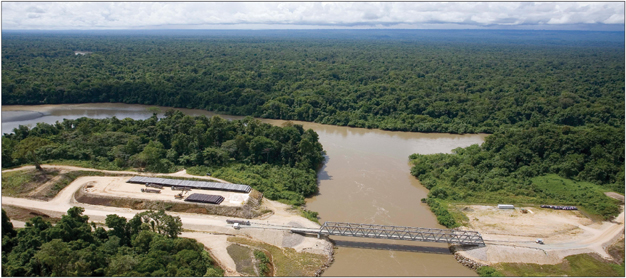
The newly constructed 435-foot Mubi River bridge is the longest of its type in Papua New Guinea and provides access from the lowlands in the south to the highlands in the north.
In 2011, ExxonMobil participated in three wells on the Northwest Shelf (ExxonMobil interest, 25 percent). Orthrus Deep encountered gas in untested intervals below the existing Orthrus discovery on retention lease WA-24-R. The Zagreus wildcat on WA-40-L near the Jansz-lo field did not encounter hydrocarbons. The third well in the 2011 program, Satyr-3, started drilling in December 2011 and is a follow-up to the successful 2009 Satyr-1 discovery well located in WA-374-P. Additional wildcats are planned for 2012.
Papua New Guinea
In 2011, ExxonMobil’s net production from Papua New Guinea averaged 6 thousand barrels of oil per day and 4 million cubic feet per day of gas.
The Papua New Guinea (PNG) liquefied natural gas (LNG) project (ExxonMobil interest, 33 percent) is progressing toward a 2014 start-up. Following site preparations and road and infrastructure development over the past year, the project celebrated the first weld on the 430-mile onshore/offshore gas pipeline and completed shipping and offloading of 40,000 sections of pipe. The sections will be used in the construction of the 180-mile onshore portion of the gas pipeline. The first drilling rig was also completed and shipped to PNG in 2011. Construction of the LNG plant process train pipe racks, storage tanks, foundations, and jetty are all under way.
As part of the project, ExxonMobil continues to grow our Papua New Guinean project workforce. At year-end 2011, the project workforce exceeded 14,000. More than 60 percent of the workforce are Papua New Guinean citizens.
The expertise of Papua New Guinean workers is being developed through dedicated facilities such as the Port Moresby Construction Training Facility. To date, ExxonMobil and our contractors have trained more than 6000 Papua New Guinean citizens for construction, support, and future production roles. This equates to more than 900,000 hours of training as of the end of 2011.
Support for developing Landowner Companies (Lancos) continues, with the assistance of business development officers in the field, the Enterprise Centre, and project contractors. Project-related spending with Lancos by year-end 2011 was approximately $300 million. Papua New Guinean businesses other than Lancos are also providing goods and services to the project. The project’s total in-country spend to date was close to $1.7 billion. The Enterprise Centre, established in partnership with the PNG Institute of Banking and Business Management, celebrated its first anniversary in 2011. The Centre has supported 10,000 Papua New Guinean businesses and achieved more than 3750 days of training in an effort to foster supplier development for the project and future economic development in PNG.
In addition to project activities, we continued acquisition of a multiyear 2D seismic program in the PNG highlands, in advance of planned exploration drilling in 2012.
41 |  |
 | 42 |
ExxonMobil• 2011 Financial & Operating Review
UPSTREAM OPERATING STATISTICS
NET LIQUIDS PRODUCTION(1) – Including Oil Sands and Non-Consolidated Operations
| (thousands of barrels per day) | 2011 | 2010 | 2009 | 2008 | 2007 | |||||||||||||||
United States | ||||||||||||||||||||
| Alaska | 114 | 117 | 123 | 130 | 132 | |||||||||||||||
| Lower 48 | 309 | 291 | 261 | 237 | 260 | |||||||||||||||
| Total United States | 423 | 408 | 384 | 367 | 392 | |||||||||||||||
Canada/South America | 252 | 263 | 267 | 292 | 324 | |||||||||||||||
| Total Americas | 675 | 671 | 651 | 659 | 716 | |||||||||||||||
Europe | ||||||||||||||||||||
| United Kingdom | 55 | 80 | 90 | 123 | 150 | |||||||||||||||
| Norway | 205 | 246 | 280 | 295 | 319 | |||||||||||||||
| Other | 10 | 9 | 9 | 10 | 11 | |||||||||||||||
| Total Europe | 270 | 335 | 379 | 428 | 480 | |||||||||||||||
Africa | ||||||||||||||||||||
| Nigeria | 324 | 391 | 391 | 364 | 415 | |||||||||||||||
| Angola | 99 | 141 | 194 | 181 | 173 | |||||||||||||||
| Equatorial Guinea | 45 | 53 | 55 | 60 | 76 | |||||||||||||||
| Other | 40 | 43 | 45 | 47 | 53 | |||||||||||||||
| Total Africa | 508 | 628 | 685 | 652 | 717 | |||||||||||||||
Asia | ||||||||||||||||||||
| Malaysia | 38 | 48 | 52 | 56 | 67 | |||||||||||||||
| Middle East | 567 | 478 | 368 | 381 | 374 | |||||||||||||||
| Russia/Caspian | 191 | 191 | 182 | 160 | 185 | |||||||||||||||
| Other | 12 | 13 | 5 | 2 | 3 | |||||||||||||||
| Total Asia | 808 | 730 | 607 | 599 | 629 | |||||||||||||||
Australia/Oceania | 51 | 58 | 65 | 67 | 74 | |||||||||||||||
Total worldwide | 2,312 | 2,422 | 2,387 | 2,405 | 2,616 | |||||||||||||||
Gas Plant Liquids Included Above | ||||||||||||||||||||
| United States | 78 | 59 | 50 | 49 | 57 | |||||||||||||||
| Non-U.S. | 213 | 207 | 173 | 164 | 166 | |||||||||||||||
Total worldwide | 291 | 266 | 223 | 213 | 223 | |||||||||||||||
Oil Sands and Non-Consolidated Volumes Included Above | ||||||||||||||||||||
| United States | 66 | 69 | 73 | 78 | 82 | |||||||||||||||
| Canada/South America – Bitumen | 120 | 115 | 120 | 124 | 130 | |||||||||||||||
| Canada/South America – Synthetic Oil | 67 | 67 | 65 | 62 | 65 | |||||||||||||||
| Europe | 5 | 5 | 5 | 5 | 6 | |||||||||||||||
| Asia | 425 | 404 | 320 | 280 | 265 | |||||||||||||||
Total worldwide | 683 | 660 | 583 | 549 | 548 | |||||||||||||||
| (1) | Net liquids production quantities are the volumes of crude oil and natural gas liquids withdrawn from ExxonMobil’s oil and gas reserves, excluding royalties and quantities due to others when produced, and are based on the volumes delivered from the lease or at the point measured for royalty and/or severance tax purposes. Volumes include 100 percent of the production of majority-owned affiliates, including liquids production from oil sands operations in Canada, and ExxonMobil’s ownership of the production by companies owned 50 percent or less. |
NET NATURAL GAS PRODUCTION AVAILABLE FOR SALE(1) – Including Non-Consolidated Operations
| (millions of cubic feet per day) | 2011 | 2010 | 2009 | 2008 | 2007 | |||||||||||||||
United States | 3,917 | 2,596 | 1,275 | 1,246 | 1,468 | |||||||||||||||
Canada/South America | 412 | 569 | 643 | 640 | 808 | |||||||||||||||
| Total Americas | 4,329 | 3,165 | 1,918 | 1,886 | 2,276 | |||||||||||||||
Europe | ||||||||||||||||||||
| Netherlands | 1,826 | 2,041 | 1,676 | 1,748 | 1,551 | |||||||||||||||
| United Kingdom | 441 | 550 | 594 | 750 | 779 | |||||||||||||||
| Norway | 663 | 700 | 786 | 764 | 705 | |||||||||||||||
| Germany | 518 | 545 | 633 | 687 | 775 | |||||||||||||||
| Total Europe | 3,448 | 3,836 | 3,689 | 3,949 | 3,810 | |||||||||||||||
Africa | 7 | 14 | 19 | 32 | 26 | |||||||||||||||
Asia | ||||||||||||||||||||
| Indonesia | 164 | 215 | 245 | 239 | 286 | |||||||||||||||
| Malaysia | 420 | 513 | 545 | 582 | 583 | |||||||||||||||
| Middle East | 4,261 | 3,865 | 2,367 | 1,911 | 1,875 | |||||||||||||||
| Russia/Caspian | 184 | 187 | 153 | 114 | 110 | |||||||||||||||
| Other | 18 | 21 | 22 | 24 | 29 | |||||||||||||||
| Total Asia | 5,047 | 4,801 | 3,332 | 2,870 | 2,883 | |||||||||||||||
Australia/Oceania | 331 | 332 | 315 | 358 | 389 | |||||||||||||||
Total worldwide | 13,162 | 12,148 | 9,273 | 9,095 | 9,384 | |||||||||||||||
Non-Consolidated Natural Gas Volumes Included Above | ||||||||||||||||||||
| United States | – | 1 | 1 | 1 | 1 | |||||||||||||||
| Europe | 1,747 | 1,977 | 1,618 | 1,696 | 1,503 | |||||||||||||||
| Asia | 3,168 | 2,954 | 1,918 | 1,433 | 1,351 | |||||||||||||||
Total worldwide | 4,915 | 4,932 | 3,537 | 3,130 | 2,855 | |||||||||||||||
| (1) | Net natural gas available for sale quantities are the volumes withdrawn from ExxonMobil’s natural gas reserves, excluding royalties and volumes due to others when produced, and excluding gas purchased from others, gas consumed in producing operations, field processing plant losses, volumes used for gas lift, gas injection and cycling operations, quantities flared, and volume shrinkage due to the removal of condensate or natural gas liquids fractions. |
NATURAL GAS SALES(1)
| (millions of cubic feet per day) | 2011 | 2010 | 2009 | 2008 | 2007 | |||||||||||||||
| United States | 5,002 | 3,166 | 1,321 | 1,292 | 1,560 | |||||||||||||||
| Canada/South America | 517 | 696 | 739 | 845 | 968 | |||||||||||||||
| Europe | 6,254 | 6,401 | 5,854 | 5,665 | 5,396 | |||||||||||||||
| Africa | 7 | 14 | 19 | 32 | 26 | |||||||||||||||
| Asia | 4,289 | 4,102 | 2,760 | 2,612 | 2,631 | |||||||||||||||
| Australia/Oceania | 338 | 339 | 322 | 366 | 398 | |||||||||||||||
Total worldwide | 16,407 | 14,718 | 11,015 | 10,812 | 10,979 | |||||||||||||||
| (1) | Natural gas sales include 100 percent of the sales of ExxonMobil and majority-owned affiliates and ExxonMobil’s ownership of sales by companies owned 50 percent or less. Numbers include sales of gas purchased from third parties. |
43 |  |
 | 44 |
ExxonMobil• 2011 Financial & Operating Review
Upstream Operating Statistics, continued
NUMBER OF NET WELLS DRILLED ANNUALLY(1) | ||||||||||||||||||||
(net wells drilled) | 2011 | 2010 | 2009 | 2008 | 2007 | |||||||||||||||
Productive | ||||||||||||||||||||
Exploratory(2) | 25 | 37 | 20 | 19 | 19 | |||||||||||||||
| Development | 1,554 | 1,200 | 829 | 731 | 917 | |||||||||||||||
Total | 1,579 | 1,237 | 849 | 750 | 936 | |||||||||||||||
Dry | ||||||||||||||||||||
Exploratory(2) | 11 | 7 | 9 | 9 | 16 | |||||||||||||||
| Development | 16 | 5 | 5 | 4 | 19 | |||||||||||||||
Total | 27 | 12 | 14 | 13 | 35 | |||||||||||||||
Net Wells Drilled | ||||||||||||||||||||
Exploratory(2) | 36 | 44 | 29 | 28 | 35 | |||||||||||||||
| Development | 1,570 | 1,205 | 834 | 735 | 936 | |||||||||||||||
Total | 1,606 | 1,249 | 863 | 763 | 971 | |||||||||||||||
NET ACREAGE AT YEAR END(3) | ||||||||||||||||||||
(thousands of net acres) | 2011 | 2010 | 2009 | 2008 | 2007 | |||||||||||||||
Undeveloped | ||||||||||||||||||||
| United States | 5,326 | 4,914 | 5,111 | 5,691 | 5,539 | |||||||||||||||
| Canada/South America | 9,877 | 11,977 | 17,107 | 19,953 | 22,563 | |||||||||||||||
| Europe | 16,107 | 16,118 | 13,470 | 7,913 | 6,002 | |||||||||||||||
| Africa | 8,100 | 8,612 | 10,555 | 26,439 | 24,835 | |||||||||||||||
| Asia | 19,919 | 19,086 | 20,457 | 6,824 | 7,715 | |||||||||||||||
| Australia/Oceania | 1,476 | 1,352 | 5,216 | 5,738 | 5,844 | |||||||||||||||
Total worldwide | 60,805 | 62,059 | 71,916 | 72,558 | 72,498 | |||||||||||||||
Developed | ||||||||||||||||||||
| United States | 10,311 | 9,919 | 5,120 | 5,148 | 5,174 | |||||||||||||||
| Canada/South America | 1,959 | 2,439 | 2,460 | 2,488 | 2,366 | |||||||||||||||
| Europe | 2,868 | 2,986 | 3,806 | 4,026 | 4,194 | |||||||||||||||
| Africa | 700 | 684 | 758 | 756 | 729 | |||||||||||||||
| Asia | 1,230 | 1,271 | 1,160 | 1,048 | 1,037 | |||||||||||||||
| Australia/Oceania | 719 | 719 | 719 | 719 | 728 | |||||||||||||||
Total worldwide | 17,787 | 18,018 | 14,023 | 14,185 | 14,228 | |||||||||||||||
NET CAPITALIZED COSTS AT YEAR END(3) | ||||||||||||||||||||
(millions of dollars) | 2011 | 2010 | 2009 | 2008 | 2007 | |||||||||||||||
| United States | 76,363 | 70,011 | 20,363 | 18,542 | 16,948 | |||||||||||||||
| Canada/South America | 21,721 | 18,089 | 13,408 | 9,967 | 11,338 | |||||||||||||||
| Europe | 11,399 | 12,845 | 14,357 | 11,477 | 15,426 | |||||||||||||||
| Africa | 24,790 | 22,563 | 20,917 | 17,797 | 15,149 | |||||||||||||||
| Asia | 25,594 | 23,765 | 21,859 | 19,191 | 17,186 | |||||||||||||||
| Australia/Oceania | 6,864 | 5,284 | 3,725 | 2,407 | 2,630 | |||||||||||||||
Total worldwide | 166,731 | 152,557 | 94,629 | 79,381 | 78,677 | |||||||||||||||
| (1) | A regional breakout of this data is included on pages 11 and 12 of ExxonMobil’s 2011 Form 10-K. | |
| (2) | These include near-field and appraisal wells classified as exploratory for SEC reporting. | |
| (3) | Includes non-consolidated interests and Canadian oil sands operations. |
COSTS INCURRED IN PROPERTY ACQUISITION, EXPLORATION, AND DEVELOPMENT ACTIVITIES(1)
| Property | ||||||||||||||||
| Acquisition | Exploration | Development | Total | |||||||||||||
| (millions of dollars) | Costs | Costs | Costs | Costs | ||||||||||||
During 2011 | ||||||||||||||||
| United States | 2,967 | 484 | 8,505 | 11,956 | ||||||||||||
| Canada/South America | 178 | 372 | 5,478 | 6,028 | ||||||||||||
| Europe | – | 672 | 2,063 | 2,735 | ||||||||||||
| Africa | – | 303 | 4,316 | 4,619 | ||||||||||||
| Asia | 642 | 518 | 3,618 | 4,778 | ||||||||||||
| Australia/Oceania | – | 154 | 1,710 | 1,864 | ||||||||||||
Total worldwide | 3,787 | 2,503 | 25,690 | 31,980 | ||||||||||||
During 2010 | ||||||||||||||||
| United States | 45,143 | 694 | 8,270 | 54,107 | ||||||||||||
| Canada/South America | 136 | 527 | 4,757 | 5,420 | ||||||||||||
| Europe | 64 | 606 | 1,452 | 2,122 | ||||||||||||
| Africa | 3 | 453 | 4,390 | 4,846 | ||||||||||||
| Asia | 115 | 547 | 3,195 | 3,857 | ||||||||||||
| Australia/Oceania | – | 228 | 1,146 | 1,374 | ||||||||||||
Total worldwide | 45,461 | 3,055 | 23,210 | 71,726 | ||||||||||||
During 2009 | ||||||||||||||||
| United States | 205 | 549 | 2,787 | 3,541 | ||||||||||||
| Canada/South America | 353 | 498 | 2,394 | 3,245 | ||||||||||||
| Europe | 1 | 525 | 3,639 | 4,165 | ||||||||||||
| Africa | 605 | 880 | 4,596 | 6,081 | ||||||||||||
| Asia | 121 | 529 | 2,946 | 3,596 | ||||||||||||
| Australia/Oceania | – | 130 | 768 | 898 | ||||||||||||
Total worldwide | 1,285 | 3,111 | 17,130 | 21,526 | ||||||||||||
During 2008 | ||||||||||||||||
| United States | 281 | 453 | 2,739 | 3,473 | ||||||||||||
| Canada/South America | 126 | 325 | 1,421 | 1,872 | ||||||||||||
| Europe | 25 | 401 | 1,863 | 2,289 | ||||||||||||
| Africa | 82 | 686 | 4,783 | 5,551 | ||||||||||||
| Asia | 73 | 307 | 3,384 | 3,764 | ||||||||||||
| Australia/Oceania | 76 | 100 | 443 | 619 | ||||||||||||
Total worldwide | 663 | 2,272 | 14,633 | 17,568 | ||||||||||||
During 2007 | ||||||||||||||||
| United States | 63 | 377 | 1,859 | 2,299 | ||||||||||||
| Canada/South America | 93 | 231 | 902 | 1,226 | ||||||||||||
| Europe | – | 229 | 2,016 | 2,245 | ||||||||||||
| Africa | 13 | 584 | 2,847 | 3,444 | ||||||||||||
| Asia | 21 | 210 | 3,721 | 3,952 | ||||||||||||
| Australia/Oceania | 4 | 131 | 225 | 360 | ||||||||||||
Total worldwide | 194 | 1,762 | 11,570 | 13,526 | ||||||||||||
| (1) | Includes non-consolidated interests and Canadian oil sands operations. |
45 |  |
 | 46 |
ExxonMobil• 2011 Financial & Operating Review
Upstream Operating Statistics, continued
PROVED OIL AND GAS RESERVES(1)
| 2011 | 2010 | 2009 | 2008 | 2007 | ||||||||||||||||
| Liquids, Including Oil Sands and Non-Consolidated Reserves(millions of barrels at year end) | ||||||||||||||||||||
Net proved developed and undeveloped reserves | ||||||||||||||||||||
| United States | 2,372 | 2,303 | 1,972 | 1,971 | 2,225 | |||||||||||||||
| Canada/South America | 3,894 | 2,946 | 2,918 | 2,683 | 1,633 | |||||||||||||||
| Europe | 405 | 454 | 517 | 560 | 699 | |||||||||||||||
| Africa | 1,675 | 1,799 | 1,907 | 2,137 | 2,058 | |||||||||||||||
| Asia | 3,620 | 3,896 | 4,049 | 4,424 | 4,246 | |||||||||||||||
| Australia/Oceania | 262 | 275 | 288 | 231 | 213 | |||||||||||||||
Total worldwide | 12,228 | 11,673 | 11,651 | 12,006 | 11,074 | |||||||||||||||
Proportional interest in oil sands and non-consolidated reserves included above | ||||||||||||||||||||
| United States | 353 | 351 | 356 | 327 | 374 | |||||||||||||||
Canada/South America (bitumen)(2) | 3,106 | 2,102 | 2,055 | 1,767 | 717 | |||||||||||||||
Canada/South America (synthetic oil)(2) | 653 | 681 | 691 | 734 | 694 | |||||||||||||||
| Europe | 29 | 31 | 30 | 27 | 26 | |||||||||||||||
| Asia | 1,733 | 1,873 | 2,050 | 2,205 | 2,236 | |||||||||||||||
Net proved developed reserves included above | ||||||||||||||||||||
| United States | 1,722 | 1,749 | 1,490 | 1,521 | 1,626 | |||||||||||||||
| Canada/South America | 1,281 | 1,333 | 1,311 | 1,315 | 1,376 | |||||||||||||||
| Europe | 330 | 382 | 386 | 419 | 526 | |||||||||||||||
| Africa | 1,050 | 1,055 | 1,122 | 1,284 | 1,202 | |||||||||||||||
| Asia | 2,617 | 2,929 | 2,876 | 2,514 | 2,214 | |||||||||||||||
| Australia/Oceania | 126 | 139 | 153 | 165 | 185 | |||||||||||||||
Total worldwide | 7,126 | 7,587 | 7,338 | 7,218 | 7,129 | |||||||||||||||
| Natural Gas, Including Non-Consolidated Reserves(billions of cubic feet at year end) | ||||||||||||||||||||
Net proved developed and undeveloped reserves | ||||||||||||||||||||
| United States | 26,366 | 26,111 | 11,802 | 11,890 | 13,297 | |||||||||||||||
| Canada/South America | 835 | 1,258 | 1,368 | 1,383 | 1,559 | |||||||||||||||
| Europe | 13,755 | 14,788 | 16,173 | 17,284 | 18,853 | |||||||||||||||
| Africa | 982 | 908 | 920 | 918 | 1,006 | |||||||||||||||
| Asia | 27,037 | 28,399 | 30,304 | 32,383 | 31,790 | |||||||||||||||
| Australia/Oceania | 7,247 | 7,351 | 7,440 | 2,021 | 1,757 | |||||||||||||||
Total worldwide | 76,222 | 78,815 | 68,007 | 65,879 | 68,262 | |||||||||||||||
Proportional interest in non-consolidated reserves included above | ||||||||||||||||||||
| United States | 112 | 117 | 114 | 112 | 125 | |||||||||||||||
| Europe | 10,169 | 10,746 | 11,450 | 11,839 | 12,341 | |||||||||||||||
| Asia | 20,566 | 21,139 | 22,001 | 22,526 | 23,186 | |||||||||||||||
Net proved developed reserves included above | ||||||||||||||||||||
| United States | 15,533 | 15,441 | 7,582 | 7,931 | 8,477 | |||||||||||||||
| Canada/South America | 658 | 1,077 | 1,200 | 1,148 | 1,303 | |||||||||||||||
| Europe | 10,629 | 11,683 | 12,782 | 13,710 | 14,743 | |||||||||||||||
| Africa | 853 | 711 | 739 | 738 | 773 | |||||||||||||||
| Asia | 25,067 | 27,087 | 25,206 | 17,876 | 14,021 | |||||||||||||||
| Australia/Oceania | 1,070 | 1,174 | 1,262 | 1,346 | 1,403 | |||||||||||||||
Total worldwide | 53,810 | 57,173 | 48,771 | 42,749 | 40,720 | |||||||||||||||
| (1) | ExxonMobil reserves using SEC historical price bases. Proved reserves as defined by the SEC are based on historical market prices: prior to 2009, the SEC defined price as the market price on December 31; beginning in 2009, the SEC changed the definition to the average of the market prices on the first day of each calendar month during the year. Mining and equity company reserves are included for all periods. See Frequently Used Terms on pages 93 through 95. | |
| (2) | Proved reserves classified as bitumen are associated with the Cold Lake and Kearl projects in Canada. Proved reserves classified as synthetic oil are associated with the Syncrude project in Canada. Cold Lake uses in situ methods, and hydrocarbons are produced from wells drilled into the subsurface. Syncrude is an oil sands mining project which includes an upgrader that converts the mined hydrocarbons into a higher gravity crude oil. Kearl is an oil sands mining project that does not incorporate an upgrader. |
PROVED OIL AND GAS RESERVES(1)
| 2011 | 2010 | 2009 | 2008 | 2007 | ||||||||||||||||
| Oil-Equivalent, Including Oil Sands and Non-Consolidated Reserves(millions of barrels at year end) | ||||||||||||||||||||
Net proved developed and undeveloped reserves | ||||||||||||||||||||
| United States | 6,766 | 6,654 | 3,939 | 3,953 | 4,441 | |||||||||||||||
| Canada/South America | 4,033 | 3,155 | 3,146 | 2,914 | 1,893 | |||||||||||||||
| Europe | 2,698 | 2,919 | 3,212 | 3,441 | 3,841 | |||||||||||||||
| Africa | 1,839 | 1,951 | 2,060 | 2,290 | 2,226 | |||||||||||||||
| Asia | 8,126 | 8,630 | 9,100 | 9,820 | 9,544 | |||||||||||||||
| Australia/Oceania | 1,470 | 1,500 | 1,528 | 568 | 506 | |||||||||||||||
Total worldwide | 24,932 | 24,809 | 22,985 | 22,986 | 22,451 | |||||||||||||||
PROVED OIL AND GAS RESERVES REPLACEMENT(1)(2)
| (million barrels of oil or billion cubic feet of gas | Average | |||||||||||||||||||||||
| unless specified otherwise) | 2011 | 2010 | 2009 | 2008 | 2007 | 2007-2011 | ||||||||||||||||||
Liquids(millions of barrels) | ||||||||||||||||||||||||
| Revisions | 270 | 358 | 361 | 583 | 666 | 447 | ||||||||||||||||||
| Improved recovery | – | 5 | 15 | 6 | 35 | 12 | ||||||||||||||||||
| Extensions/discoveries | 1,166 | 185 | 142 | 1,308 | 194 | 599 | ||||||||||||||||||
| Purchases | 16 | 378 | – | – | – | 79 | ||||||||||||||||||
| Sales | (54 | ) | (21 | ) | (3 | ) | (86 | ) | (436 | ) | (120 | ) | ||||||||||||
| Total additions | 1,398 | 905 | 515 | 1,811 | 459 | 1,017 | ||||||||||||||||||
| Production | 843 | 883 | 870 | 879 | 953 | 886 | ||||||||||||||||||
Reserves replacement ratio, excluding sales(percent) | 172 | 105 | 60 | 216 | 94 | 128 | ||||||||||||||||||
Reserves replacement ratio, including sales(percent) | 166 | 102 | 59 | 206 | 48 | 115 | ||||||||||||||||||
Natural Gas(billions of cubic feet) | ||||||||||||||||||||||||
| Revisions | 64 | 879 | 135 | 643 | 4,435 | 1,231 | ||||||||||||||||||
| Improved recovery | – | – | – | 1 | 4 | 1 | ||||||||||||||||||
| Extensions/discoveries | 2,682 | 1,988 | 5,694 | 692 | 324 | 2,276 | ||||||||||||||||||
| Purchases | 303 | 12,789 | 8 | – | 9 | 2,622 | ||||||||||||||||||
| Sales | (523 | ) | (106 | ) | (13 | ) | (82 | ) | (320 | ) | (209 | ) | ||||||||||||
| Total additions | 2,526 | 15,550 | 5,824 | 1,254 | 4,452 | 5,921 | ||||||||||||||||||
| Production | 5,119 | 4,742 | 3,696 | 3,637 | 3,750 | 4,189 | ||||||||||||||||||
Reserves replacement ratio, excluding sales(percent) | 60 | 330 | 158 | 37 | 127 | 146 | ||||||||||||||||||
Reserves replacement ratio, including sales(percent) | 49 | 328 | 158 | 34 | 119 | 141 | ||||||||||||||||||
Oil-Equivalent(millions of barrels) | ||||||||||||||||||||||||
| Revisions | 281 | 505 | 383 | 690 | 1,405 | 653 | ||||||||||||||||||
| Improved recovery | – | 5 | 15 | 7 | 36 | 13 | ||||||||||||||||||
| Extensions/discoveries | 1,613 | 516 | 1,091 | 1,423 | 248 | 978 | ||||||||||||||||||
| Purchases | 67 | 2,510 | 1 | – | 2 | 516 | ||||||||||||||||||
| Sales | (141 | ) | (38 | ) | (5 | ) | (100 | ) | (490 | ) | (155 | ) | ||||||||||||
| Total additions | 1,820 | 3,498 | 1,485 | 2,020 | 1,201 | 2,005 | ||||||||||||||||||
| Production | 1,697 | 1,674 | 1,486 | 1,485 | 1,578 | 1,584 | ||||||||||||||||||
Reserves replacement ratio, excluding sales(percent) | 116 | 211 | 100 | 143 | 107 | 136 | ||||||||||||||||||
Reserves replacement ratio, including sales(percent) | 107 | 209 | 100 | 136 | 76 | 127 | ||||||||||||||||||
| (1) | ExxonMobil reserves using SEC historical price bases. Proved reserves as defined by the SEC are based on historical market prices: prior to 2009, the SEC defined price as the market price on December 31; beginning in 2009, the SEC changed the definition to the average of the market prices on the first day of each calendar month during the year. Mining and equity company reserves are included for all periods. See Frequently Used Terms on pages 93 through 95. | |
| (2) | The term “sales” includes the impact of expropriation of proved reserves in Venezuela (462 million oil-equivalent barrels) in 2007. |
47 |  |
 | 48 |
ExxonMobil• 2011 Financial & Operating Review
Upstream Operating Statistics, continued
2011 RESERVES CHANGES BY REGION(1)
| Crude Oil and Natural Gas Liquids | Bitumen | Synthetic Oil | ||||||||||||||||||||||||||||||||||||||
| Canada/ | Canada/ | Canada/ | ||||||||||||||||||||||||||||||||||||||
| (million barrels of oil or billion cubic feet of gas | United | South | Australia/ | South | South | Liquids | ||||||||||||||||||||||||||||||||||
| unless noted) | States | America | Europe | Africa | Asia | Oceania | Total | America | America | Total | ||||||||||||||||||||||||||||||
Liquids(millions of barrels) | ||||||||||||||||||||||||||||||||||||||||
| Revisions | 139 | 13 | 78 | 60 | (75 | ) | 6 | 221 | 53 | (4 | ) | 270 | ||||||||||||||||||||||||||||
| Improved recovery | – | – | – | – | – | – | – | – | – | – | ||||||||||||||||||||||||||||||
| Extensions/discoveries | 73 | – | 3 | 1 | 94 | – | 171 | 995 | – | 1,166 | ||||||||||||||||||||||||||||||
| Purchases | 16 | – | – | – | – | – | 16 | – | – | 16 | ||||||||||||||||||||||||||||||
| Sales | (5 | ) | (18 | ) | (31 | ) | – | – | – | (54 | ) | – | – | (54 | ) | |||||||||||||||||||||||||
| Total additions | 223 | (5 | ) | 50 | 61 | 19 | 6 | 354 | 1,048 | (4 | ) | 1,398 | ||||||||||||||||||||||||||||
| Production | 154 | 23 | 99 | 185 | 295 | 19 | 775 | 44 | 24 | 843 | ||||||||||||||||||||||||||||||
| Net change | 69 | (28 | ) | (49 | ) | (124 | ) | (276 | ) | (13 | ) | (421 | ) | 1,004 | (28 | ) | 555 | |||||||||||||||||||||||
Reserves replacement ratio, excluding sales(percent) | 148 | 57 | 82 | 33 | 6 | 32 | 53 | 2,382 | – | 172 | ||||||||||||||||||||||||||||||
Reserves replacement ratio, including sales(percent) | 145 | – | 51 | 33 | 6 | 32 | 46 | 2,382 | – | 166 | ||||||||||||||||||||||||||||||
Natural Gas(billions of cubic feet) | ||||||||||||||||||||||||||||||||||||||||
| Revisions | (235 | ) | 55 | 363 | 113 | (260 | ) | 28 | 64 | |||||||||||||||||||||||||||||||
| Improved recovery | – | – | – | – | – | – | – | |||||||||||||||||||||||||||||||||
| Extensions/discoveries | 1,779 | 42 | 42 | – | 819 | – | 2,682 | |||||||||||||||||||||||||||||||||
| Purchases | 303 | – | – | – | – | – | 303 | |||||||||||||||||||||||||||||||||
| Sales | (33 | ) | (347 | ) | (143 | ) | – | – | – | (523 | ) | |||||||||||||||||||||||||||||
| Total additions | 1,814 | (250 | ) | 262 | 113 | 559 | 28 | 2,526 | ||||||||||||||||||||||||||||||||
| Production | 1,559 | 173 | 1,295 | 39 | 1,921 | 132 | 5,119 | |||||||||||||||||||||||||||||||||
| Net change | 255 | (423 | ) | (1,033 | ) | 74 | (1,362 | ) | (104 | ) | (2,593 | ) | ||||||||||||||||||||||||||||
Reserves replacement ratio, excluding sales(percent) | 118 | 56 | 31 | 290 | 29 | 21 | 60 | |||||||||||||||||||||||||||||||||
Reserves replacement ratio, including sales(percent) | 116 | – | 20 | 290 | 29 | 21 | 49 | |||||||||||||||||||||||||||||||||
| (1) | See Frequently Used Terms on pages 93 through 95. |
PROVED OIL AND GAS RESERVES REPLACEMENT(1)
| (million barrels of oil or billion cubic feet of gas | Average | |||||||||||||||||||||||
| unless noted) | 2011 | 2010 | 2009 | 2008 | 2007 | 2007-2011 | ||||||||||||||||||
Non-U.S. | ||||||||||||||||||||||||
E&P costs(millions of dollars) | 20,024 | 17,619 | 17,985 | 14,095 | 11,227 | 16,190 | ||||||||||||||||||
| Liquids reserves additions | 1,175 | 426 | 375 | 1,933 | 368 | 855 | ||||||||||||||||||
| Liquids production | 689 | 735 | 731 | 747 | 812 | 743 | ||||||||||||||||||
| Gas reserves additions | 712 | 179 | 5,340 | 2,099 | 2,685 | 2,203 | ||||||||||||||||||
| Gas production | 3,560 | 3,680 | 3,124 | 3,075 | 3,101 | 3,308 | ||||||||||||||||||
| Oil-equivalent reserves additions, excluding sales | 1,425 | 459 | 1,266 | 2,377 | 1,293 | 1,364 | ||||||||||||||||||
| Oil-equivalent reserves additions, including sales | 1,295 | 456 | 1,264 | 2,283 | 815 | 1,223 | ||||||||||||||||||
| Oil-equivalent production | 1,283 | 1,348 | 1,252 | 1,259 | 1,329 | 1,294 | ||||||||||||||||||
Reserves replacement ratio, excluding sales(percent) | 111 | 34 | 101 | 189 | 97 | 105 | ||||||||||||||||||
Reserves replacement ratio, including sales(percent) | 101 | 34 | 101 | 181 | 61 | 95 | ||||||||||||||||||
Reserves replacement costs(2)(dollars per barrel) | 14.05 | 38.39 | 14.21 | 5.93 | 8.68 | 11.87 | ||||||||||||||||||
United States | ||||||||||||||||||||||||
E&P costs(millions of dollars) | 11,956 | 54,107 | 3,541 | 3,473 | 2,299 | 15,075 | ||||||||||||||||||
| Liquids reserves additions | 223 | 479 | 140 | (122 | ) | 91 | 162 | |||||||||||||||||
| Liquids production | 154 | 148 | 139 | 132 | 141 | 143 | ||||||||||||||||||
| Gas reserves additions | 1,814 | 15,371 | 484 | (845 | ) | 1,767 | 3,718 | |||||||||||||||||
| Gas production | 1,559 | 1,062 | 572 | 562 | 649 | 881 | ||||||||||||||||||
| Oil-equivalent reserves additions, excluding sales | 536 | 3,077 | 224 | (257 | ) | 398 | 796 | |||||||||||||||||
| Oil-equivalent reserves additions, including sales | 525 | 3,041 | 221 | (263 | ) | 386 | 782 | |||||||||||||||||
| Oil-equivalent production | 414 | 325 | 234 | 226 | 249 | 290 | ||||||||||||||||||
Reserves replacement ratio, excluding sales(percent) | 129 | 947 | 96 | – | 160 | 274 | ||||||||||||||||||
Reserves replacement ratio, including sales(percent) | 127 | 936 | 94 | – | 155 | 270 | ||||||||||||||||||
Reserves replacement costs(2)(dollars per barrel) | 22.31 | 17.58 | 15.81 | – | 5.78 | 18.94 | ||||||||||||||||||
Worldwide | ||||||||||||||||||||||||
E&P costs(millions of dollars) | 31,980 | 71,726 | 21,526 | 17,568 | 13,526 | 31,265 | ||||||||||||||||||
| Liquids reserves additions | 1,398 | 905 | 515 | 1,811 | 459 | 1,017 | ||||||||||||||||||
| Liquids production | 843 | 883 | 870 | 879 | 953 | 886 | ||||||||||||||||||
| Gas reserves additions | 2,526 | 15,550 | 5,824 | 1,254 | 4,452 | 5,921 | ||||||||||||||||||
| Gas production | 5,119 | 4,742 | 3,696 | 3,637 | 3,750 | 4,189 | ||||||||||||||||||
| Oil-equivalent reserves additions, excluding sales | 1,961 | 3,536 | 1,490 | 2,120 | 1,691 | 2,160 | ||||||||||||||||||
| Oil-equivalent reserves additions, including sales | 1,820 | 3,497 | 1,485 | 2,020 | 1,201 | 2,005 | ||||||||||||||||||
| Oil-equivalent production | 1,697 | 1,673 | 1,486 | 1,485 | 1,578 | 1,584 | ||||||||||||||||||
Reserves replacement ratio, excluding sales(percent) | 116 | 211 | 100 | 143 | 107 | 136 | ||||||||||||||||||
Reserves replacement ratio, including sales(percent) | 107 | 209 | 100 | 136 | 76 | 127 | ||||||||||||||||||
Reserves replacement costs(2)(dollars per barrel) | 16.31 | 20.28 | 14.45 | 8.29 | 8.00 | 14.47 | ||||||||||||||||||
| (1) | ExxonMobil reserves using SEC historical price bases. Proved reserves as defined by the SEC are based on historical market prices: prior to 2009, the SEC defined price as the market price on December 31; beginning in 2009, the SEC changed the definition to the average of the market prices on the first day of each calendar month during the year. Mining and equity company reserves are included for all periods. See Frequently Used Terms on pages 93 through 95. | |
| (2) | Calculation based on exploration and production costs divided by oil-equivalent reserves additions. All values exclude the impact of asset sales; i.e., reserves sold and proceeds received. |
49 |  |
 | 50 |
ExxonMobil• 2011 Financial & Operating Review
Upstream Operating Statistics, continued
OIL AND GAS EXPLORATION AND PRODUCTION EARNINGS
The revenue, cost, and earnings data are shown both on a total dollar and a unit basis, and are inclusive of non-consolidated and Canadian oil sands operations.
| Total Revenues and Costs, Including Non-Consolidated Interests and Oil Sands | Revenues and Costs per Unit of Sales or Production(1) | |||||||||||||||||||||||||||||||||||||||||||
| Canada/ | Canada/ | |||||||||||||||||||||||||||||||||||||||||||
| United | South | Australia/ | United | South | Outside | |||||||||||||||||||||||||||||||||||||||
| States | America | Europe | Africa | Asia | Oceania | Total | States | America | Americas | Worldwide | ||||||||||||||||||||||||||||||||||
| 2011 | (millions of dollars) | (dollars per unit of sales) | ||||||||||||||||||||||||||||||||||||||||||
| Revenue | ||||||||||||||||||||||||||||||||||||||||||||
| Liquids | 14,362 | 7,584 | 10,149 | 20,204 | 29,411 | 1,793 | 83,503 | 92.80 | 83.06 | 102.99 | 98.97 | |||||||||||||||||||||||||||||||||
| Natural gas | 4,926 | 494 | 11,278 | 7 | 11,311 | 481 | 28,497 | 3.45 | 3.29 | 7.16 | 5.93 | |||||||||||||||||||||||||||||||||
| (dollars per barrel of net oil-equivalent production) | ||||||||||||||||||||||||||||||||||||||||||||
| Total revenue | 19,288 | 8,078 | 21,427 | 20,211 | 40,722 | 2,274 | 112,000 | 49.10 | 69.25 | 74.58 | 68.11 | |||||||||||||||||||||||||||||||||
| Less costs: Production costs excluding taxes | 4,589 | 2,751 | 3,037 | 2,608 | 2,050 | 497 | 15,532 | 11.68 | 23.58 | 7.22 | 9.45 | |||||||||||||||||||||||||||||||||
| Depreciation and depletion | 4,815 | 980 | 2,088 | 2,159 | 2,256 | 236 | 12,534 | 12.26 | 8.40 | 5.94 | 7.62 | |||||||||||||||||||||||||||||||||
| Exploration expenses | 278 | 290 | 612 | 233 | 618 | 73 | 2,104 | 0.71 | 2.49 | 1.35 | 1.28 | |||||||||||||||||||||||||||||||||
| Taxes other than income | 2,193 | 79 | 3,626 | 2,055 | 8,337 | 295 | 16,585 | 5.58 | 0.68 | 12.61 | 10.08 | |||||||||||||||||||||||||||||||||
| Related income tax | 2,445 | 969 | 7,689 | 7,888 | 14,062 | 353 | 33,406 | 6.22 | 8.31 | 26.43 | 20.32 | |||||||||||||||||||||||||||||||||
| Results of producing activities | 4,968 | 3,009 | 4,375 | 5,268 | 13,399 | 820 | 31,839 | 12.65 | 25.79 | 21.03 | 19.36 | |||||||||||||||||||||||||||||||||
Other earnings(2) | 133 | (322 | ) | 2,729 | 88 | (259 | ) | (9 | ) | 2,360 | 0.33 | (2.76 | ) | 2.24 | 1.44 | |||||||||||||||||||||||||||||
| Total earnings, excluding power and coal | 5,101 | 2,687 | 7,104 | 5,356 | 13,140 | 811 | 34,199 | 12.98 | 23.03 | 23.27 | 20.80 | |||||||||||||||||||||||||||||||||
| Power and coal | (5 | ) | – | – | – | 245 | – | 240 | ||||||||||||||||||||||||||||||||||||
Total earnings | 5,096 | 2,687 | 7,104 | 5,356 | 13,385 | 811 | 34,439 | |||||||||||||||||||||||||||||||||||||
| 2010 | (millions of dollars) | (dollars per unit of sales) | ||||||||||||||||||||||||||||||||||||||||||
| Revenue | ||||||||||||||||||||||||||||||||||||||||||||
| Liquids | 10,567 | 6,343 | 8,935 | 17,511 | 19,118 | 1,418 | 63,892 | 70.98 | 66.27 | 74.67 | 73.12 | |||||||||||||||||||||||||||||||||
| Natural gas | 3,716 | 707 | 9,358 | 11 | 7,990 | 401 | 22,183 | 3.92 | 3.41 | 5.42 | 5.00 | |||||||||||||||||||||||||||||||||
| (dollars per barrel of net oil-equivalent production) | ||||||||||||||||||||||||||||||||||||||||||||
| Total revenue | 14,283 | 7,050 | 18,293 | 17,522 | 27,108 | 1,819 | 86,075 | 46.53 | 54.18 | 54.59 | 53.04 | |||||||||||||||||||||||||||||||||
| Less costs: Production costs excluding taxes | 3,275 | 2,612 | 3,011 | 2,215 | 1,628 | 462 | 13,203 | 10.67 | 20.07 | 6.17 | 8.14 | |||||||||||||||||||||||||||||||||
| Depreciation and depletion | 3,507 | 1,015 | 2,719 | 2,580 | 1,596 | 219 | 11,636 | 11.43 | 7.80 | 6.00 | 7.17 | |||||||||||||||||||||||||||||||||
| Exploration expenses | 287 | 464 | 413 | 587 | 362 | 56 | 2,169 | 0.94 | 3.57 | 1.20 | 1.34 | |||||||||||||||||||||||||||||||||
| Taxes other than income | 1,220 | 86 | 2,997 | 1,742 | 5,142 | 204 | 11,391 | 3.96 | 0.67 | 8.49 | 7.02 | |||||||||||||||||||||||||||||||||
| Related income tax | 2,093 | 715 | 5,543 | 6,068 | 9,147 | 262 | 23,828 | 6.82 | 5.49 | 17.73 | 14.68 | |||||||||||||||||||||||||||||||||
| Results of producing activities | 3,901 | 2,158 | 3,610 | 4,330 | 9,233 | 616 | 23,848 | 12.71 | 16.58 | 15.00 | 14.69 | |||||||||||||||||||||||||||||||||
Other earnings(2) | 379 | (538 | ) | 216 | 96 | (120 | ) | (15 | ) | 18 | 1.23 | (4.13 | ) | 0.15 | 0.02 | |||||||||||||||||||||||||||||
| Total earnings, excluding power and coal | 4,280 | 1,620 | 3,826 | 4,426 | 9,113 | 601 | 23,866 | 13.94 | 12.45 | 15.15 | 14.71 | |||||||||||||||||||||||||||||||||
| Power and coal | (8 | ) | – | – | – | 239 | – | 231 | ||||||||||||||||||||||||||||||||||||
Total earnings | 4,272 | 1,620 | 3,826 | 4,426 | 9,352 | 601 | 24,097 | |||||||||||||||||||||||||||||||||||||
| (1) | The per-unit data are divided into two sections: (a) revenue per unit of sales from ExxonMobil’s own production; and, (b) operating costs and earnings per unit of net oil-equivalent production. Units for crude oil and natural gas liquids are barrels, while units for natural gas are thousands of cubic feet. The volumes of crude oil and natural gas liquids production and net natural gas production available for sale used in this calculation are shown on pages 42 and 43. The volumes of natural gas were converted to oil-equivalent barrels based on a conversion factor of 6 thousand cubic feet per barrel. | |
| (2) | Includes earnings related to transportation operations, LNG liquefaction and transportation operations, sale of third-party purchases, technical services agreements, other nonoperating activities, and adjustments for minority interests. |
Oil and Gas Exploration and Production Earnings (continued)
| Total Revenues and Costs, Including Non-Consolidated Interests and Oil Sands | Revenues and Costs per Unit of Sales or Production(1) | |||||||||||||||||||||||||||||||||||||||||||
| Canada/ | Canada/ | |||||||||||||||||||||||||||||||||||||||||||
| United | South | Australia/ | United | South | Outside | |||||||||||||||||||||||||||||||||||||||
| States | America | Europe | Africa | Asia | Oceania | Total | States | America | Americas | Worldwide | ||||||||||||||||||||||||||||||||||
| 2009 | (millions of dollars) | (dollars per unit of sales) | ||||||||||||||||||||||||||||||||||||||||||
| Revenue | ||||||||||||||||||||||||||||||||||||||||||||
| Liquids | 7,573 | 5,135 | 7,739 | 14,868 | 12,941 | 1,311 | 49,567 | 54.02 | 51.88 | 58.53 | 57.04 | |||||||||||||||||||||||||||||||||
| Natural gas | 1,442 | 748 | 9,080 | 12 | 4,237 | 341 | 15,860 | 3.10 | 3.19 | 5.09 | 4.69 | |||||||||||||||||||||||||||||||||
| (dollars per barrel of net oil-equivalent production) | ||||||||||||||||||||||||||||||||||||||||||||
| Total revenue | 9,015 | 5,883 | 16,819 | 14,880 | 17,178 | 1,652 | 65,427 | 41.41 | 43.02 | 46.74 | 45.58 | |||||||||||||||||||||||||||||||||
| Less costs: | ||||||||||||||||||||||||||||||||||||||||||||
| Production costs excluding taxes | 2,736 | 2,428 | 2,923 | 2,027 | 1,498 | 386 | 11,998 | 12.57 | 17.75 | 6.32 | 8.36 | |||||||||||||||||||||||||||||||||
| Depreciation and depletion | 1,833 | 948 | 2,246 | 2,293 | 1,182 | 195 | 8,697 | 8.42 | 6.93 | 5.47 | 6.06 | |||||||||||||||||||||||||||||||||
| Exploration expenses | 220 | 339 | 387 | 662 | 393 | 33 | 2,034 | 1.01 | 2.48 | 1.36 | 1.42 | |||||||||||||||||||||||||||||||||
| Taxes other than income | 767 | 78 | 2,826 | 1,343 | 3,111 | 252 | 8,377 | 3.52 | 0.57 | 6.97 | 5.83 | |||||||||||||||||||||||||||||||||
| Related income tax | 1,127 | 597 | 5,179 | 4,667 | 5,943 | 237 | 17,750 | 5.18 | 4.37 | 14.83 | 12.37 | |||||||||||||||||||||||||||||||||
| Results of producing activities | 2,332 | 1,493 | 3,258 | 3,888 | 5,051 | 549 | 16,571 | 10.71 | 10.92 | 11.79 | 11.54 | |||||||||||||||||||||||||||||||||
Other earnings(2) | 565 | (605 | ) | 325 | 81 | (86 | ) | 36 | 316 | 2.60 | (4.43 | ) | 0.33 | 0.22 | ||||||||||||||||||||||||||||||
| Total earnings, excluding power and coal | 2,897 | 888 | 3,583 | 3,969 | 4,965 | 585 | 16,887 | 13.31 | 6.49 | 12.12 | 11.76 | |||||||||||||||||||||||||||||||||
| Power and coal | (4 | ) | – | – | – | 224 | – | 220 | ||||||||||||||||||||||||||||||||||||
Total earnings | 2,893 | 888 | 3,583 | 3,969 | 5,189 | 585 | 17,107 | |||||||||||||||||||||||||||||||||||||
| 2008 | (millions of dollars) | (dollars per unit of sales) | ||||||||||||||||||||||||||||||||||||||||||
| Revenue | ||||||||||||||||||||||||||||||||||||||||||||
| Liquids | 11,788 | 8,540 | 13,910 | 20,606 | 20,288 | 2,111 | 77,243 | 87.95 | 81.43 | 91.66 | 89.84 | |||||||||||||||||||||||||||||||||
| Natural gas | 3,296 | 1,834 | 15,230 | 39 | 7,005 | 389 | 27,793 | 7.23 | 7.82 | 8.59 | 8.35 | |||||||||||||||||||||||||||||||||
| (dollars per barrel of net oil-equivalent production) | ||||||||||||||||||||||||||||||||||||||||||||
| Total revenue | 15,084 | 10,374 | 29,140 | 20,645 | 27,293 | 2,500 | 105,036 | 71.73 | 71.23 | 73.74 | 73.19 | |||||||||||||||||||||||||||||||||
| Less costs: Production costs excluding taxes | 2,675 | 2,625 | 3,051 | 1,603 | 1,392 | 332 | 11,678 | 12.72 | 18.03 | 5.91 | 8.14 | |||||||||||||||||||||||||||||||||
| Depreciation and depletion | 1,427 | 1,043 | 2,662 | 2,471 | 1,231 | 179 | 9,013 | 6.79 | 7.16 | 6.06 | 6.28 | |||||||||||||||||||||||||||||||||
| Exploration expenses | 189 | 251 | 183 | 439 | 292 | 109 | 1,463 | 0.90 | 1.72 | 0.95 | 1.02 | |||||||||||||||||||||||||||||||||
| Taxes other than income | 2,021 | 81 | 4,248 | 1,815 | 5,457 | 665 | 14,287 | 9.61 | 0.55 | 11.29 | 9.95 | |||||||||||||||||||||||||||||||||
| Related income tax | 3,191 | 1,813 | 11,979 | 8,119 | 10,691 | 399 | 36,192 | 15.17 | 12.45 | 28.90 | 25.22 | |||||||||||||||||||||||||||||||||
| Results of producing activities | 5,581 | 4,561 | 7,017 | 6,198 | 8,230 | 816 | 32,403 | 26.54 | 31.32 | 20.63 | 22.58 | |||||||||||||||||||||||||||||||||
Other earnings(2) | 687 | (997 | ) | 2,860 | 212 | (45 | ) | 29 | 2,746 | 3.27 | (6.85 | ) | 2.83 | 1.91 | ||||||||||||||||||||||||||||||
| Total earnings, excluding power and coal | 6,268 | 3,564 | 9,877 | 6,410 | 8,185 | 845 | 35,149 | 29.81 | 24.47 | 23.46 | 24.49 | |||||||||||||||||||||||||||||||||
| Power and coal | (25 | ) | – | – | – | 278 | – | 253 | ||||||||||||||||||||||||||||||||||||
Total earnings | 6,243 | 3,564 | 9,877 | 6,410 | 8,463 | 845 | 35,402 | |||||||||||||||||||||||||||||||||||||
| 2007 | (millions of dollars) | (dollars per unit of sales) | ||||||||||||||||||||||||||||||||||||||||||
| Revenue | ||||||||||||||||||||||||||||||||||||||||||||
| Liquids | 8,997 | 6,569 | 11,986 | 17,834 | 15,878 | 1,752 | 63,016 | 62.86 | 55.27 | 69.32 | 66.58 | |||||||||||||||||||||||||||||||||
| Natural gas | 3,176 | 1,704 | 9,911 | 21 | 4,763 | 400 | 19,975 | 5.93 | 5.77 | 5.82 | 5.83 | |||||||||||||||||||||||||||||||||
| (dollars per barrel of net oil-equivalent production) | ||||||||||||||||||||||||||||||||||||||||||||
| Total revenue | 12,173 | 8,273 | 21,897 | 17,855 | 20,641 | 2,152 | 82,991 | 52.42 | 49.40 | 55.55 | 54.40 | |||||||||||||||||||||||||||||||||
| Less costs: | ||||||||||||||||||||||||||||||||||||||||||||
| Production costs excluding taxes | 2,275 | 2,206 | 3,243 | 1,180 | 1,163 | 266 | 10,333 | 9.80 | 13.17 | 5.20 | 6.77 | |||||||||||||||||||||||||||||||||
| Depreciation and depletion | 1,493 | 1,256 | 2,657 | 2,101 | 1,229 | 172 | 8,908 | 6.43 | 7.50 | 5.47 | 5.85 | |||||||||||||||||||||||||||||||||
| Exploration expenses | 282 | 273 | 170 | 470 | 205 | 102 | 1,502 | 1.21 | 1.63 | 0.84 | 0.98 | |||||||||||||||||||||||||||||||||
| Taxes other than income | 1,347 | 126 | 2,528 | 1,599 | 3,561 | 570 | 9,731 | 5.80 | 0.75 | 7.33 | 6.38 | |||||||||||||||||||||||||||||||||
| Related income tax | 2,429 | 1,190 | 8,190 | 7,263 | 8,140 | 331 | 27,543 | 10.46 | 7.11 | 21.25 | 18.05 | |||||||||||||||||||||||||||||||||
| Results of producing activities | 4,347 | 3,222 | 5,109 | 5,242 | 6,343 | 711 | 24,974 | 18.72 | 19.24 | 15.46 | 16.37 | |||||||||||||||||||||||||||||||||
Other earnings(2) | 609 | (504 | ) | 944 | 277 | (13 | ) | (1 | ) | 1,312 | 2.62 | (3.01 | ) | 1.07 | 0.86 | |||||||||||||||||||||||||||||
| Total earnings, excluding power and coal | 4,956 | 2,718 | 6,053 | 5,519 | 6,330 | 710 | 26,286 | 21.34 | 16.23 | 16.53 | 17.23 | |||||||||||||||||||||||||||||||||
| Power and coal | (86 | ) | – | – | – | 297 | – | 211 | ||||||||||||||||||||||||||||||||||||
Total earnings | 4,870 | 2,718 | 6,053 | 5,519 | 6,627 | 710 | 26,497 | |||||||||||||||||||||||||||||||||||||
See footnotes on Page 50.
51 |  |
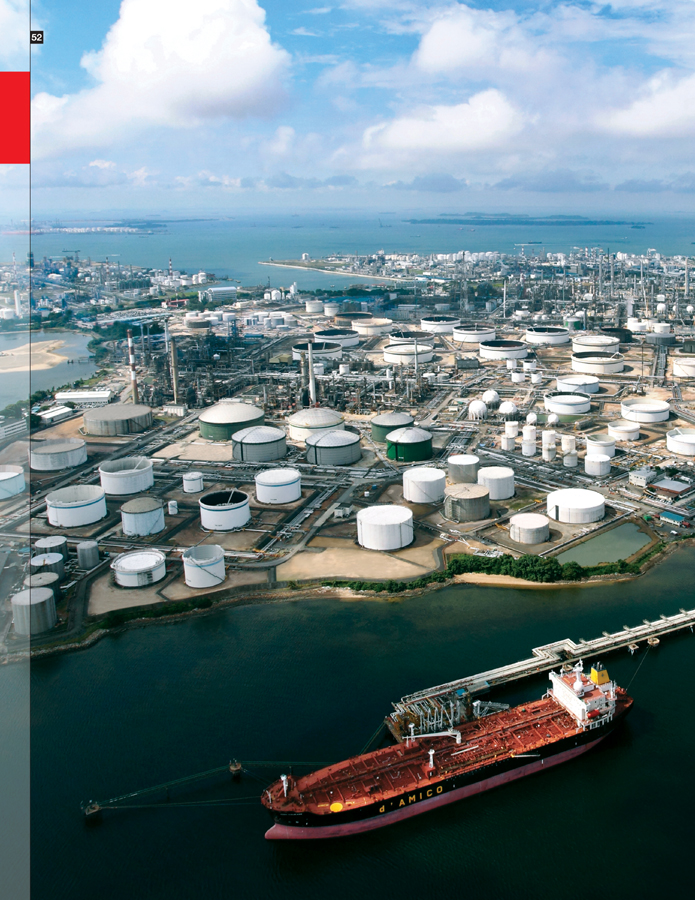
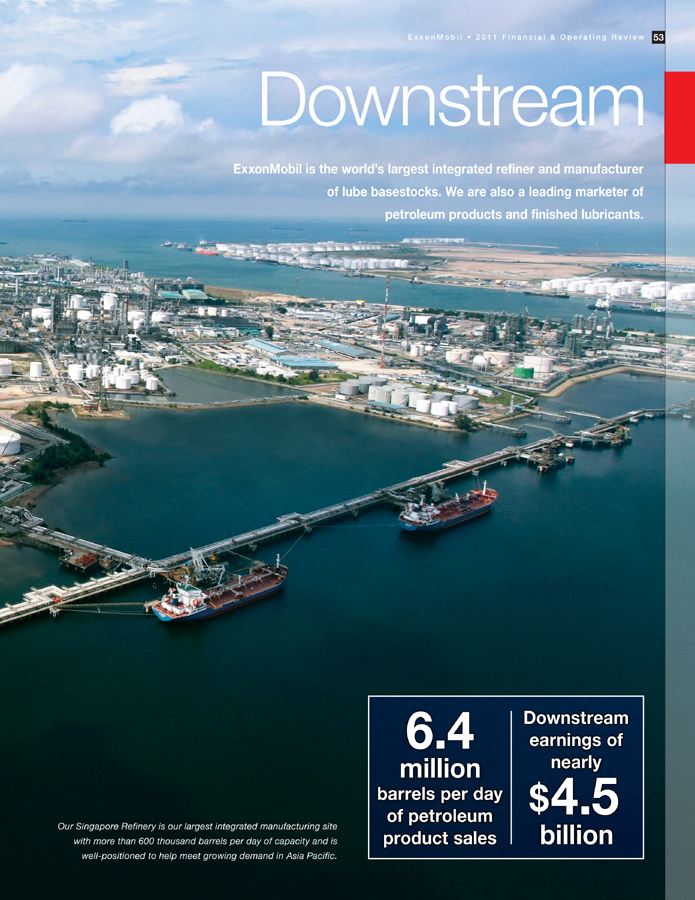
 | 54 |
ExxonMobil• 2011 Financial & Operating Review

ExxonMobil’s Downstream segment is comprised of a global portfolio of businesses that include Refining & Supply, Fuels, Lubricants & Specialties Marketing, and Research and Engineering. Integrated business strategies and global reach provide us with a strong foundation for continued success, as demonstrated by our 2011 results.
RESULTS & HIGHLIGHTS
Industry-leading safety performance
Zero hydrocarbon spillsfrom owned/operated and long-term leased marine vessels
Record low refinery energy use,driven by our Global Energy Management System and cogeneration facilities
Record production of ultra-low sulfur diesel,reflecting strong operations and new hydrotreating investments
Record sales of our industry-leading lubricants,Mobil 1, Mobil Delvac 1, and Mobil SHC
Earnings of $4.5 billion,reflecting an improved business environment and continued margin and efficiency capture
Return on average capital employed of 19.1 percent,consistently leading industry throughout the business cycle
Downstream capital expenditures of $2.1 billion,including investments in growth markets, higher-value products, efficiency improvements, and environmentally driven expenditures
Completed new facilities at refineries in Fawley, United Kingdom; and Sriracha, Thailand,increasing lower-sulfur diesel production capacity by more than 70 thousand barrels per day
| DOWNSTREAM STATISTICAL RECAP | 2011 | 2010 | 2009 | 2008 | 2007 | |||||||||||||||
Earnings(millions of dollars) | 4,459 | 3,567 | 1,781 | 8,151 | 9,573 | |||||||||||||||
Refinery throughput(thousands of barrels per day) | 5,214 | 5,253 | 5,350 | 5,416 | 5,571 | |||||||||||||||
Petroleum product sales(thousands of barrels per day) | 6,413 | 6,414 | 6,428 | 6,761 | 7,099 | |||||||||||||||
Average capital employed(1)(millions of dollars) | 23,388 | 24,130 | 25,099 | 25,627 | 25,314 | |||||||||||||||
Return on average capital employed(1)(percent) | 19.1 | 14.8 | 7.1 | 31.8 | 37.8 | |||||||||||||||
Capital expenditures(1)(millions of dollars) | 2,120 | 2,505 | 3,196 | 3,529 | 3,303 | |||||||||||||||
(1) See Frequently Used Terms on pages 93 through 95.

BUSINESS OVERVIEW
ExxonMobil’s Downstream is a large, diversified business with a global portfolio of world-class refining and distribution facilities, lube oil blend plants, and marketing operations. Operational excellence and technology underpin our Downstream business activities. As the largest global refiner and lube basestock manufacturer, we have a strong presence in the higher-growth Asia Pacific region as well as in mature markets in North America and Europe. We have an ownership interest in 36 refineries with distillation capacity of 6.2 million barrels per day and lubricant basestock capacity of 131 thousand barrels per day. We lead industry with more than 75 percent of our refining capacity integrated with chemical or lubes. Our fuels and lubricants marketing businesses have global reach through market channels that serve a globally diverse customer base. Technology leadership enables us to offer innovative products and services that help deliver tangible performance benefits for both customers and industry. World-class brands, including Exxon, Mobil, and Esso, are well-known, and our supply reliability and strong customer focus underpin the commercial success of our brands.
Our Downstream business delivers long-term shareholder value that is superior to competition across a range of market conditions.
BUSINESS ENVIRONMENT
By 2040, energy demand for transportation fuels is forecast to increase by nearly 45 percent versus 2010. Growth in developing markets, such as China, India, and the Middle East, is expected to more than offset flattening demand in more mature, developed markets. We also anticipate a continued shift in product mix as growth in the heavy-duty transportation sector will drive increases in diesel demand. Gasoline demand is expected to flatten and then decline with continued improvements in light-duty vehicle efficiency. Total lubricant demand is expected to grow approximately 1 percent per year on increased industrial activity with the strongest growth expected in the Asia Pacific region.
Despite the potential positive effects of this energy demand growth on our Downstream business, we expect the challenging business environment to continue as new capacity additions outpace overall growth in global demand. As a result, our long-term outlook is that refining margins will remain weak. However, our business model, coupled with our strengths, allows us to capture strong margins at the top of the cycle and outperform competition at the bottom of the cycle. The results we consistently achieve demonstrate the resiliency of our business as the Downstream continues to deliver industry-leading returns throughout the business cycle.
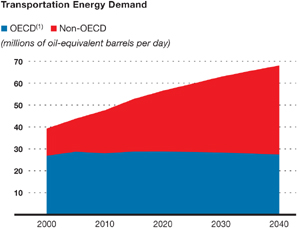
(1) OECD = Organisation for Economic Co-operation and Development. Source: ExxonMobil,2012 The Outlook for Energy: A View to 2040
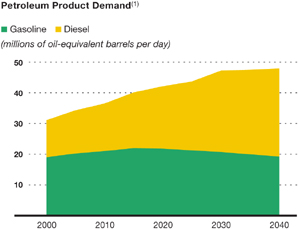
(1) Excludes other petroleum products (e.g., heating oil, fuel oil, liquefied petroleum gas, kerosene, jet fuel, naphtha).
55 |  |
 | 56 |
ExxonMobil• 2011 Financial & Operating Review
DOWNSTREAM:
Balanced Portfolio
We are the world’s largest integrated refiner and manufacturer of lube basestocks, as well as a leading marketer of petroleum products. Our world-class facilities are located around the globe in major petroleum markets.
ExxonMobil’s Downstream portfolio has advantages that set us apart from the competition, including:
Scale•Our refineries are, on average, 60-percent larger than industry, which provides us with a scale advantage. We also have the largest lubricant basestock manufacturing capacity in the world, nearly four times more than the competitor average.
Advantaged Feedstocks•ExxonMobil refineries capture significant value by running about 50-percent more difficult-to-process or “challenged” crudes than the industry average. We also process more lube-quality crudes compared with key competitors.
Global Brands•Our world-class brands demonstrate our global reach and the superior technology that position us as a leading supplier of fuel and lubricant products. The quality of our global brands also enables profitable sales growth.
ExxonMobil
refineries are
60%
larger than
industry average
refineries are
60%
larger than
industry average
Diverse Business Channels•Both our retail and business-to-business classes of trade provide secure, ratable, and profitable outlets that are highly integrated with our refineries.
Lubricants Growth•ExxonMobil is a market leader in high-value synthetic lubricants, with 10-percent-higher market share than the competitor average. We continue to grow the business in key markets at rates considerably faster than industry.
WORLDWIDE DOWNSTREAM OPERATIONS
We have a strong refining presence in each geographic region, making us one of the most balanced of any major oil company. Our Fuels Marketing business is in 52 countries, and lubricants are sold in more than 100 countries. Some examples of ExxonMobil’s global Downstream operations include the following:
NORTH AMERICA
United States
Across the United States, we operate seven refineries and are a leading supplier of transportation fuels and lubricants. Our facilities convert crude oil into gasoline, diesel, jet fuel, basestocks, and petrochemical feedstocks that are used in medical equipment, electronics, clothing, tires, and many other products. ExxonMobil, with more than 100 years of experience in the refining industry, can process more than 1.9 million barrels of crude oil per day in the United States, which represents about 30 percent of our global refining capacity.
Largest Global Refiner
| Refinery interests | 36 | |||
Distillation capacity(barrels per day) | 6.2 million | |||
Lube basestock capacity(barrels per day) | 131 thousand | |||
Diverse Fuels Marketing Customer Base
with Global Reach
with Global Reach
| Branded service stations | ~25,000 | |||
| Commercial customers | ~500,000 |
Global Lubricants Leadership Position
| Market position | No.1 supplier of lube basestocks and marketer of synthetic lubricants |
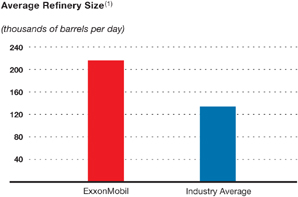
(1) ExxonMobil average global refinery distillation capacity compared to industry equity share capacity (year-end 2011). Equity share capacity calculated on consistent basis using public information.
Source:Oil & Gas Journal
Source:Oil & Gas Journal
Baytown, Texas•ExxonMobil’s Baytown Refinery is the largest petroleum and petrochemical complex in the United States. Crude oil supplied to the refinery comes from all over the world, including domestic conventional and unconventional sources. The refinery started operations in 1920, and at that time, processed about 10 thousand barrels of crude oil per day. Today, we have the capability to process up to 561 thousand barrels per day. In 2010, we completed construction of a new hydrotreating unit that enabled us to increase production of ultra-low sulfur diesel to help meet increasing market demand. This investment is an example of how we are maximizing our flexibility to produce higher-value products.
Joliet, Illinois •The Joliet Refinery is one of the newest and most energy-efficient refineries in the United States, and it uses many modern technologies to process crude oil safely, reliably, and efficiently. The refinery is a key supplier of refined petroleum products to the Midwest, and the site is equipped to handle 238 thousand barrels of crude oil per day. About 85 percent of the products made from a refined barrel of crude oil are diesel and gasoline with the remaining 15 percent consisting of a wide range of products, including propane, butane, industrial fuels, and asphalt. The Joliet Refinery is ideally located to receive and process Canadian crude oil delivered by pipeline and was specifically designed with this purpose in mind.
U.S. Lube Oil Blending and Fuels Marketing Operations •ExxonMobil’s lubricant supply network includes five lube oil blend plants in the United States that are fully integrated into our global supply network. Synthetic lube basestocks are also sourced from our chemical plants. Fuels Marketing operations include a mix of retail and business-to-business activities. Our branded fuels,Exxon andMobil, are well-known.
Our global Downstream portfolio includes high-quality assets that are operated to deliver best-in-class performance.
U.S. Pipeline Operations • ExxonMobil Pipeline Company transports over 2.6 million barrels per day of crude oil, refined products, liquefied petroleum gases, natural gas liquids, and chemical feedstocks through 8000 miles of operated pipeline in the United States. For example, the Hoover Offshore Oil Pipeline System provides transportation for crude oil from offshore production facilities at the Hoover-Diana, Perdido, Boomvang, Nansen, and Gunnison offshore platforms to Seaway’s terminal facilities at Jones Creek and Texas City. Additionally, the recently expanded Pegasus pipeline extends from Patoka, Illinois, to the U.S. Gulf Coast, providing Midwest connectivity to U.S. Gulf Coast markets. Receipts at Patoka arrive from the Mustang, Woodpat, and Keystone pipelines with delivery to the Sunoco Logistics’ Nederland terminal to supply ExxonMobil’s Beaumont Refinery and other industry facilities.
In addition to pipelines, ExxonMobil Pipeline Company operates 22 distribution terminals in the United States that distribute gasoline, diesel fuel, heating oil, aviation fuel, kerosene, and other refined products. The company also operates three salt dome storage facilities.
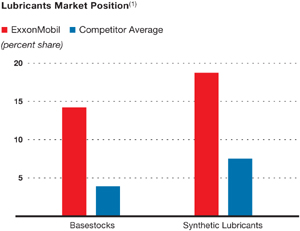
(1) ExxonMobil estimate of key competitor market share based on Kline industry data and public information. Competitor average includes Royal Dutch Shell, BP, and Chevron.
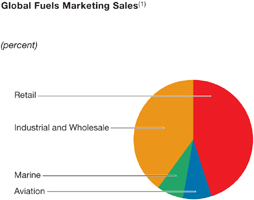
(1) Fuels Marketing petroleum product sales are to retail sites as well as commercial and wholesale accounts.
57 |  |
 | 58 |
ExxonMobil• 2011 Financial & Operating Review
Downstream: Balanced Portfolio, continued
Canada
ExxonMobil is Canada’s largest refiner of petroleum products through our majority-owned affiliate Imperial Oil (ExxonMobil interest, 69.6 percent) with more than 500 thousand barrels per day of refining capacity. In our Fuels Marketing business, we sell quality products and services through a network of about 1800 Esso-branded retail service stations, the largest network of service stations in Canada. We also market quality fuels and lubricants to a wide range of commercial customers, including mining, manufacturing, forestry, construction, agriculture, and transportation industries. Canada also has strong synthetic lubricants growth potential. We are well-positioned to capture value from this market, more than doubling sales ofMobil 1, Mobil SHC, andMobil Delvac 1 lubricants in the last five years.
Strathcona, Alberta• The Strathcona Refinery is a 189-thousand-barrel-per-day plant that produces a wide range of petroleum products, including gasoline, aviation fuel, diesel fuel, lubricating oils, petroleum waxes, heavy fuel oils, and asphalts. The refinery is the only producer of lubricating base oil and waxes in western Canada, and runs advantaged Canadian crude oil.
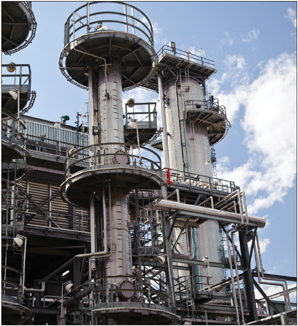
Comprehensive global management systems are applied in projects and operations around the world, including at our Strathcona Refinery in Alberta, Canada.
EUROPE
Nearly 30 percent of ExxonMobil’s global refining capacity is located in Europe. We market products across the region through a retail network of more than 6000 service stations. We also market directly to commercial customer segments, such as aviation, industrial and wholesale, equipment manufacturers, marine, and transportation. Our global aviation business, headquartered in Brussels, Belgium, is one of the world’s largest jet fuel suppliers with a presence at more than 200 airports.
Antwerp, Belgium• The Antwerp Refinery is one of the largest ExxonMobil sites in Europe with over 300 thousand barrels per day of crude oil capacity. It is fully integrated with our Chemical business and is the largest fluids manufacturer in Europe. The site also supplies numerous raw materials to the chemical sector. In 2009, we completed an investment in cogeneration facilities, and as a result, Antwerp is one of the most energy-efficient refineries in our global circuit, providing a competitive cost advantage. Additionally, in 2011, a new hydrotreating unit to increase ultra-low sulfur diesel supply commenced operations.
Rotterdam, Netherlands• Our Rotterdam Refinery is one of four integrated refining and chemical complexes in Europe and can process more than 190 thousand barrels per day of a variety of crude oils. This high-conversion refinery has processing capability to convert heavy-oil fractions into 70-percent light-oil products and cokes. The site also has a cogeneration unit that efficiently produces most of the steam and electricity needed for site operations.
Fawley, United Kingdom• The Fawley Refinery, near Southampton, is the largest refinery in the United Kingdom. It has the ability to process 330 thousand barrels of crude oil per day and accounts for nearly 20 percent of the refining capacity in the United Kingdom. Crude oil is transported by sea to the refinery’s marine terminal, which is the largest privately owned jetty in the United Kingdom and handles more than 2000 ship movements per year. The site also provides feedstocks for lube basestock production and for our chemical manufacturing plant that is both adjacent to and integrated with the refinery.
U.K. Marketing Operations• ExxonMobil is a leading marketer of transportation fuels in the United Kingdom. We sell fuels through a network of Esso-branded service stations. Industrial customers include bus and train companies, ferry and luxury shipping lines, airlines, industrial and commercial companies, and major public sector organizations. ExxonMobil Marine Fuels and Lubes, based in the United Kingdom, is a business that has operations around the globe. Marine distillates, lubricants, and fuel oils are sold to major shipowners around the world, from ferry and luxury shipping lines to freight and crude oil carriers.
ASIA PACIFIC
More than 25 percent of ExxonMobil’s global refining capacity is located in the Asia Pacific region. We also have marketing activities in major markets in the region, and our network of seven lube oil blend plants provides products throughout the region, including to the key growth markets of China and India.
Singapore•We have operated in Singapore for over 100 years, as we expanded from trading kerosene to having a multibillion-dollar manufacturing and marketing presence today. Singapore also serves as the Asia Pacific hub for our Downstream and Chemical businesses. The Singapore Refinery is a world-scale refining complex with over 600 thousand barrels per day of crude distillation capacity. It is the largest refinery in our global network. The site produces a range of products as well as feedstocks for chemical manufacturing. In 2011, we announced plans to build a diesel hydrotreater at the refinery to increase production capacity of ultra-low sulfur diesel fuel to help meet increasing demand in the Asia Pacific region. Additionally, our lubricant basestock manufacturing plant was built using state-of-the-art technology that employs proprietary
We are a leading lubricants marketer in the Asia Pacific region. Our sales of high-value synthetic lubricants are two times higher than in 2005.
catalysts to produce basestocks with outstanding performance properties for the growing premium lubricants markets across the Asia Pacific region. Waxes are also produced at the site and are widely used in food packaging, waterproofing for paper and textiles, candle making, and cosmetics. Our Jurong Lube Oil Blend Plant supplies growing Asia Pacific demand as well as international marine customers at the Port of Singapore. We also operate the largest network ofEsso-branded service stations and are a major marketer of cylinder cooking gas to Singapore homes.
Fujian, China• The Fujian Refining and Petrochemical Complex (ExxonMobil interest, 25 percent) is a 252-thousand-barrel-per-day integrated joint venture plant. The refinery processes primarily sour Arabian crude. Support operations include a 300-thousand-tonne crude berth and a 250-megawatt cogeneration plant that provides more than 50 percent of the power needs in the complex. The fuels marketing portion of the venture sells transportation fuels produced by the refinery through a network of distribution terminals and more than 750 service stations. Additionally, we are a leading lubricants marketer in China. We produce a full range of premium lubricants at two lube oil blend plants and distribute our products using a network of key distributors. Our high-value synthetic sales have quadrupled since 2005, supported by a strong distribution network and more than 1000Mobil 1 Lube Change Centers.
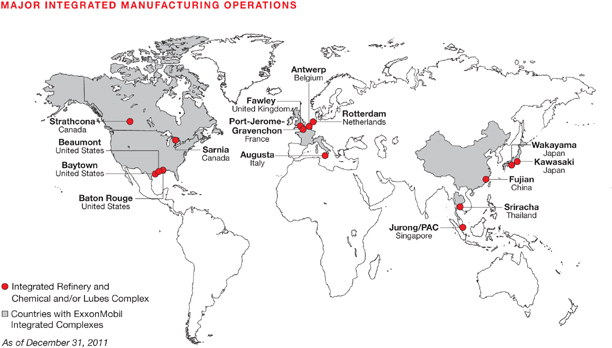
59 |  |
 | 60 |
ExxonMobil• 2011 Financial & Operating Review
DOWNSTREAM:
Disciplined Investing
We maintain a disciplined, long-term approach to managing capital employed. Ongoing evaluation of our Downstream portfolio results in investments in resilient, advantaged projects, and selective divestment of less attractive assets.
SELECTIVE AND RESILIENT INVESTMENTS
In 2011, we continued to benefit from recent investments to increase diesel production with record sales of ultra-low sulfur diesel (ULSD) from our Baytown, Baton Rouge, and Antwerp Refineries. Over the past five years, we invested nearly $2 billion to increase ULSD capacity to help meet growing demand. ULSD production has nearly tripled since 2006, and we are progressing additional investments to expand capacity. In 2011, we completed construction of facilities at our Sriracha, Thailand, refinery. Additional investments are under way at our sites in Singapore and Saudi Arabia, focused on improving competitiveness, growing higher-value fuels and lubes, and maximizing site returns. For example, our lube oil blend plant at Jurong is undergoing an expansion to support growing lubricants demand in Asia. In China, we plan to expand lube oil blending capability at our Tianjin and Taicang plants as well.
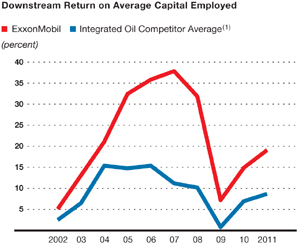
(1) Royal Dutch Shell, BP, and Chevron values are estimated on a consistent basis with ExxonMobil, based on public information.
PORTFOLIO MANAGEMENT
Our capital management strategy combines selective investment with ongoing portfolio management in order to sustain industry-leading returns. We continuously evaluate assets and take appropriate steps to maximize long-term shareholder value. Highgrading the asset mix is an ongoing element of our approach to disciplined capital management. Since 2003, we have divested interests in 11 refineries, more than 5900 miles of pipeline assets, 145 product terminals, 33 lube oil blend plants, and nearly 16,800 retail sites.
In 2011, we announced divestment of our downstream assets in Argentina, Uruguay, Paraguay, Central America, Malaysia, and Switzerland. The transition to a more capital-efficient branded wholesaler model in the United States is also progressing well and is expected to be completed in 2012.
ExxonMobil’s Downstream business remains the industry’s most capital-efficient, delivering the highest return on average capital employed compared to key competitors.
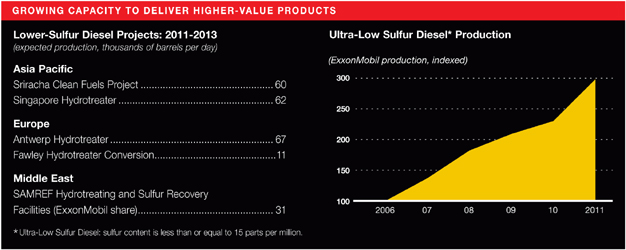
DOWNSTREAM:
High-Impact Technologies
We realize a sustainable competitive advantage by applying leading-edge technologies to address business challenges. Our proprietary technologies allow us to optimize manufacturing by enabling production of high-value products from the widest range of raw materials at a lower cost.
DELIVERING HIGH-VALUE PRODUCTS
We use analytical, experimental, and modeling capabilities to generate molecular understanding and efficiently develop leading-edge product technologies. For example, we have several active programs focused on providing significant fuel economy benefits in our flagshipMobil 1 products, while maintaining outstanding engine protection and lower emissions. We also re-engineered, upgraded, and introduced new products to ourMobil SHC line of synthetic industrial lubricants. These advanced circulating and gear oils have the potential to significantly reduce energy consumption while providing high levels of wear protection and extended oil life in some of the most extreme service and climate conditions. Research on our fuel products also continues to improve product quality. For example, we recently reformulated our gasolines in the United States to help improve engine cleanliness.
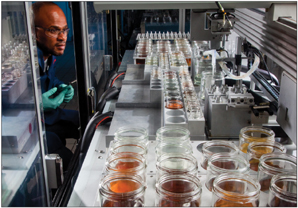
High-throughput research equipment, like this automated lubricant blending station, enables our formulators to rapidly map results from component modifications to deliver improved product performance.
IMPROVING OPERATIONS
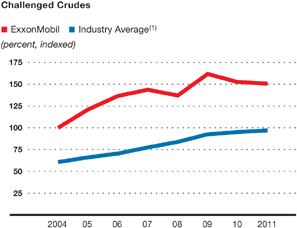
(1) ExxonMobil estimate based on public information.
Innovative technology application also facilitates improved operations. For example, our proprietary Molecule Management process uses advanced analytical techniques to understand the detailed molecular composition of raw materials, intermediate streams, and products. Supply chain models optimize placement of feedstocks, and real-time process models examine trade-offs across distillation and conversion unit operations. Combining modeling with our molecular understanding enables us to maximize production of products with enhanced yields and margins. For example, we are an industry leader in processing “challenged” crudes, running about 50-percent more than industry, due in part to this technology. These crudes are typically more difficult to process because they have properties such as acid corrosivity, high nitrogen content, and other impurities. Because of these characteristics, they are sold at a discount, which provides a raw material cost advantage. Robust systems allow us to process a wider range of raw materials, including higher levels of “challenged” crudes, without restricting our ability to manufacture higher-value products. They also allow us to deliver efficiency by placing molecules in the right place at the right time to improve margins.
Our technology leadership is also illustrated through our long history of advanced catalyst discovery, development, and deployment. Catalysts accelerate the rate of desired chemical reactions and are used in more than 85 percent of our refinery conversion units. They enable efficient upgrading of feedstocks such as high-sulfur heavy crudes into products. We use state-of-the-art experimental and modeling tools to fundamentally understand the effectiveness of catalysts so we can best match desired chemical reactions to feedstock and operating conditions. This knowledge allows us to ensure the highest-impact catalysts are used in each of our process units to provide the highest product value while managing catalyst cost.
61 |  |
 | 62 |
ExxonMobil• 2011 Financial & Operating Review
DOWNSTREAM:
Operational Excellence
We maintain best-in-class operations. Our focus on operational excellence extends to all parts of the business and forms the foundation of our license to operate.
MAINTAINING BEST-IN-CLASS OPERATIONS
Personnel and operations safety remains a top priority. ExxonMobil’s Operations Integrity Management System (OIMS) continues to provide the framework to enable safe and reliable operations. In 2011, we continued to demonstrate industry-leading safety performance, as measured by lost-time incident rates (LTIR), with workforce LTIR of 0.04, an improvement of more than 25 percent since 2005.
Above everything else is our commitment to operational excellence – in safety, security, and health, as well as environmental and controls performance.
In the area of efficiency, we achieve superior cost performance by reducing energy use, leveraging global scale and integration, and deploying leading-edge technologies. Application of systematic processes like OIMS, combined with efficient execution, has established us as an industry leader in operational excellence and cost effectiveness.
INCREASING MARGINS
We continue to improve margins by focusing on economically increasing utilization, reducing raw materials costs, and capturing higher product value. The economic utilization of our refining capacity is maximized by improving reliability, eliminating operating constraints, and expanding market outlets. For example, in 2011, U.S. refining utilization was 91 percent, better than the industry average. We also continue to capture benefits from ultra-low sulfur diesel investments at sites in the United States and Belgium with more than 330 thousand barrels per day of increased ultra-low sulfur diesel production versus 2009.
Reducing raw material costs is another important component of margin improvement. We work to reduce these costs by upgrading facilities and applying technology to increase raw material processing flexibility. For example, a measure of raw material flexibility is the number of crudes that are new to each refinery. In 2011, we processed 154 crudes new to individual sites. We also continue to take advantage of changes in the marketplace, as seen recently in North America with the price difference between West Texas Intermediate and Brent crudes, due to constrained logistics. We optimize supply and site operations at our refineries in Canada and the U.S. Gulf Coast to process these advantaged crudes to capture lower raw material costs. Increased lube crude approvals also lower raw material costs by providing more flexibility to run different types of crudes for lubes production.
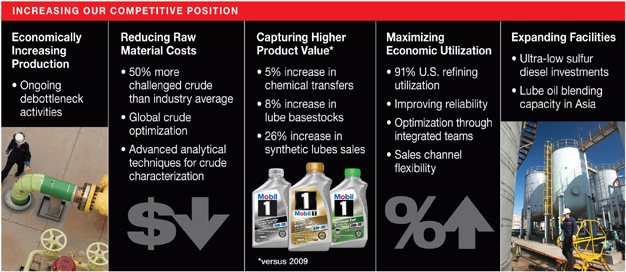
IMPROVING OPERATING EFFICIENCY
Worldwide cash operating costs at our refineries remain at levels substantially below the industry average, providing a competitive advantage especially in the current challenging margin environment. We achieve superior cost performance by reducing energy use and leveraging scale, integration, and leading-edge technologies. Energy represents about one-third of the operating cost of a manufacturing facility and remains a focus area to capture additional cost efficiencies. In 2011, we achieved best-ever energy efficiency for our global refining network. This success is due in part to the integration of our refineries, lube oil blend plants, and chemical sites. Since 2002, we have improved refinery energy efficiency by an average of nearly 9 percent with a goal of achieving a 10-percent reduction by 2012 across our worldwide manufacturing operations.
We continue to make significant investments in cogeneration facilities, which simultaneously produce electricity and useful heat or steam, to further optimize energy consumption. Cogeneration is significantly more efficient than traditional methods of producing steam and power separately, resulting in lower greenhouse gas emissions and reduced cost. All of our refineries in the United States have cogeneration facilities.
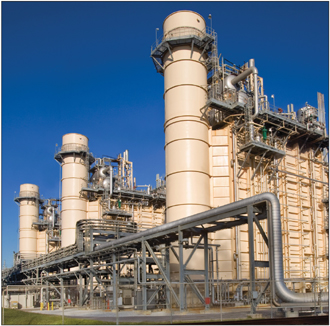
Cogeneration provides a significant source of efficient energy for our refining and chemical sites.
Our marketing businesses continue to benefit from initiatives to achieve cost-efficiency improvements as well. These efforts have more than offset inflationary pressures over the last several years. Simultaneously, we are restructuring our business model toward more efficient and effective distribution channels. Fuels Marketing operating expenses (at constant foreign exchange rates and energy price) declined by nearly 25 percent since 2002. Our Lubes and Specialties business has also become more efficient by consolidating customer service centers, rationalizing lube oil blend plants, and streamlining product offerings while continuing to capture high-value growth opportunities.
Reduced
refinery energy
use by nearly
9%
since 2002
refinery energy
use by nearly
9%
since 2002
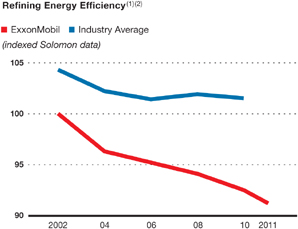
(1) Solomon Associates fuels refining data available for even years only.
(2) 2011 data estimated by ExxonMobil.
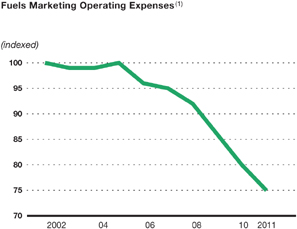
(1) Operating expenses shown at constant foreign exchange rates and energy price. Includes effects from restructuring.
63 |  |
 | 64 |
ExxonMobil• 2011 Financial & Operating Review
DOWNSTREAM:
Global Integration
We capitalize on integration across our businesses by leveraging a global functional organization, applying common global processes, and deploying best practices quickly and efficiently. We lead the industry with more than 75 percent of our refining operations integrated with chemical or lubes operations.
OPTIMIZING VALUE IN MANUFACTURING
The effective and efficient implementation of an integrated business model allows us to capture significant value across the supply chain, at manufacturing sites, and more broadly, in the management of critical, common activities. Effective execution of this integrated model is not easily accomplished, and we are unique in our ability to successfully implement it.
For example, refining is a complex operation that depends upon the skills of operators, engineers, and planners, in combination with cutting-edge technology to manufacture products that meet the demands of an intensely competitive market. At its simplest, oil refining is the separation of crude oil by distillation into different fractions. However, many other complex processes are necessary to produce a full range of products, including propane and butane, gasoline, jet fuel, diesel fuel, marine fuels, heating oil, lubricant basestocks, and fuel oil. Many of our refineries supply not only refined products but also feedstocks to our adjacent chemical plants. We leverage integration on a daily basis to highgrade feedstocks and products.
Additionally, our Lubricants and Specialties business takes advantage of integration with our refining and chemical plants by using production as feedstock to formulate high-value synthetic lubricants. ExxonMobil’s recently announced investment to expand synthetic lubricant basestock production at our Baytown, Texas, facility will allow us to enhance our leading-edge synthetic products to further help global manufacturers and operators around the world improve the performance and efficiency of their industrial equipment, such as wind turbines.
Our global scale and level of integration are unmatched and generate shareholder value.
MAXIMIZING VALUE ACROSS THE SUPPLY CHAIN
We use an integrated approach to develop new business opportunities and optimize global operations. For example, in support of the Upstream, our global supply organization manages the economic placement of more than 2 million barrels per day of equity crude. At manufacturing sites, we use computer models to optimize operations on an integrated basis, including the selection of the most economic crudes and feedstocks to produce the highest-value fuel products, chemicals, lubricants, and asphalts. On the product side of the supply chain, integrated business teams combine manufacturing, supply, technology, logistical, and marketing expertise to optimize margin capture and highgrade placement of finished products based on the best market outlet. Our global scale and level of integration are structural advantages that are difficult for competitors to replicate.
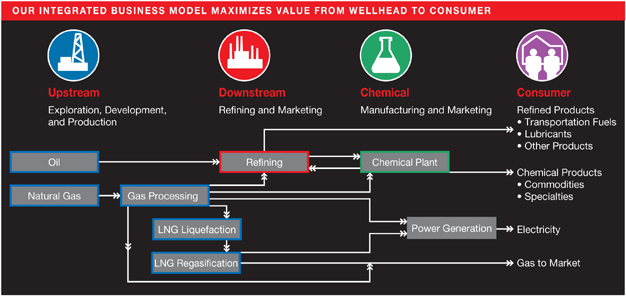
ENHANCING UPSTREAM RESOURCE VALUE
ExxonMobil’s globally integrated business model allows us to leverage downstream technical expertise and a global marketing presence, along with refining and logistics assets, to enhance resource value during the early stages of Upstream project development. We have developed systems and personnel specifically to facilitate this early integration to enhance the eventual marketing and valuation of new crude and condensate resources. Additionally, our Downstream business provides direct support to Upstream projects in the following areas:
Commercial• optimizing fiscal and commercial terms; developing potential market outlets; Technology• expediting crude assay and characterization development; identifying and resolving challenging crude properties or characteristics;
Supply Chain• optimizing logistics, including tankage, pipelines, terminals, and ships; and, Refining• identifying unique processing requirements; providing backstop processing capabilities to maximize value.
Some examples of successful Upstream and Downstream integration include the following:
Kearl Oil Sands Project• Our global supply organization has a broad understanding of the marketing options for new crudes, and our refining organization has the technical
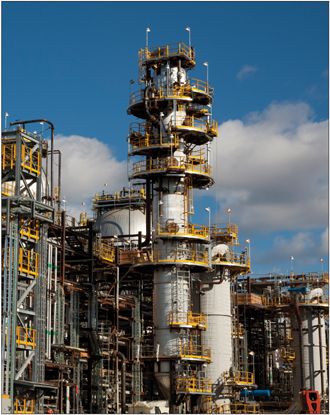
Our Kearl oil sands project in Canada will start up in late 2012. We have sufficient refining capability to process Kearl’s diluted bitumen, allowing us to maximize value.
knowledge to identify and overcome possible processing challenges. The heavy bitumen that will be produced at Kearl requires combining a lighter product (or diluent) to make the crude oil transportable via pipeline and ultimately refined. Our Downstream business is developing a diluent as well as a refining strategy for the Kearl oil sands project to provide enhanced overall value.
Papua New Guinea LNG Project• This Upstream project is still two years away from start-up, yet our Downstream business has already been involved with the project for several years. For example, we have provided logistical and commercial guidance that will enable the utilization of existing assets to export the associated condensate produced with the liquefied natural gas (LNG). In addition, we helped develop a unique logistics system to allow for the loading of small condensate liquid volumes produced at the LNG plant, utilizing the same terminal as the much larger LNG ships. This logistics system saved significant capital spending by avoiding additional investments for tankage and a separate terminal.
Sakhalin-1 Project• Sakhalin-1 is an arctic project off the eastern coast of Russia that started export operations in 2006 using dedicated ice class tankers and icebreakers. Our Downstream business has supported continuous flawless operations in this harsh environment. In addition, we helped manage and optimize both logistics and marketing for this production.
Cepu Project• We provided commercial and marketing support to allow for early production and commercial sales of Banyu Urip crude oil within Indonesia. Sales began in 2009 and are expected to continue until full field production starts in a few years. Additionally, our Downstream business is assisting with marketing and logistics development for full field production, at which time crude will be exported to global markets via a floating production, storage, and offloading vessel.
65 |  |
 | 66 |
ExxonMobil• 2011 Financial & Operating Review
DOWNSTREAM OPERATING STATISTICS
THROUGHPUT, CAPACITY, AND UTILIZATION(1)
| 2011 | 2010 | 2009 | 2008 | 2007 | ||||||||||||||||
Refinery Throughput(2)(thousands of barrels per day) | ||||||||||||||||||||
| United States | 1,784 | 1,753 | 1,767 | 1,702 | 1,746 | |||||||||||||||
| Canada | 430 | 444 | 413 | 446 | 442 | |||||||||||||||
| Europe | 1,528 | 1,538 | 1,548 | 1,601 | 1,642 | |||||||||||||||
| Japan | 520 | 536 | 556 | 563 | 618 | |||||||||||||||
| Asia Pacific excluding Japan | 660 | 713 | 772 | 789 | 798 | |||||||||||||||
| Middle East/Latin America/Other | 292 | 269 | 294 | 315 | 325 | |||||||||||||||
Total worldwide | 5,214 | 5,253 | 5,350 | 5,416 | 5,571 | |||||||||||||||
Average Refining Capacity(3)(thousands of barrels per day) | ||||||||||||||||||||
| United States | 1,952 | 1,962 | 1,970 | 1,967 | 1,963 | |||||||||||||||
| Canada | 506 | 505 | 502 | 502 | 502 | |||||||||||||||
| Europe | 1,752 | 1,744 | 1,742 | 1,740 | 1,759 | |||||||||||||||
| Japan | 653 | 681 | 680 | 702 | 769 | |||||||||||||||
| Asia Pacific excluding Japan | 1,032 | 1,030 | 1,006 | 992 | 983 | |||||||||||||||
| Middle East/Latin America/Other | 331 | 331 | 331 | 330 | 330 | |||||||||||||||
Total worldwide | 6,226 | 6,253 | 6,231 | 6,233 | 6,306 | |||||||||||||||
Utilization of Refining Capacity(percent) | ||||||||||||||||||||
| United States | 91 | 89 | 90 | 87 | 89 | |||||||||||||||
| Canada | 85 | 88 | 82 | 89 | 88 | |||||||||||||||
| Europe | 87 | 88 | 89 | 92 | 93 | |||||||||||||||
| Japan | 80 | 79 | 82 | 80 | 80 | |||||||||||||||
| Asia Pacific excluding Japan | 64 | 69 | 77 | 80 | 81 | |||||||||||||||
| Middle East/Latin America/Other | 88 | 81 | 89 | 95 | 98 | |||||||||||||||
Total worldwide | 84 | 84 | 86 | 87 | 88 | |||||||||||||||
| (1) | Excludes ExxonMobil’s interest in the Laffan Refinery in Qatar and ExxonMobil’s minor interests in certain small refineries. |
| (2) | Refinery throughput includes 100 percent of crude oil and feedstocks sent directly to atmospheric distillation units in operations of ExxonMobil and majority-owned subsidiaries. For companies owned 50 percent or less, throughput includes the greater of either crude and feedstocks processed for ExxonMobil or ExxonMobil’s equity interest in raw material inputs. |
| (3) | Refining capacity is the stream-day capability to process inputs to atmospheric distillation units under normal operating conditions, less the impact of shutdowns for regular repair and maintenance activities, averaged over an extended period of time. These annual averages include partial-year impacts for capacity additions or deletions during the year. Any idle capacity that cannot be made operable in a month or less has been excluded. Capacity volumes include 100 percent of the capacity of refinery facilities managed by ExxonMobil or majority-owned subsidiaries. At facilities of companies owned 50 percent or less, the greater of either that portion of capacity normally available to ExxonMobil or ExxonMobil’s equity interest is included. |
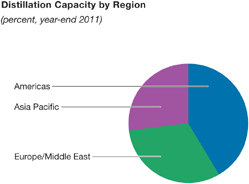
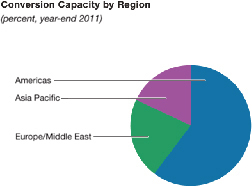
REFINING CAPACITY AT YEAR-END 2011(1)
| Capacity at 100% | ||||||||||||||||||||||||||||||||||||
| ExxonMobil | ||||||||||||||||||||||||||||||||||||
| ExxonMobil | Atmospheric | Catalytic | Residuum | Interest | ||||||||||||||||||||||||||||||||
| (thousands of barrels per day) | Share(2) | Distillation | Cracking | Hydrocracking | Conversion(3) | Lubricants(4) | % | |||||||||||||||||||||||||||||
United States | ||||||||||||||||||||||||||||||||||||
| Torrance | California | l | 150 | 150 | 83 | 21 | 50 | 0 | 100 | |||||||||||||||||||||||||||
| Joliet | Illinois | l | 238 | 238 | 94 | 0 | 56 | 0 | 100 | |||||||||||||||||||||||||||
| Baton Rouge | Louisiana | n | l | 502 | 502 | 231 | 25 | 117 | 16 | 100 | ||||||||||||||||||||||||||
| Chalmette | Louisiana | l | 5 | 95 | 189 | 72 | 0 | 29 | 0 | 50 | ||||||||||||||||||||||||||
| Billings | Montana | l | 60 | 60 | 19 | 6 | 10 | 0 | 100 | |||||||||||||||||||||||||||
| Baytown | Texas | n | l | 561 | 561 | 205 | 27 | 90 | 22 | 100 | ||||||||||||||||||||||||||
| Beaumont | Texas | n | l | 345 | 345 | 113 | 60 | 46 | 10 | 100 | ||||||||||||||||||||||||||
| Total United States | 1,951 | 2,045 | 817 | 139 | 398 | 48 | ||||||||||||||||||||||||||||||
Canada | ||||||||||||||||||||||||||||||||||||
| Strathcona | Alberta | 189 | 189 | 63 | 0 | 0 | 2 | 69.6 | ||||||||||||||||||||||||||||
| Dartmouth | Nova Scotia | 5 | 85 | 85 | 31 | 0 | 0 | 0 | 69.6 | |||||||||||||||||||||||||||
| Nanticoke | Ontario | 5 | 113 | 113 | 48 | 0 | 0 | 0 | 69.6 | |||||||||||||||||||||||||||
| Sarnia | Ontario | n | l | 119 | 119 | 30 | 18 | 25 | 0 | 69.6 | ||||||||||||||||||||||||||
| Total Canada | 506 | 506 | 172 | 18 | 25 | 2 | ||||||||||||||||||||||||||||||
Europe | ||||||||||||||||||||||||||||||||||||
| Antwerp | Belgium | n | l | 307 | 307 | 35 | 0 | 0 | 0 | 100 | ||||||||||||||||||||||||||
| Fos-sur-Mer | France | l | 5 | 129 | 129 | 31 | 0 | 0 | 0 | 82.9 | ||||||||||||||||||||||||||
| Port-Jerome- | ||||||||||||||||||||||||||||||||||||
| Gravenchon | France | n | l | 235 | 235 | 39 | 0 | 0 | 13 | 82.9 | ||||||||||||||||||||||||||
| Karlsruhe | Germany | l | 5 | 78 | 310 | 86 | 0 | 30 | 0 | 25 | ||||||||||||||||||||||||||
| Augusta | Italy | l | 5 | 198 | 198 | 50 | 0 | 0 | 14 | 100 | ||||||||||||||||||||||||||
| Trecate | Italy | l | 5 | 174 | 174 | 35 | 0 | 0 | 0 | 74.1 | ||||||||||||||||||||||||||
| Rotterdam | Netherlands | n | l | 191 | 191 | 0 | 52 | 41 | 0 | 100 | ||||||||||||||||||||||||||
| Slagen | Norway | 116 | 116 | 0 | 0 | 32 | 0 | 100 | ||||||||||||||||||||||||||||
| Fawley | United Kingdom | n | l | 330 | 330 | 89 | 0 | 37 | 9 | 100 | ||||||||||||||||||||||||||
| Total Europe | 1,758 | 1,990 | 365 | 52 | 140 | 36 | ||||||||||||||||||||||||||||||
Japan | ||||||||||||||||||||||||||||||||||||
| Chiba | Japan | l | 5 | 86 | 172 | 33 | 39 | 0 | 0 | 50 | ||||||||||||||||||||||||||
| Kawasaki | Japan | n | l | 240 | 240 | 87 | 23 | 0 | 0 | 50.1 | ||||||||||||||||||||||||||
| Sakai | Japan | l | 5 | 139 | 139 | 40 | 0 | 0 | 0 | 50.1 | ||||||||||||||||||||||||||
| Wakayama | Japan | l | 5 | 160 | 160 | 37 | 0 | 0 | 7 | 50.1 | ||||||||||||||||||||||||||
| Total Japan | 625 | 711 | 197 | 62 | 0 | 7 | ||||||||||||||||||||||||||||||
Refining Capacity at Year-End 2011, continued on page 68
n Integrated Refinery and Chemical Complex l Cogeneration Capacity 5 Refineries with Some Chemical Production
| (1) | Capacity data is based on 100 percent of rated refinery process unit stream-day capacities under normal operating conditions, less the impact of shutdowns for regular repair and maintenance activities, averaged over an extended period of time. |
| (2) | ExxonMobil share reflects 100 percent of atmospheric distillation capacity in operations of ExxonMobil and majority-owned subsidiaries. For companies owned 50 percent or less, ExxonMobil share is the greater of ExxonMobil’s equity interest or that portion of distillation capacity normally available to ExxonMobil. |
| (3) | Includes thermal cracking, visbreaking, coking, and hydrorefining processes. |
| (4) | Lubes capacity based on dewaxed oil production. |
| (5) | Announced divestment in 2011. |
| (6) | Financial results incorporated into Upstream business. |
67 |  |
 | 68 |
ExxonMobil• 2011 Financial & Operating Review
Downstream Operating Statistics, continued
REFINING CAPACITY AT YEAR-END 2011(1)
| Capacity at 100% | ||||||||||||||||||||||||||||||||||||
| ExxonMobil | ||||||||||||||||||||||||||||||||||||
| ExxonMobil | Atmospheric | Catalytic | Residuum | Interest | ||||||||||||||||||||||||||||||||
| (thousands of barrels per day) | Share(2) | Distillation | Cracking | Hydrocracking | Conversion(3) | Lubricants(4) | % | |||||||||||||||||||||||||||||
| Asia Pacific excluding Japan | ||||||||||||||||||||||||||||||||||||
| Altona | Australia | 5 | 78 | 78 | 28 | 0 | 0 | 0 | 100 | |||||||||||||||||||||||||||
| Fujian | China | n | l | 63 | 252 | 37 | 41 | 10 | 0 | 25 | ||||||||||||||||||||||||||
Port Dickson(5) | Malaysia | 86 | 86 | 0 | 0 | 0 | 0 | 65 | ||||||||||||||||||||||||||||
| Whangarei | New Zealand | 27 | 134 | 0 | 31 | 0 | 0 | 19.2 | ||||||||||||||||||||||||||||
| Jurong/PAC | Singapore | n | l | 605 | 605 | 0 | 36 | 106 | 38 | 100 | ||||||||||||||||||||||||||
| Sriracha | Thailand | n | l | 174 | 174 | 42 | 0 | 0 | 0 | 66 | ||||||||||||||||||||||||||
| Total Asia Pacific excluding Japan | 1,033 | 1,329 | 107 | 108 | 116 | 38 | ||||||||||||||||||||||||||||||
Middle East | ||||||||||||||||||||||||||||||||||||
Laffan(6) | Qatar | 14 | 139 | 0 | 0 | 0 | 0 | 10 | ||||||||||||||||||||||||||||
| Yanbu | Saudi Arabia | 200 | 400 | 91 | 0 | 46 | 0 | 50 | ||||||||||||||||||||||||||||
| Total Middle East | 214 | 539 | 91 | 0 | 46 | 0 | ||||||||||||||||||||||||||||||
Latin America/Other | ||||||||||||||||||||||||||||||||||||
Campana(5) | Argentina | l | 5 | 87 | 87 | 27 | 0 | 24 | 0 | 100 | ||||||||||||||||||||||||||
Acajutla(5) | El Salvador | 22 | 22 | 0 | 0 | 0 | 0 | 65 | ||||||||||||||||||||||||||||
| Martinique | Martinique | 2 | 17 | 0 | 0 | 0 | 0 | 14.5 | ||||||||||||||||||||||||||||
Managua(5) | Nicaragua | 5 | 20 | 20 | 0 | 0 | 0 | 0 | 100 | |||||||||||||||||||||||||||
| Total Latin America/Other | 131 | 146 | 27 | 0 | 24 | 0 | ||||||||||||||||||||||||||||||
Total worldwide | 6,218 | 7,266 | 1,776 | 379 | 749 | 131 | ||||||||||||||||||||||||||||||
n Integrated Refinery and Chemical Complex l Cogeneration Capacity 5 Refineries with Some Chemical Production
See footnotes on page 67.
RETAIL SITES
| (number of sites at year end) | 2011 | 2010 | 2009 | 2008 | 2007 | |||||||||||||||
Worldwide | ||||||||||||||||||||
| Owned/leased | 7,753 | 8,710 | 9,965 | 10,516 | 11,446 | |||||||||||||||
| Distributors/resellers | 17,267 | 17,568 | 17,755 | 18,158 | 20,940 | |||||||||||||||
Total worldwide | 25,020 | 26,278 | 27,720 | 28,674 | 32,386 | |||||||||||||||


ExxonMobil offers consumers premium products carrying the branding of Exxon, Mobil, and Esso. Additional lines include our industry-leading family of lubricant products Mobil 1, Mobil SHC, and Mobil Delvac 1.
PETROLEUM PRODUCT SALES(1)BY GEOGRAPHIC AREA
| (thousands of barrels per day) | 2011 | 2010 | 2009 | 2008 | 2007 | |||||||||||||||
United States | ||||||||||||||||||||
| Motor gasoline, naphthas | 1,372 | 1,445 | 1,425 | 1,449 | 1,601 | |||||||||||||||
| Heating oils, kerosene, diesel oils | 564 | 480 | 517 | 501 | 470 | |||||||||||||||
| Aviation fuels | 178 | 181 | 207 | 224 | 235 | |||||||||||||||
| Heavy fuels | 129 | 122 | 106 | 108 | 121 | |||||||||||||||
| Lubricants, specialty, and other petroleum products | 287 | 283 | 268 | 258 | 290 | |||||||||||||||
| Total United States | 2,530 | 2,511 | 2,523 | 2,540 | 2,717 | |||||||||||||||
Canada | ||||||||||||||||||||
| Motor gasoline, naphthas | 219 | 217 | 199 | 203 | 207 | |||||||||||||||
| Heating oils, kerosene, diesel oils | 126 | 125 | 119 | 131 | 139 | |||||||||||||||
| Aviation fuels | 31 | 27 | 23 | 25 | 25 | |||||||||||||||
| Heavy fuels | 29 | 27 | 27 | 30 | 33 | |||||||||||||||
| Lubricants, specialty, and other petroleum products | 50 | 54 | 45 | 55 | 57 | |||||||||||||||
| Total Canada | 455 | 450 | 413 | 444 | 461 | |||||||||||||||
Europe | ||||||||||||||||||||
| Motor gasoline, naphthas | 433 | 423 | 409 | 409 | 414 | |||||||||||||||
| Heating oils, kerosene, diesel oils | 706 | 707 | 710 | 730 | 723 | |||||||||||||||
| Aviation fuels | 116 | 116 | 127 | 149 | 177 | |||||||||||||||
| Heavy fuels | 166 | 179 | 175 | 183 | 220 | |||||||||||||||
| Lubricants, specialty, and other petroleum products | 175 | 186 | 204 | 241 | 239 | |||||||||||||||
| Total Europe | 1,596 | 1,611 | 1,625 | 1,712 | 1,773 | |||||||||||||||
Asia Pacific | ||||||||||||||||||||
| Motor gasoline, naphthas | 347 | 365 | 379 | 378 | 403 | |||||||||||||||
| Heating oils, kerosene, diesel oils | 405 | 432 | 455 | 467 | 477 | |||||||||||||||
| Aviation fuels | 102 | 95 | 116 | 123 | 111 | |||||||||||||||
| Heavy fuels | 213 | 209 | 234 | 238 | 276 | |||||||||||||||
| Lubricants, specialty, and other petroleum products | 137 | 140 | 145 | 153 | 152 | |||||||||||||||
| Total Asia Pacific | 1,204 | 1,241 | 1,329 | 1,359 | 1,419 | |||||||||||||||
Latin America | ||||||||||||||||||||
| Motor gasoline, naphthas | 79 | 80 | 83 | 139 | 151 | |||||||||||||||
| Heating oils, kerosene, diesel oils | 111 | 113 | 113 | 161 | 173 | |||||||||||||||
| Aviation fuels | 31 | 29 | 28 | 45 | 48 | |||||||||||||||
| Heavy fuels | 31 | 34 | 33 | 47 | 48 | |||||||||||||||
| Lubricants, specialty, and other petroleum products | 24 | 24 | 22 | 27 | 27 | |||||||||||||||
| Total Latin America | 276 | 280 | 279 | 419 | 447 | |||||||||||||||
Middle East/Africa | ||||||||||||||||||||
| Motor gasoline, naphthas | 91 | 81 | 78 | 76 | 74 | |||||||||||||||
| Heating oils, kerosene, diesel oils | 107 | 94 | 99 | 106 | 112 | |||||||||||||||
| Aviation fuels | 34 | 28 | 35 | 41 | 45 | |||||||||||||||
| Heavy fuels | 20 | 32 | 23 | 30 | 17 | |||||||||||||||
| Lubricants, specialty, and other petroleum products | 100 | 86 | 24 | 34 | 34 | |||||||||||||||
| Total Middle East/Africa | 352 | 321 | 259 | 287 | 282 | |||||||||||||||
Worldwide | ||||||||||||||||||||
| Motor gasoline, naphthas | 2,541 | 2,611 | 2,573 | 2,654 | 2,850 | |||||||||||||||
| Heating oils, kerosene, diesel oils | 2,019 | 1,951 | 2,013 | 2,096 | 2,094 | |||||||||||||||
| Aviation fuels | 492 | 476 | 536 | 607 | 641 | |||||||||||||||
| Heavy fuels | 588 | 603 | 598 | 636 | 715 | |||||||||||||||
| Lubricants, specialty, and other petroleum products | 773 | 773 | 708 | 768 | 799 | |||||||||||||||
Total worldwide | 6,413 | 6,414 | 6,428 | 6,761 | 7,099 | |||||||||||||||
| (1) | Petroleum product sales include 100 percent of the sales of ExxonMobil and majority-owned subsidiaries, and the ExxonMobil equity interest in sales by companies owned 50 percent or less. |
69 |  |
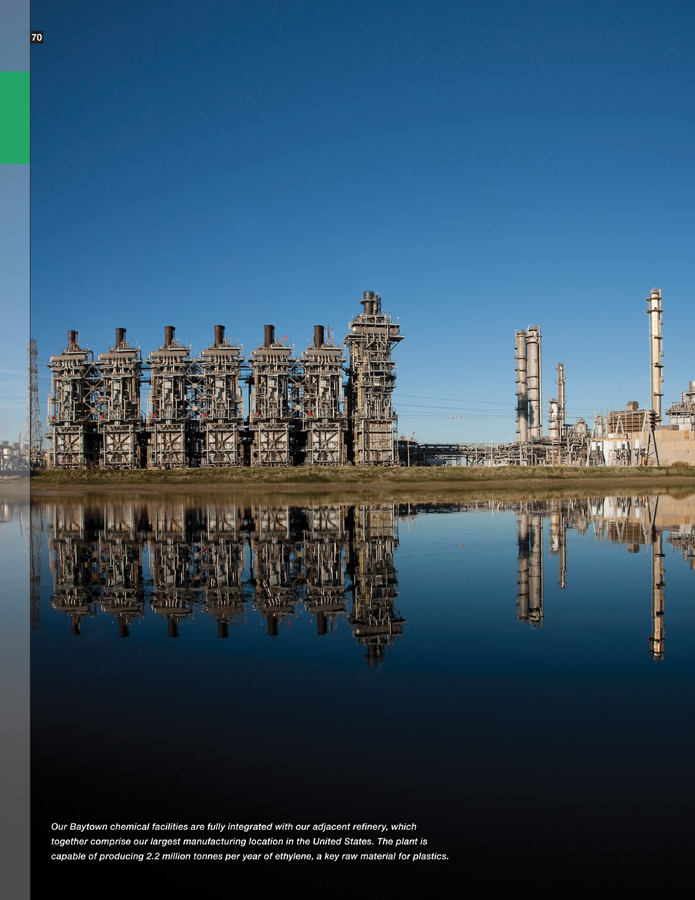
| Our Baytown chemical facilities are fully integrated with our adjacent refinery, which together comprise our largest manufacturing location in the United States. The plant is capable of producing 2.2 million tonnes per year of ethylene, a key raw material for plastics. |
 | 72 |
E x x o n M o b i l• 2 0 1 1 F i n a n c i a l & O p er a t i n g R e v i e w

ExxonMobil Chemical has highly competitive assets, an array of proprietary technologies, and global reach. Additionally, integration with ExxonMobil’s Upstream and Downstream businesses is a key differentiator that allows us to consistently outperform competition, as demonstrated by our 2011 results.
RESULTS & HIGHLIGHTS
Industry-leading safety performanceas measured by lost-time incidents, and exemplary safety performance at
our Singapore expansion project, the largest project in our history
our Singapore expansion project, the largest project in our history
Earnings of $4.4 billion,reflecting the positive impact of advantaged feedstocks, a high degree of integration
and feedstock flexibility, and record results in our specialty businesses
and feedstock flexibility, and record results in our specialty businesses
Return on average capital employed of 22.1 percent,averaging 21.8 percent over the last 10 years and outperforming competition throughout the business cycle
Prime product sales of 25.0 million tonnes,with record metallocene product sales
Capital expenditures of $1.5 billion,with selective investments in specialty business growth, high-return
efficiency projects, and low-cost debottlenecks
efficiency projects, and low-cost debottlenecks
Achieved full operational capability at Shanghai Technology Center,as a suite of advanced testing and application instruments is delivering innovative, sustainable solutions to our customers
Mechanically completed several units of our Singapore expansion,including facilities that produce polyethylene, polypropylene, aromatics, and elastomers
Began construction of a world-scale plant for manufacture of next-generation synthetic lubricant basestock,employing our proprietary metallocene catalyst technology and leveraging integration with our Baytown refining-chemical complex
| CHEMICAL STATISTICAL RECAP | 2011 | 2010 | 2009 | 2008 | 2007 | |||||||||||||||
Earnings(millions of dollars) | 4,383 | 4,913 | 2,309 | 2,957 | 4,563 | |||||||||||||||
Prime product sales(1)(thousands of tonnes) | 25,006 | 25,891 | 24,825 | 24,982 | 27,480 | |||||||||||||||
Average capital employed(2)(millions of dollars) | 19,798 | 18,680 | 16,560 | 14,525 | 13,430 | |||||||||||||||
Return on average capital employed(2)(percent) | 22.1 | 26.3 | 13.9 | 20.4 | 34.0 | |||||||||||||||
Capital expenditures(2)(millions of dollars) | 1,450 | 2,215 | 3,148 | 2,819 | 1,782 | |||||||||||||||
| (1) | Prime product sales include ExxonMobil’s share of equity-company volumes and finished-product transfers to the Downstream. | |
| (2) | See Frequently Used Terms on pages 93 through 95. |

BUSINESS OVERVIEW
ExxonMobil Chemical is one of the largest chemical companies in the world, with a unique portfolio of commodity and specialty businesses and annual sales of more than 25 million tonnes. We have manufacturing facilities in all major regions of the world, and our products serve as the building blocks for a wide variety of everyday consumer and industrial products.
Our strategy is to grow our high-return business by processing feedstocks from ExxonMobil’s refining operations and advantaged sources of natural gas liquids to manufacture chemical products for higher-value end uses. We focus on product lines where we have scale and a competitive advantage. As a result, we have a strong position in the markets we serve. Our combination of advantaged feedstocks, lower-cost processes, and premium products is unmatched in the industry, and is underpinned by a steadfast commitment to technology investment.
Two-thirds of chemical demand growth
through 2020 is expected to come from the
Asia Pacific region, driven by the rising
standard of living in developing countries.
through 2020 is expected to come from the
Asia Pacific region, driven by the rising
standard of living in developing countries.
BUSINESS ENVIRONMENT
Over the next decade, commodity petrochemical demand is expected to grow by 1.5 percentage points more than global gross domestic product (GDP). Specialty chemical markets are diverse, higher-value, and in aggregate tend to grow in line with GDP.
Worldwide petrochemical demand growth slowed in 2011 as a result of the softening global economy. We expect demand growth to improve in 2012, led by the world’s largest petrochemical market, China, which continues to show strength in key domestic manufacturing sectors. By 2020, global commodity chemical demand is projected to grow by more than 50 percent, driven by improving prosperity in developing countries. The global growth in households, particularly those in the middle class, is expected to result in the purchase of more packaged goods, appliances, cars, and clothing, many of which contain chemicals we produce.
ExxonMobil Chemical is well-positioned to meet the growing needs of China, India, and other major growth regions with our global supply network of highly competitive world-scale facilities. Feedstock flexibility allows us to capitalize on changing market factors, such as the availability of low-cost ethane feedstock arising from the expansion of North American unconventional natural gas in recent years.
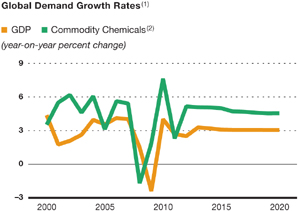
| (1) ExxonMobil estimates for chemical growth and third-party consensus opinion for GDP. | ||
| (2) | Includes polyethylene, polypropylene, and paraxylene. | |
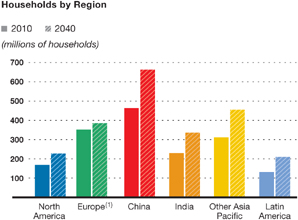
| (1) | Includes Russia/Caspian. | |
| Source: ExxonMobil,2012 The Outlook for Energy: A View to 2040 | ||
73 |  |
 | 74 |
ExxonMobil• 2011 Financial & Operating Review
CHEMICAL:
Balanced Portfolio
ExxonMobil Chemical has a unique portfolio of specialty and commodity businesses across all major geographies that gives us a significant advantage over competition.
UNIQUE PRODUCT PORTFOLIO
Our product portfolio consists of a unique combination of specialty and commodity businesses that we have developed primarily through cost-effective organic growth and the application of proprietary technology, rather than through acquisitions.
Specialties provide a stable and steadily growing earnings base. Although their volumes are generally smaller, specialties typically command a premium in the marketplace because they offer customers higher-value, sustainable solutions that enhance performance at a lower overall cost. Specialties include such products as polymers that enhance tire air retention for improved fuel efficiency, oxo alcohols used in environmentally friendly detergents, and additives and basestocks for advanced lubricants that reduce wear and prolong life of mechanical parts.
2011 record specialties earnings of $1.8 billion
are more than triple the level of 2002.
are more than triple the level of 2002.
Our commodity portfolio captures upside earnings when industry margins are strong. In addition, commodities are manufactured at integrated, world-scale facilities with substantial feedstock flexibility, which together provide a low cost structure for co-located specialties production. Commodities include olefins, polyolefins, and aromatics, which are the basic building blocks used to make recyclable containers and packaging, automotive parts, digital discs, and polyester fiber. Even within our commodity portfolio, we have further differentiated our market offerings by focusing on products that bring additional value above conventional commodities. This subset of commodity products, including those based on our proprietary metallocene catalyst platform, adds value by enhancing end-use product performance and lowering overall cost.
Another aspect of our portfolio balance is a broad geographic footprint, which enables us to provide reliable supply to all major growth regions and allows us to optimize feedstock and product sourcing in response to changing regional prices and demand.
WORLDWIDE CHEMICAL OPERATIONS
We have a significant sales presence in every region, supported by world-class competitive assets, including the following core sites:
North America
Nearly half of our current global capacity is located in North America, a region that manufactures products for all of our business lines. Our three largest U.S. chemical plants are integrated with our refineries in Baytown, Baton Rouge, and Beaumont. Integration and feedstock flexibility have allowed us to significantly outperform competitors’ earnings. The region is an important
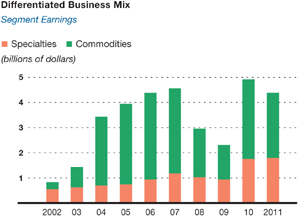 | 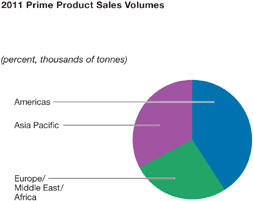 |
source of premium product supply for both domestic demand and exports. With the recent expansion of North American natural gas and associated ethane production, our large steam crackers and aromatics complexes are even more competitive, benefiting from lower feedstock and energy costs.
Our U.S. Gulf Coast plants are well-positioned to meet domestic demand and to cost-effectively export chemical products to South America, Europe, and Asia Pacific. The plant in Sarnia, Canada, is well-suited to capitalize on low-cost ethane feedstock due to its proximity to the Marcellus Shale in Pennsylvania. All of our plants in this region are part of a globally optimized circuit, which minimizes delivery cost and enables supply reliability during periodic planned maintenance activities.
Baytown and Mont Belvieu•Our Baytown, Texas, facilities together form our largest integrated refining and petrochemical complex in the United States. It is also our largest ethylene production facility in the world, and is closely integrated with our nearby Mont Belvieu polyethylene plant. Baytown houses our largest aromatics production facility in North America. In support of specialties, the Baytown plant produces butyl rubber and a wide range of hydrocarbon fluids for use in drilling applications, water treatment, and agriculture. The plant generates its own power and high-pressure steam from multiple high-efficiency cogeneration plants, which is the most cost-effective way to produce the utilities required to run the facility. Baytown is also the site of our next-generation synthetic lubricant basestock plant. This facility will utilize our proprietary metallocene catalyst process to produce premium products while using 30 percent less energy than conventional basestock production facilities.
Baton Rouge•During 102 years of operation, our Baton Rouge plant in Louisiana has expanded site facilities to provide world-scale manufacturing for nearly all of our commodity and specialty businesses. It is home to the world’s largest production facilities for halobutyl, conventional ethylene propylene diene monomer, and isopropyl alcohol. Its unique location as the farthest north facility on the Mississippi River accessible by ocean-going vessels has allowed us to safely operate throughout all the significant hurricanes of the prior decade. In 2010, we further expanded feed flexibility and energy efficiency, resulting in a broader range of economic feedstocks that we can upgrade into higher-value products while using less energy. The main facility is also heavily integrated with our two nearby polymer plants, which allows for sharing of support services and low-cost feedstocks. We expanded the polymer plants significantly in the last 10 years both in terms of production capacity and breadth of product offering, making the plants in the Baton Rouge area part of a truly unique, highly competitive complex.
Beaumont•Beaumont is the location of another one of our large integrated refining and petrochemical complexes. In addition to significant steam-cracking and derivatives capacity, the Beaumont chemical plant is a large producer of aromatics, which are integrated via import/export facilities with our other Gulf Coast sites to optimize production across the circuit. Beaumont has invested heavily in energy efficiency, with the most recent project lowering energy consumption by nearly 10 percent.
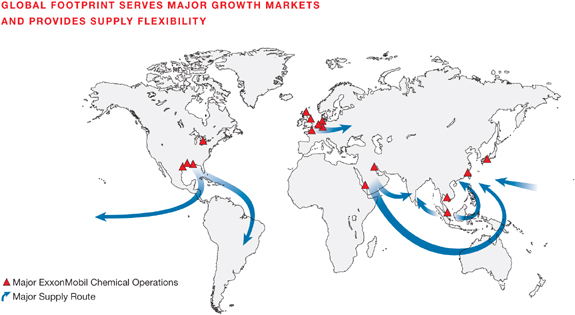
75 |  |
 | 76 |
ExxonMobil• 2011 Financial & Operating Review
Chemical: Balanced Portfolio, continued
Europe
Approximately 20 percent of our global capacity resides in Europe, with major facilities that are highly integrated with ExxonMobil refineries. We have plants located in the strategic petrochemical hubs of Rotterdam, Netherlands; and Antwerp, Belgium, which place us close to customers and provide integration with refining facilities. Our plants in Fawley, England; and Notre-Dame-de-Gravenchon, France, are also fully integrated with neighboring refineries, and are focused on expanding premium product capacity and competitiveness. In 2010, our Fawley chemical plant expanded high-value halobutyl capacity while the Notre-Dame-de-Gravenchon plant implemented a less energy-intensive manufacturing process.
Fife, United Kingdom •Our plant in Fife is uniquely integrated with our Upstream business. It utilizes natural gas liquids from North Sea gas fields as a source of feedstock. Ethylene produced at Fife is transported to our polyethylene plants at Antwerp and Meerhout, Belgium, where premium polyolefins account for a large portion of our production. The high degree of integration between the two polyethylene plants generates significant workforce synergies and cost savings.
Rotterdam, Netherlands •Our plant in Rotterdam is highly integrated with both our neighboring refinery and regional circuit. The plant collects feedstocks from ExxonMobil’s European refineries and processes them to manufacture aromatics at a world-scale facility. In addition, the site manufactures oxo alcohol-based specialty products.
Middle East
In conjunction with our joint venture partner, Saudi Basic Industries Corporation (SABIC), we have two major chemical facilities in Saudi Arabia that utilize local ethane and other feedstocks to produce chemical products for local demand and export. Manufacturing units at these sites include steam crackers and derivative units that produce polyethylene, polypropylene, and ethylene glycol.
Asia Pacific
Our Asia Pacific presence is centered in our integrated Singapore complex. In addition, we have significant integrated manufacturing facilities in Japan, Thailand, and Fujian, China.
Fujian, China • In 2009, a joint venture consisting of Saudi Aramco, Sinopec, Fujian Province, and ExxonMobil started up the Fujian facility. It is China’s first fully integrated refining, petrochemical, and fuels marketing complex with foreign company participation. The plant, coupled with a highly cost-effective supply chain, is well-situated to satisfy China’s growing demand for large-volume commodity chemicals.
Singapore •We have invested significant capital over the past 15 years and continue to expand capacity at the site, which serves as our regional hub. Once the current expansion is complete, Singapore will be our largest integrated petrochemical complex in the world.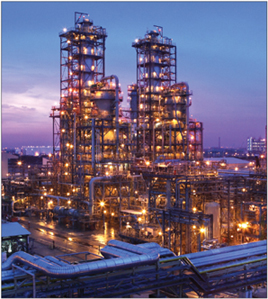 In fact, the Singapore expansion will increase our regional capacity by 50 percent, with production capacity added in six of our businesses. The Singapore complex is well-positioned to meet growing demand in China and other Asia Pacific markets.
In fact, the Singapore expansion will increase our regional capacity by 50 percent, with production capacity added in six of our businesses. The Singapore complex is well-positioned to meet growing demand in China and other Asia Pacific markets.

Our Singapore expansion units are nearly complete, including these polymer units.
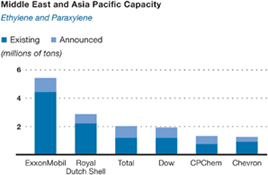
Source: IHS Chemical
CHEMICAL:
Disciplined Investing
We manage our project portfolio to enhance our ability to process advantaged feedstocks, deploy lower-cost processes, and increase premium product sales. Our advantaged projects deliver superior returns throughout the business cycle and across a wide range of market conditions.
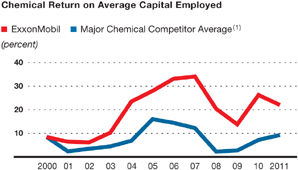
(1) Competitor values are estimated on a consistent basis with ExxonMobil
and are based on public information. Chemical segments only: Dow Chemical,
Chevron (through 2009), BP (through 2004), Royal Dutch Shell.
and are based on public information. Chemical segments only: Dow Chemical,
Chevron (through 2009), BP (through 2004), Royal Dutch Shell.
INCREASING VALUE
THROUGH DISCIPLINED INVESTMENTS
THROUGH DISCIPLINED INVESTMENTS
We invest for the long term by anticipating evolving market trends, such as the growing role of the Asia Pacific region in chemical demand. We look for sustainable advantages and avoid relying on the continuation of potentially short-term price aberrations. For example, over the years, we have invested heavily in feedstock flexibility so that we are well-positioned to capitalize on changing market dynamics.
We continue to invest in attractive debottlenecks as well as efficiency projects to reduce energy consumption and lower operating costs.
CAPTURING ASIA GROWTH AND EXPANDING SPECIALTIES
Consistent with our views on global growth, our investments are focused on meeting the growing needs of the Asian and specialties markets. For example, we are well-positioned to support rapidly growing Asia Pacific markets with our Singapore complex, as well as with competitive supplies from our assets in the Middle East and North America, and local supply from our Fujian joint venture. We are also evaluating a healthy pipeline of projects that leverage our advantaged sites around the world.
In Singapore, we are entering the final phase of the largest expansion in the history of our Chemical business. The project will more than double steam-cracking capacity, provide unparalleled feedstock flexibility, and employ our suite of energy-efficient best practices. A significant proportion of the new capacity will produce premium products. The project includes an oxo alcohol expansion, a new metallocene elastomers unit, and a new metallocene polyethylene line. As a result of this expansion, Singapore will be our first facility in the Asia Pacific region to manufacture metallocene Vistamaxx elastomers, Exceed polyethylene, and Enable polyethylene. A phased start-up and product qualification activities are under way. The investment also provides a platform for future specialties expansions.
In Saudi Arabia, SABIC and ExxonMobil continue to progress a specialty elastomers project that is expected to produce 400 thousand tonnes per year of synthetic rubber, thermoplastic polymers, and carbon black. The project, based on a platform of advantaged feedstock, will be integrated with the existing complex at Jubail Industrial City.
At our integrated Baytown complex, we began construction of a new world-scale metallocene synthetic basestock plant in 2011 to support global growth of high-performance lubricants. Start-up is expected in 2013.
Approved Chemical Capacity Additions | ||||
| Capacity | ||||
| (thousand tonnes per year) | Addition | |||
Singapore | ||||
| Ethylene | 1000 | |||
| Polyethylene | 1300 | |||
| Polypropylene | 500 | |||
| Specialty Elastomers | 300 | |||
| Benzene | 340 | |||
| Oxo Alcohol | 125 | |||
Baytown, United States | ||||
| Synthetic lubricant basestock | 50 | |||
At our Fujian, China, plant, we are assessing options to significantly debottleneck the steam cracker and derivative units.
In addition, we are evaluating options to enhance our industry-leading capability to process light feedstocks at our large integrated steam cracker complexes. This would strengthen our integrated polyethylene position and expand capability to meet global demand growth.
We are also exploring long-range advantaged growth opportunities that would further increase supply to the Asia Pacific region.
77 |  |
 | 78 |
ExxonMobil• 2011 Financial & Operating Review
CHEMICAL:
High-Impact Technologies

In 2011, our Baton Rouge chemical plant installed new
facilities to further expand feed flexibility.
facilities to further expand feed flexibility.
Technology is a key enabler of our advantaged growth. We focus on breakthroughs in the use of advantaged feedstocks, implementation of lower-cost processes, and development of premium products.
ADVANTAGED FEEDSTOCKS AND FEED FLEXIBILITY
Our proprietary technology provides us with the competitive advantages of both feedstock optimization and flexibility. The combination of integration, advanced optimization tools, and flexible process design allows our plants to quickly re-optimize operations following changes in product demand, as well as changes in feedstock quality, availability, or cost. This provides us with a significant capability to minimize raw material requirements and operating costs.
Proprietary technology expands the window of advantaged feedstocks that can be run in our facilities. Although natural gas-based feedstocks are currently more attractive, we also have the flexibility to run significantly heavier feedstocks. Refinery integration provides direct access to a range of feedstocks from refinery gas to naphtha and heavy fluids. As an example, our Singapore expansion incorporates the capability to run the broadest range of feedstocks in our steam cracker portfolio, allowing us to reduce raw material costs.
With our technology, operating expertise, integrated facilities, and global supply capability, we are able to adapt quickly to changing market conditions. As a result, we generate higher returns on average capital employed than competition.
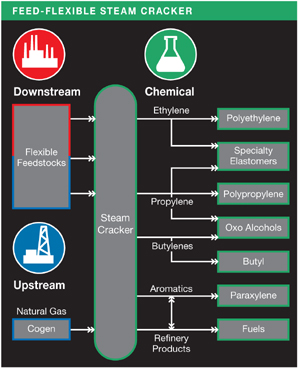
LOWER COST MANUFACTURING PROCESSES
We improve manufacturing cost performance by using advanced processes and catalyst technologies, which provide energy efficiency, greater reliability, and increased yields. For example, our efforts to optimize polyethylene reactor technology have increased reactor throughput more than threefold since the early 1980s.
We also implement step-change improvement projects related to capacity, feed flexibility, and energy efficiency. As an example, our breakthrough metallocene manufacturing process reduces operational costs and catalyst usage while also consuming less fuel and electricity. It is being applied at our Baytown plant to manufacture a key component for next-generation synthetic lubricants.
Steam crackers are the core units of our chemical plants, and integration with ExxonMobil refineries and gas processing provides feedstock alternatives and by-product dispositions.
PREMIUM PRODUCTS
Breakthroughs in catalyst and product technologies help us to deliver new, higher-value, and more sustainable products that provide performance advantages and customer savings. These benefits include increased strength, ease of processing, lower raw material usage, and improved energy efficiency.
We have a long-term commitment to developing high-impact technology platforms with broad applicability across our product portfolio. For example, we have employed our metallocene catalyst technology across our plastics, elastomers, and synthetics offerings with additional applications under development. These products deliver sustainability benefits to customers, including reduced material consumption and increased energy efficiency. They also help to improve performance and reduce costs.
Our proprietary product and application technologies let us tailor innovative solutions to meet customer needs, allowing them to realize the full value and performance attributes of our products. We support customer uses of our products via premier technology centers around the world, including the recently completed Shanghai Technology Center.
We continue to look for ways to improve the sustainability of our product portfolio, including development of leading-edge specialty products like Vistamaxx elastomers and ongoing improvements to existing product lines. For example, innovations to the polyethylene used for heavy-duty shipping bags have enabled customers to reduce bag thickness by up to 50 percent over the last 20 years, while at the same time improving product strength and ease of processing.
As a result of these efforts to develop premium products, the sales growth of our metallocene-based products has significantly outpaced that of commodities.
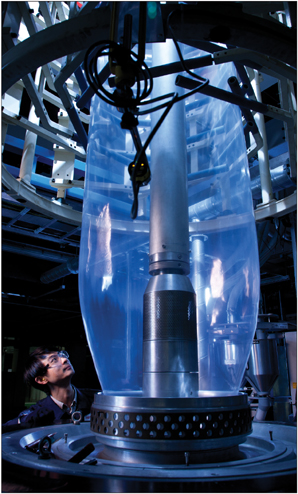
A scientist in the fully operational Shanghai Technology Center identifies opportunities to optimize high-performance metallocene polyethylene products.
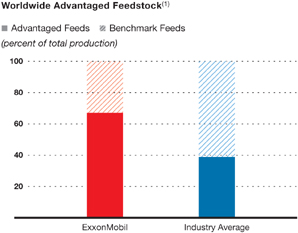
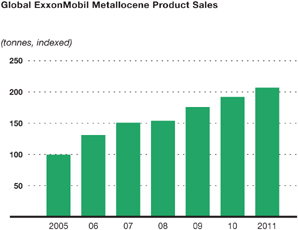
(1) Ethylene feedstock, 2011 data; ExxonMobil data includes ExxonMobil share of joint-venture production.
Source: IHS Chemical; 2011 industry data is full-year estimate as of September 2011.
79 |  |
 | 80 |
ExxonMobil• 2011 Financial & Operating Review
CHEMICAL:
Operational Excellence
Our disciplined approach to achieving strong performance in the areas of safety, reliability, quality, and energy efficiency continues to increase the contribution of our assets.

Specialized training and well-equipped control rooms are essential components of
operational excellence.
operational excellence.
DISCIPLINED PROCESSES
We continually improve our business practices and systems to ensure the uncompromising integrity of our operations. ExxonMobil’s Operations Integrity Management System (OIMS), combined with rigorous methods to minimize process risk, have provided us with the tools to consistently achieve industry-leading safety performance.
A focus on the fundamentals of reliability and quality enables us to maximize yields and value in the market. Comprehensive global systems allow for effective implementation of best practices and new technology across our manufacturing circuit, which enables continuous operational improvement.
Another cornerstone of operational excellence is energy efficiency. Efforts to improve energy-intensive processes, such as steam cracking, contribute significant operating cost savings and additional competitive advantages.
As a result of our disciplined approach to operational excellence, our Chemical business achieved solid performance in safety, environmental compliance, and reliability in 2011. The reliability of our operations is the foundation for our reputation as a trusted global supplier. It is also a key reason why our average capacity utilization and energy efficiency are better than industry.
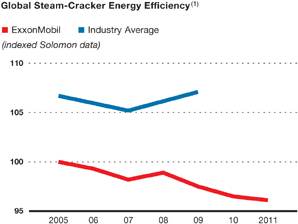
(1) Solomon Associates data available for odd years only; 2011 data unavailable at publication.
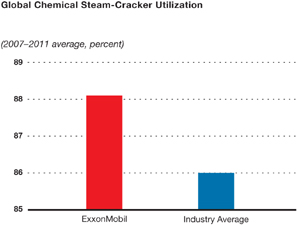
Source: IHS Chemical
CHEMICAL:
Global Integration
ExxonMobil’s integrated business model allows us to upgrade each molecule to its highest value as we leverage the advantages of a global functional organization and co-located manufacturing.
MAXIMIZING MOLECULE VALUE ACROSS THE CIRCUIT
The benefit derived from integration is an important driver in our ability to outperform competitors in the key financial metrics of earnings and return on average capital employed. Our integrated model allows us to upgrade secure sources of molecules to their highest value. World-scale integrated assets have substantial flexibility to process a wide range of feedstocks. As a result, we are able to optimize molecules and product streams in real-time across our refineries, chemical steam crackers, and other units.
More than 90 percent of our operated chemical
plant capacity is integrated with our refineries or
natural gas processing plants.
plant capacity is integrated with our refineries or
natural gas processing plants.
Feed flexibility is enabled by the high degree of manufacturing integration. For example, ethane and propane co-products from our Upstream U.K. natural gas processing activities are consumed as steam-cracker feedstock in our nearby chemical plant in Fife. Integration with our refineries provides numerous interconnections that allow our steam crackers to consume a wide range of feedstocks while also providing outlets for steam-cracker by-products that do not have chemical markets. These various streams provide alternatives that enable us to maximize the value of each molecule.
INTEGRATION DELIVERS ADVANTAGES
In addition to providing secure sources of feedstock and enabling by-product optimization, integration generates significant cost efficiencies from scale, shared infrastructure, and common support. Integration also provides a unified approach to personnel recruiting and development, which fosters a culture that promotes the general interest of the Corporation. Overall, the extent of our scale and integration provides a structural advantage that is difficult for competitors to replicate.
Integration with our Upstream North Sea production provides advantaged feedstock for ethylene production at our Fife, United Kingdom, facility. The ethylene serves as feedstock for our polyethylene plants in Europe, which produce premium chemical products.
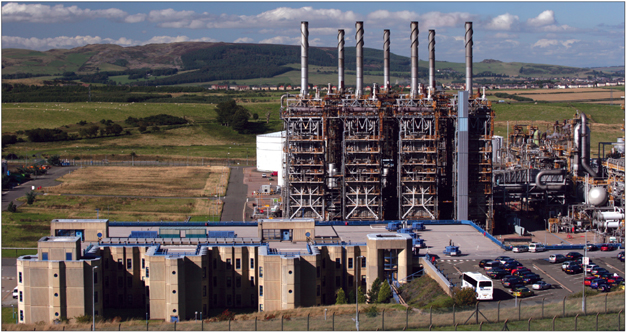
81 |  |
 | 82 |
ExxonMobil• 2011 Financial & Operating Review
CHEMICAL OPERATING STATISTICS
LARGE/INTEGRATED PRODUCTION COMPLEX CAPACITY – AT YEAR-END 2011(1)(2)
| (millions of tonnes per year) | Ethylene | Polyethylene | Polypropylene | Paraxylene | Additional Products | ||||||||||||||
North America | |||||||||||||||||||
| Baton Rouge, Louisiana | 1.0 | 1.3 | 0.4 | – | P B E A F O | ||||||||||||||
| Baytown, Texas | 2.2 | – | 0.8 | 0.6 | P B F | ||||||||||||||
| Beaumont, Texas | 0.8 | 1.0 | – | 0.3 | P S | ||||||||||||||
| Mont Belvieu, Texas | – | 1.0 | – | – | |||||||||||||||
| Sarnia, Ontario | 0.3 | 0.5 | – | – | P F O | ||||||||||||||
Europe | |||||||||||||||||||
| Antwerp, Belgium | 0.5 | 0.4 | – | – | P F O | ||||||||||||||
| Fawley, United Kingdom | – | – | – | – | B F O | ||||||||||||||
| Fife, United Kingdom | 0.4 | – | – | – | |||||||||||||||
| Meerhout, Belgium | – | 0.5 | – | – | |||||||||||||||
| Notre-Dame-de- Gravenchon, France | 0.4 | 0.4 | 0.3 | – | P B E A O S Z | ||||||||||||||
| Rotterdam, Netherlands | – | – | – | 0.7 | O | ||||||||||||||
Middle East | |||||||||||||||||||
| Al Jubail, Saudi Arabia | 0.6 | 0.6 | – | – | |||||||||||||||
| Yanbu, Saudi Arabia | 1.0 | 0.7 | 0.2 | – | P | ||||||||||||||
Asia Pacific | |||||||||||||||||||
| Fujian, China | 0.2 | 0.2 | 0.1 | 0.2 | P | ||||||||||||||
| Kawasaki, Japan | 0.5 | 0.1 | – | – | P B A F | ||||||||||||||
| Singapore | 0.9 | 0.6 | 0.4 | 0.9 | P F O Z | ||||||||||||||
| Sriracha, Thailand | – | – | – | 0.5 | F | ||||||||||||||
| All other | – | – | – | 0.6 | |||||||||||||||
Total worldwide | 8.8 | 7.3 | 2.2 | 3.8 | |||||||||||||||
P Propylene B Butyl E Specialty Elastomers A Adhesive Polymers F Fluids O Oxo Alcohols S Synthetics Z Petroleum Additives
| (1) | Based on size or breadth of product slate. | |
| (2) | Capacity reflects 100 percent for operations of ExxonMobil and majority-owned subsidiaries. For companies owned 50 percent or less, capacity is ExxonMobil’s interest. |
OTHER MANUFACTURING LOCATIONS – AT YEAR-END 2011(1)
| Location | Product | ||
| North America | |||
| Bayway, New Jersey | ▲ | l | |
| Belleville, Ontario | u | ||
| Chalmette, Louisiana | n | ||
| Dartmouth, Nova Scotia | l | ||
| Edison, New Jersey | l | ||
| LaGrange, Georgia | u | ||
| Pensacola, Florida | ▲ | ||
| Shawnee, Oklahoma | u | ||
| (1) | Includes joint-venture plants. | |
| (2) | Facility mothballed. | |
| (3) | Announced divestment. |
| Location | Product | ||
| Europe | |||
| Augusta, Italy | n | ||
| Berre, France | l | ||
| Brindisi, Italy | u | ||
| Cologne, Germany | ▲ | l | |
| Fos-sur-Mer, France | n | ||
| Geleen, Netherlands | ▲ | ||
| Karlsruhe, Germany | n | ||
| Kerkrade, Netherlands | u | ||
| Newport, United Kingdom | ▲ | ||
| Trecate, Italy | l | ||
| Vado Ligure, Italy | l | ||
| Virton, Belgium | u | ||
| Location | Product | ||||
| Asia Pacific | |||||
| Adelaide, Australia(2) | l | ||||
| Altona, Australia | n | ||||
| Chiba, Japan | n | ||||
| Gumi, South Korea(3) | u | ||||
| Jinshan, China | ▲ | ||||
| Kashima, Japan | ▲ | ||||
| Nasu, Japan(3) | u | ||||
| Panyu, China | l | ||||
| Sakai, Japan | n | l | |||
| Wakayama, Japan | n | ||||
| Latin America | |||||
| Campana, Argentina(3) | n | l | |||
| Managua, Nicaragua(3) | l | ||||
| Paulinia, Brazil | l | ||||
| Rio de Janeiro, Brazil | l | ||||
n Olefins/Aromatics ▲ Polymers l Other Chemicals u Films
VOLUMES
| Includes ExxonMobil’s share of equity companies | 2011 | 2010 | 2009 | 2008 | 2007 | |||||||||||||||
| Worldwide Production Volumes(thousands of tonnes) | ||||||||||||||||||||
| Ethylene | 7,855 | 7,973 | 7,381 | 7,540 | 8,155 | |||||||||||||||
| Polyethylene | 6,482 | 6,506 | 6,120 | 6,088 | 6,693 | |||||||||||||||
| Polypropylene | 1,870 | 1,945 | 1,864 | 1,897 | 1,897 | |||||||||||||||
| Paraxylene | 2,935 | 2,973 | 2,758 | 2,472 | 2,995 | |||||||||||||||
| Prime Product Sales Volumes(1)by Region(thousands of tonnes) | ||||||||||||||||||||
Americas(2) | 10,268 | 10,826 | 10,665 | 10,628 | 12,034 | |||||||||||||||
| Europe/Middle East/Africa | 6,555 | 6,654 | 6,433 | 6,635 | 7,463 | |||||||||||||||
| Asia Pacific | 8,183 | 8,411 | 7,727 | 7,719 | 7,983 | |||||||||||||||
Total worldwide | 25,006 | 25,891 | 24,825 | 24,982 | 27,480 | |||||||||||||||
| Prime Product Sales Volumes(1)by Business(thousands of tonnes) | ||||||||||||||||||||
| Specialties | 5,471 | 5,586 | 5,183 | 5,618 | 6,237 | |||||||||||||||
| Commodities | 19,535 | 20,305 | 19,642 | 19,364 | 21,243 | |||||||||||||||
Total | 25,006 | 25,891 | 24,825 | 24,982 | 27,480 | |||||||||||||||
| (1) | Prime product sales include ExxonMobil’s share of equity-company volumes and finished product transfers to the Downstream. | |
| (2) | Includes North America and Latin America. |
83 |  |
 | 84 |
ExxonMobil• 2011 Financial & Operating Review
Financial Information
FINANCIAL HIGHLIGHTS
| (millions of dollars, unless noted) | 2011 | 2010 | 2009 | 2008 | 2007 | |||||||||||||||
| Net income attributable to ExxonMobil | 41,060 | 30,460 | 19,280 | 45,220 | 40,610 | |||||||||||||||
Cash flow from operations and asset sales(1) | 66,478 | 51,674 | 29,983 | 65,710 | 56,206 | |||||||||||||||
Capital and exploration expenditures(1) | 36,766 | 32,226 | 27,092 | 26,143 | 20,853 | |||||||||||||||
| Research and development costs | 1,044 | 1,012 | 1,050 | 847 | 814 | |||||||||||||||
| Total debt at year end | 17,033 | 15,014 | 9,605 | 9,425 | 9,566 | |||||||||||||||
Average capital employed(1) | 170,721 | 145,217 | 125,050 | 129,683 | 128,760 | |||||||||||||||
| Market valuation at year end | 401,249 | 364,035 | 322,329 | 397,239 | 504,220 | |||||||||||||||
| Regular employees at year end (thousands) | 82.1 | 83.6 | 80.7 | 79.9 | 80.8 | |||||||||||||||
KEY FINANCIAL RATIOS
| 2011 | 2010 | 2009 | 2008 | 2007 | ||||||||||||||||
Return on average capital employed(1)(percent) | 24.2 | 21.7 | 16.3 | 34.2 | 31.8 | |||||||||||||||
Earnings to average ExxonMobil share of equity(percent) | 27.3 | 23.7 | 17.3 | 38.5 | 34.5 | |||||||||||||||
Debt to capital(2)(percent) | 9.6 | 9.0 | 7.7 | 7.4 | 7.1 | |||||||||||||||
Net debt to capital(3)(percent) | 2.6 | 4.5 | (1.0 | ) | (23.0 | ) | (24.0 | ) | ||||||||||||
Current assets to current liabilities(times) | 0.94 | 0.94 | 1.06 | 1.47 | 1.47 | |||||||||||||||
Fixed charge coverage(times) | 53.2 | 42.2 | 25.8 | 54.6 | 51.6 | |||||||||||||||
DIVIDEND AND SHAREHOLDER RETURN INFORMATION
| 2011 | 2010 | 2009 | 2008 | 2007 | ||||||||||||||||
Dividends per common share(dollars) | 1.85 | 1.74 | 1.66 | 1.55 | 1.37 | |||||||||||||||
Dividends per share growth(annual percent) | 6.3 | 4.8 | 7.1 | 13.1 | 7.0 | |||||||||||||||
Number of common shares outstanding(millions) | ||||||||||||||||||||
| Average | 4,870 | 4,885 | 4,832 | 5,194 | 5,557 | |||||||||||||||
| Average – assuming dilution | 4,875 | 4,897 | 4,848 | 5,221 | 5,594 | |||||||||||||||
| Year end | 4,734 | 4,979 | 4,727 | 4,976 | 5,382 | |||||||||||||||
Total shareholder return(1)(annual percent) | 18.7 | 10.1 | (12.6 | ) | (13.2 | ) | 24.3 | |||||||||||||
Common stock purchases(millions of dollars) | 22,055 | 13,093 | 19,703 | 35,734 | 31,822 | |||||||||||||||
Market quotations for common stock(dollars) | ||||||||||||||||||||
| High | 88.23 | 73.69 | 82.73 | 96.12 | 95.27 | |||||||||||||||
| Low | 67.03 | 55.94 | 61.86 | 56.51 | 69.02 | |||||||||||||||
| Average daily close | 79.71 | 64.99 | 70.95 | 82.68 | 83.23 | |||||||||||||||
| Year-end close | 84.76 | 73.12 | 68.19 | 79.83 | 93.69 | |||||||||||||||
| (1) | See Frequently Used Terms on pages 93 through 95. | |
| (2) | Debt includes short-term and long-term debt. Capital includes short-term and long-term debt and total equity. | |
| (3) | Debt net of cash and cash equivalents, excluding restricted cash. |
FUNCTIONAL EARNINGS(1)
| 2011 Quarters | ||||||||||||||||||||||||||||||||||||
| (millions of dollars) | First | Second | Third | Fourth | 2011 | 2010 | 2009 | 2008 | 2007 | |||||||||||||||||||||||||||
Earnings (U.S. GAAP) | ||||||||||||||||||||||||||||||||||||
Upstream | ||||||||||||||||||||||||||||||||||||
| United States | 1,279 | 1,449 | 1,184 | 1,184 | 5,096 | 4,272 | 2,893 | 6,243 | 4,870 | |||||||||||||||||||||||||||
| Non-U.S. | 7,396 | 7,092 | 7,210 | 7,645 | 29,343 | 19,825 | 14,214 | 29,159 | 21,627 | |||||||||||||||||||||||||||
| Total | 8,675 | 8,541 | 8,394 | 8,829 | 34,439 | 24,097 | 17,107 | 35,402 | 26,497 | |||||||||||||||||||||||||||
Downstream | ||||||||||||||||||||||||||||||||||||
| United States | 694 | 734 | 810 | 30 | 2,268 | 770 | (153 | ) | 1,649 | 4,120 | ||||||||||||||||||||||||||
| Non-U.S. | 405 | 622 | 769 | 395 | 2,191 | 2,797 | 1,934 | 6,502 | 5,453 | |||||||||||||||||||||||||||
| Total | 1,099 | 1,356 | 1,579 | 425 | 4,459 | 3,567 | 1,781 | 8,151 | 9,573 | |||||||||||||||||||||||||||
Chemical | ||||||||||||||||||||||||||||||||||||
| United States | 669 | 625 | 538 | 383 | 2,215 | 2,422 | 769 | 724 | 1,181 | |||||||||||||||||||||||||||
| Non-U.S. | 847 | 696 | 465 | 160 | 2,168 | 2,491 | 1,540 | 2,233 | 3,382 | |||||||||||||||||||||||||||
| Total | 1,516 | 1,321 | 1,003 | 543 | 4,383 | 4,913 | 2,309 | 2,957 | 4,563 | |||||||||||||||||||||||||||
Corporate and financing | (640 | ) | (538 | ) | (646 | ) | (397 | ) | (2,221 | ) | (2,117 | ) | (1,917 | ) | (1,290 | ) | (23 | ) | ||||||||||||||||||
Net income attributable to ExxonMobil (U.S. GAAP) | 10,650 | 10,680 | 10,330 | 9,400 | 41,060 | 30,460 | 19,280 | 45,220 | 40,610 | |||||||||||||||||||||||||||
Special Items | ||||||||||||||||||||||||||||||||||||
Upstream | ||||||||||||||||||||||||||||||||||||
| Non-U.S. | – | – | – | – | – | – | – | 1,620 | – | |||||||||||||||||||||||||||
Corporate and financing | – | – | – | – | – | – | (140 | ) | (460 | ) | – | |||||||||||||||||||||||||
Corporate total | – | – | – | – | – | – | (140 | ) | 1,160 | – | ||||||||||||||||||||||||||
Earnings Excluding Special Items(2) | ||||||||||||||||||||||||||||||||||||
Upstream | ||||||||||||||||||||||||||||||||||||
| United States | 1,279 | 1,449 | 1,184 | 1,184 | 5,096 | 4,272 | 2,893 | 6,243 | 4,870 | |||||||||||||||||||||||||||
| Non-U.S. | 7,396 | 7,092 | 7,210 | 7,645 | 29,343 | 19,825 | 14,214 | 27,539 | 21,627 | |||||||||||||||||||||||||||
| Total | 8,675 | 8,541 | 8,394 | 8,829 | 34,439 | 24,097 | 17,107 | 33,782 | 26,497 | |||||||||||||||||||||||||||
Downstream | ||||||||||||||||||||||||||||||||||||
| United States | 694 | 734 | 810 | 30 | 2,268 | 770 | (153 | ) | 1,649 | 4,120 | ||||||||||||||||||||||||||
| Non-U.S. | 405 | 622 | 769 | 395 | 2,191 | 2,797 | 1,934 | 6,502 | 5,453 | |||||||||||||||||||||||||||
| Total | 1,099 | 1,356 | 1,579 | 425 | 4,459 | 3,567 | 1,781 | 8,151 | 9,573 | |||||||||||||||||||||||||||
Chemical | ||||||||||||||||||||||||||||||||||||
| United States | 669 | 625 | 538 | 383 | 2,215 | 2,422 | 769 | 724 | 1,181 | |||||||||||||||||||||||||||
| Non-U.S. | 847 | 696 | 465 | 160 | 2,168 | 2,491 | 1,540 | 2,233 | 3,382 | |||||||||||||||||||||||||||
| Total | 1,516 | 1,321 | 1,003 | 543 | 4,383 | 4,913 | 2,309 | 2,957 | 4,563 | |||||||||||||||||||||||||||
Corporate and financing | (640 | ) | (538 | ) | (646 | ) | (397 | ) | (2,221 | ) | (2,117 | ) | (1,777 | ) | (830 | ) | (23 | ) | ||||||||||||||||||
Corporate total | 10,650 | 10,680 | 10,330 | 9,400 | 41,060 | 30,460 | 19,420 | 44,060 | 40,610 | |||||||||||||||||||||||||||
| (1) | Total corporate earnings means net income attributable to ExxonMobil (U.S. GAAP) from the consolidated income statement. Unless indicated, references to earnings, special items, Upstream, Downstream, Chemical, and Corporate and Financing segment earnings, and earnings per share are ExxonMobil’s share after excluding amounts attributable to noncontrolling interests. | |
| (2) | See Frequently Used Terms on pages 93 through 95. |
85 |  |
 | 86 |
ExxonMobil• 2011 Financial & Operating Review
RETURN ON AVERAGE CAPITAL EMPLOYED(1)BY BUSINESS
| (percent) | 2011 | 2010 | 2009 | 2008 | 2007 | |||||||||||||||
Upstream | ||||||||||||||||||||
| United States | 9.3 | 12.2 | 18.2 | 42.6 | 34.7 | |||||||||||||||
| Non-U.S. | 39.2 | 29.0 | 24.8 | 56.7 | 43.7 | |||||||||||||||
| Total | 26.5 | 23.3 | 23.4 | 53.6 | 41.7 | |||||||||||||||
Downstream | ||||||||||||||||||||
| United States | 42.5 | 12.5 | (2.1 | ) | 23.7 | 65.1 | ||||||||||||||
| Non-U.S. | 12.1 | 15.6 | 10.9 | 34.8 | 28.7 | |||||||||||||||
| Total | 19.1 | 14.8 | 7.1 | 31.8 | 37.8 | |||||||||||||||
Chemical | ||||||||||||||||||||
| United States | 46.2 | 53.0 | 17.6 | 16.0 | 24.9 | |||||||||||||||
| Non-U.S. | 14.4 | 17.6 | 12.6 | 22.4 | 39.0 | |||||||||||||||
| Total | 22.1 | 26.3 | 13.9 | 20.4 | 34.0 | |||||||||||||||
Corporate and financing | N.A. | N.A. | N.A. | N.A. | N.A. | |||||||||||||||
Corporate total | 24.2 | 21.7 | 16.3 | 34.2 | 31.8 | |||||||||||||||
| (1) | Capital employed consists of ExxonMobil’s share of equity and consolidated debt, including ExxonMobil’s share of amounts applicable to equity companies. See Frequently Used Terms on pages 93 through 95. |
AVERAGE CAPITAL EMPLOYED(1)BY BUSINESS
| (millions of dollars) | 2011 | 2010 | 2009 | 2008 | 2007 | |||||||||||||||
Upstream | ||||||||||||||||||||
| United States | 54,994 | 34,969 | 15,865 | 14,651 | 14,026 | |||||||||||||||
| Non-U.S. | 74,813 | 68,318 | 57,336 | 51,413 | 49,539 | |||||||||||||||
| Total | 129,807 | 103,287 | 73,201 | 66,064 | 63,565 | |||||||||||||||
Downstream | ||||||||||||||||||||
| United States | 5,340 | 6,154 | 7,306 | 6,963 | 6,331 | |||||||||||||||
| Non-U.S. | 18,048 | 17,976 | 17,793 | 18,664 | 18,983 | |||||||||||||||
| Total | 23,388 | 24,130 | 25,099 | 25,627 | 25,314 | |||||||||||||||
Chemical | ||||||||||||||||||||
| United States | 4,791 | 4,566 | 4,370 | 4,535 | 4,748 | |||||||||||||||
| Non-U.S. | 15,007 | 14,114 | 12,190 | 9,990 | 8,682 | |||||||||||||||
| Total | 19,798 | 18,680 | 16,560 | 14,525 | 13,430 | |||||||||||||||
Corporate and financing | (2,272 | ) | (880 | ) | 10,190 | 23,467 | 26,451 | |||||||||||||
Corporate total | 170,721 | 145,217 | 125,050 | 129,683 | 128,760 | |||||||||||||||
Average capital employed applicable to equity companies included above | 31,626 | 30,524 | 27,684 | 25,651 | 24,267 | |||||||||||||||
| (1) | Average capital employed is the average of beginning-of-year and end-of-year business segment capital employed, including ExxonMobil’s share of amounts applicable to equity companies. See Frequently Used Terms on pages 93 through 95. |
NET INVESTMENT IN PROPERTY, PLANT AND EQUIPMENT AT YEAR END
| (millions of dollars) | 2011 | 2010 | 2009 | 2008 | 2007 | |||||||||||||||
Upstream | ||||||||||||||||||||
| United States | 75,140 | 69,003 | 19,601 | 17,920 | 16,714 | |||||||||||||||
| Non-U.S. | 88,835 | 79,149 | 68,718 | 55,493 | 56,810 | |||||||||||||||
| Total | 163,975 | 148,152 | 88,319 | 73,413 | 73,524 | |||||||||||||||
Downstream | ||||||||||||||||||||
| United States | 9,516 | 10,585 | 11,013 | 10,492 | 9,705 | |||||||||||||||
| Non-U.S. | 19,285 | 19,510 | 19,486 | 18,762 | 20,443 | |||||||||||||||
| Total | 28,801 | 30,095 | 30,499 | 29,254 | 30,148 | |||||||||||||||
Chemical | ||||||||||||||||||||
| United States | 3,928 | 4,068 | 4,274 | 4,396 | 4,448 | |||||||||||||||
| Non-U.S. | 10,541 | 10,187 | 9,237 | 7,034 | 5,623 | |||||||||||||||
| Total | 14,469 | 14,255 | 13,511 | 11,430 | 10,071 | |||||||||||||||
Other | 7,419 | 7,046 | 6,787 | 7,249 | 7,126 | |||||||||||||||
Total net investment | 214,664 | 199,548 | 139,116 | 121,346 | 120,869 | |||||||||||||||
DEPRECIATION AND DEPLETION EXPENSES
| (millions of dollars) | 2011 | 2010 | 2009 | 2008 | 2007 | |||||||||||||||
Upstream | ||||||||||||||||||||
| United States | 4,879 | 3,506 | 1,768 | 1,391 | 1,469 | |||||||||||||||
| Non-U.S. | 7,021 | 7,574 | 6,376 | 7,266 | 7,126 | |||||||||||||||
| Total | 11,900 | 11,080 | 8,144 | 8,657 | 8,595 | |||||||||||||||
Downstream | ||||||||||||||||||||
| United States | 650 | 681 | 687 | 656 | 639 | |||||||||||||||
| Non-U.S. | 1,560 | 1,565 | 1,665 | 1,672 | 1,662 | |||||||||||||||
| Total | 2,210 | 2,246 | 2,352 | 2,328 | 2,301 | |||||||||||||||
Chemical | ||||||||||||||||||||
| United States | 380 | 421 | 400 | 410 | 405 | |||||||||||||||
| Non-U.S. | 458 | 432 | 457 | 422 | 418 | |||||||||||||||
| Total | 838 | 853 | 857 | 832 | 823 | |||||||||||||||
Other | 635 | 581 | 564 | 562 | 531 | |||||||||||||||
Total depreciation and depletion expenses | 15,583 | 14,760 | 11,917 | 12,379 | 12,250 | |||||||||||||||
OPERATING COSTS(1)
| (millions of dollars) | 2011 | 2010 | 2009 | 2008 | 2007 | |||||||||||||||
| Production and manufacturing expenses | 40,268 | 35,792 | 33,027 | 37,905 | 31,885 | |||||||||||||||
| Selling, general, and administrative | 14,983 | 14,683 | 14,735 | 15,873 | 14,890 | |||||||||||||||
| Depreciation and depletion | 15,583 | 14,760 | 11,917 | 12,379 | 12,250 | |||||||||||||||
| Exploration | 2,081 | 2,144 | 2,021 | 1,451 | 1,469 | |||||||||||||||
| Subtotal | 72,915 | 67,379 | 61,700 | 67,608 | 60,494 | |||||||||||||||
| ExxonMobil’s share of equity company expenses | 11,401 | 9,049 | 6,670 | 7,204 | 5,619 | |||||||||||||||
Total operating costs | 84,316 | 76,428 | 68,370 | 74,812 | 66,113 | |||||||||||||||
| (1) | See Frequently Used Terms on pages 93 through 95. |
87 |  |
 | 88 |
ExxonMobil• 2011 Financial & Operating Review
CAPITAL AND EXPLORATION EXPENDITURES(1)
| (millions of dollars) | 2011 | 2010 | 2009 | 2008 | 2007 | |||||||||||||||
Upstream | ||||||||||||||||||||
| Exploration | ||||||||||||||||||||
| United States | 2,720 | 1,607 | 735 | 734 | 415 | |||||||||||||||
| Non-U.S. | 2,744 | 2,514 | 2,983 | 2,137 | 1,494 | |||||||||||||||
| Total | 5,464 | 4,121 | 3,718 | 2,871 | 1,909 | |||||||||||||||
Production(2) | ||||||||||||||||||||
| United States | 8,021 | 4,742 | 2,850 | 2,600 | 1,792 | |||||||||||||||
| Non-U.S. | 19,387 | 18,214 | 13,877 | 14,011 | 11,913 | |||||||||||||||
| Total | 27,408 | 22,956 | 16,727 | 16,611 | 13,705 | |||||||||||||||
| Power and Coal | ||||||||||||||||||||
| United States | – | – | – | – | 5 | |||||||||||||||
| Non-U.S. | 219 | 242 | 259 | 252 | 105 | |||||||||||||||
| Total | 219 | 242 | 259 | 252 | 110 | |||||||||||||||
Total Upstream | 33,091 | 27,319 | 20,704 | 19,734 | 15,724 | |||||||||||||||
Downstream | ||||||||||||||||||||
| Refining | ||||||||||||||||||||
| United States | 370 | 833 | 1,300 | 1,430 | 906 | |||||||||||||||
| Non-U.S. | 1,088 | 1,000 | 1,146 | 1,248 | 1,267 | |||||||||||||||
| Total | 1,458 | 1,833 | 2,446 | 2,678 | 2,173 | |||||||||||||||
| Marketing | ||||||||||||||||||||
| United States | 117 | 98 | 171 | 176 | 201 | |||||||||||||||
| Non-U.S. | 514 | 520 | 536 | 638 | 876 | |||||||||||||||
| Total | 631 | 618 | 707 | 814 | 1,077 | |||||||||||||||
| Pipeline/Marine | ||||||||||||||||||||
| United States | 31 | 51 | 40 | 30 | 21 | |||||||||||||||
| Non-U.S. | – | 3 | 3 | 7 | 32 | |||||||||||||||
| Total | 31 | 54 | 43 | 37 | 53 | |||||||||||||||
Total Downstream | 2,120 | 2,505 | 3,196 | 3,529 | 3,303 | |||||||||||||||
Chemical | ||||||||||||||||||||
| United States | 290 | 279 | 319 | 441 | 360 | |||||||||||||||
| Non-U.S. | 1,160 | 1,936 | 2,829 | 2,378 | 1,422 | |||||||||||||||
Total Chemical | 1,450 | 2,215 | 3,148 | 2,819 | 1,782 | |||||||||||||||
Other | ||||||||||||||||||||
| United States | 105 | 187 | 44 | 61 | 44 | |||||||||||||||
| Non-U.S. | – | – | – | – | – | |||||||||||||||
Total other | 105 | 187 | 44 | 61 | 44 | |||||||||||||||
Total capital and exploration expenditures | 36,766 | 32,226 | 27,092 | 26,143 | 20,853 | |||||||||||||||
| (1) | See Frequently Used Terms on pages 93 through 95. | |
| (2) | Including related transportation. |
TOTAL CAPITAL AND EXPLORATION EXPENDITURES BY GEOGRAPHY
| (millions of dollars) | 2011 | 2010 | 2009 | 2008 | 2007 | |||||||||||||||
| United States | 11,654 | 7,797 | 5,459 | 5,472 | 3,744 | |||||||||||||||
| Canada/Latin America | 6,186 | 5,732 | 3,448 | 1,926 | 1,522 | |||||||||||||||
| Europe | 2,914 | 3,901 | 3,251 | 3,727 | 4,042 | |||||||||||||||
| Africa | 4,291 | 4,915 | 6,182 | 5,422 | 3,639 | |||||||||||||||
| Asia | 7,066 | 6,693 | 7,535 | 8,845 | 7,479 | |||||||||||||||
| Australia/Oceania | 4,655 | 3,188 | 1,217 | 751 | 427 | |||||||||||||||
Total worldwide | 36,766 | 32,226 | 27,092 | 26,143 | 20,853 | |||||||||||||||
DISTRIBUTION OF CAPITAL AND EXPLORATION EXPENDITURES
| (millions of dollars) | 2011 | 2010 | 2009 | 2008 | 2007 | |||||||||||||||
Consolidated Companies’ Expenditures | ||||||||||||||||||||
| Capital expenditures | 32,425 | 27,343 | 22,441 | 19,841 | 15,242 | |||||||||||||||
| Exploration costs charged to expense | ||||||||||||||||||||
| United States | 268 | 283 | 219 | 189 | 280 | |||||||||||||||
| Non-U.S. | 1,802 | 1,855 | 1,795 | 1,252 | 1,177 | |||||||||||||||
Depreciation on support equipment(1) | 11 | 6 | 7 | 10 | 12 | |||||||||||||||
Total exploration expenses | 2,081 | 2,144 | 2,021 | 1,451 | 1,469 | |||||||||||||||
Total consolidated companies’ capital and exploration expenditures (excluding depreciation on support equipment) | 34,495 | 29,481 | 24,455 | 21,282 | 16,699 | |||||||||||||||
ExxonMobil’s Share of Non-Consolidated | ||||||||||||||||||||
Companies’ Expenditures | ||||||||||||||||||||
| Capital expenditures | 2,248 | 2,720 | 2,624 | 4,845 | 4,122 | |||||||||||||||
| Exploration costs charged to expense | 23 | 25 | 13 | 16 | 32 | |||||||||||||||
Total non-consolidated companies’ capital and exploration expenditures | 2,271 | 2,745 | 2,637 | 4,861 | 4,154 | |||||||||||||||
Total capital and exploration expenditures | 36,766 | 32,226 | 27,092 | 26,143 | 20,853 | |||||||||||||||
| (1) | Not included as part of total capital and exploration expenditures, but included as part of exploration expenses, including dry holes, in the Summary Statement of Income, page 90. |
89 |  |
 | 90 |
ExxonMobil• 2011 Financial & Operating Review
SUMMARY STATEMENT OF INCOME
| (millions of dollars) | 2011 | 2010 | 2009 | 2008 | 2007 | |||||||||||||||
Revenues and Other Income | ||||||||||||||||||||
Sales and other operating revenue(1) | 467,029 | 370,125 | 301,500 | 459,579 | 390,328 | |||||||||||||||
| Income from equity affiliates | 15,289 | 10,677 | 7,143 | 11,081 | 8,901 | |||||||||||||||
Other income(2) | 4,111 | 2,419 | 1,943 | 6,699 | 5,323 | |||||||||||||||
Total revenues and other income | 486,429 | 383,221 | 310,586 | 477,359 | 404,552 | |||||||||||||||
Costs and Other Deductions | ||||||||||||||||||||
| Crude oil and product purchases | 266,534 | 197,959 | 152,806 | 249,454 | 199,498 | |||||||||||||||
| Production and manufacturing expenses | 40,268 | 35,792 | 33,027 | 37,905 | 31,885 | |||||||||||||||
| Selling, general, and administrative expenses | 14,983 | 14,683 | 14,735 | 15,873 | 14,890 | |||||||||||||||
| Depreciation and depletion | 15,583 | 14,760 | 11,917 | 12,379 | 12,250 | |||||||||||||||
| Exploration expenses, including dry holes | 2,081 | 2,144 | 2,021 | 1,451 | 1,469 | |||||||||||||||
| Interest expense | 247 | 259 | 548 | 673 | 400 | |||||||||||||||
Sales-based taxes(1) | 33,503 | 28,547 | 25,936 | 34,508 | 31,728 | |||||||||||||||
| Other taxes and duties | 39,973 | 36,118 | 34,819 | 41,719 | 40,953 | |||||||||||||||
Total costs and other deductions | 413,172 | 330,262 | 275,809 | 393,962 | 333,073 | |||||||||||||||
| Income before income taxes | 73,257 | 52,959 | 34,777 | 83,397 | 71,479 | |||||||||||||||
| Income taxes | 31,051 | 21,561 | 15,119 | 36,530 | 29,864 | |||||||||||||||
Net income including noncontrolling interests | 42,206 | 31,398 | 19,658 | 46,867 | 41,615 | |||||||||||||||
| Net income attributable to noncontrolling interests | 1,146 | 938 | 378 | 1,647 | 1,005 | |||||||||||||||
Net income attributable to ExxonMobil | 41,060 | 30,460 | 19,280 | 45,220 | 40,610 | |||||||||||||||
Earnings per common share(dollars) | 8.43 | 6.24 | 3.99 | 8.70 | 7.31 | |||||||||||||||
Earnings per common share – assuming dilution (dollars) | 8.42 | 6.22 | 3.98 | 8.66 | 7.26 | |||||||||||||||
| (1) | Sales and other operating revenue includes sales-based taxes of $33,503 million for 2011, $28,547 million for 2010, $25,936 million for 2009, $34,508 million for 2008, and $31,728 million for 2007. | |
| (2) | Other income for 2008 includes a $62 million gain from the sale of a non-U.S. investment and a related $143 million foreign exchange loss. | |
| The information in the Summary Statement of Income (for 2009 to 2011), the Summary Balance Sheet (for 2010 and 2011), and the Summary Statement of Cash Flows (for 2009 to 2011), shown on pages 90 through 92, corresponds to the information in the Consolidated Statement of Income, Consolidated Balance Sheet, and the Consolidated Statement of Cash Flows in the financial statements of ExxonMobil’s 2011 Form 10-K. See also Management’s Discussion and Analysis of Financial Condition and Results of Operations and other information in the Financial Section of the 2011 Form 10-K. | ||
SUMMARY BALANCE SHEET AT YEAR END
| (millions of dollars) | 2011 | 2010 | 2009 | 2008 | 2007 | |||||||||||||||
Assets | ||||||||||||||||||||
| Current assets | ||||||||||||||||||||
| Cash and cash equivalents | 12,664 | 7,825 | 10,693 | 31,437 | 33,981 | |||||||||||||||
| Cash and cash equivalents – restricted | 404 | 628 | – | – | – | |||||||||||||||
| Notes and accounts receivable, | ||||||||||||||||||||
| less estimated doubtful amounts | 38,642 | 32,284 | 27,645 | 24,702 | 36,450 | |||||||||||||||
| Inventories | ||||||||||||||||||||
| Crude oil, products and merchandise | 11,665 | 9,852 | 8,718 | 9,331 | 8,863 | |||||||||||||||
| Materials and supplies | 3,359 | 3,124 | 2,835 | 2,315 | 2,226 | |||||||||||||||
| Other current assets | 6,229 | 5,271 | 5,344 | 4,481 | 4,443 | |||||||||||||||
| Total current assets | 72,963 | 58,984 | 55,235 | 72,266 | 85,963 | |||||||||||||||
| Investments, advances and long-term receivables | 34,333 | 35,338 | 31,665 | 28,556 | 28,194 | |||||||||||||||
| Property, plant and equipment, at cost, | ||||||||||||||||||||
| less accumulated depreciation and depletion | 214,664 | 199,548 | 139,116 | 121,346 | 120,869 | |||||||||||||||
| Other assets, including intangibles, net | 9,092 | 8,640 | 7,307 | 5,884 | 7,056 | |||||||||||||||
Total assets | 331,052 | 302,510 | 233,323 | 228,052 | 242,082 | |||||||||||||||
Liabilities | ||||||||||||||||||||
| Current liabilities | ||||||||||||||||||||
| Notes and loans payable | 7,711 | 2,787 | 2,476 | 2,400 | 2,383 | |||||||||||||||
| Accounts payable and accrued liabilities | 57,067 | 50,034 | 41,275 | 36,643 | 45,275 | |||||||||||||||
| Income taxes payable | 12,727 | 9,812 | 8,310 | 10,057 | 10,654 | |||||||||||||||
| Total current liabilities | 77,505 | 62,633 | 52,061 | 49,100 | 58,312 | |||||||||||||||
| Long-term debt | 9,322 | 12,227 | 7,129 | 7,025 | 7,183 | |||||||||||||||
| Postretirement benefits reserves | 24,994 | 19,367 | 17,942 | 20,729 | 13,278 | |||||||||||||||
| Deferred income tax liabilities | 36,618 | 35,150 | 23,148 | 19,726 | 22,899 | |||||||||||||||
| Other long-term obligations | 21,869 | 20,454 | 17,651 | 13,949 | 14,366 | |||||||||||||||
Total liabilities | 170,308 | 149,831 | 117,931 | 110,529 | 116,038 | |||||||||||||||
| Commitments and contingencies | See footnote 1 | |||||||||||||||||||
Equity | ||||||||||||||||||||
| Common stock without par value | 9,512 | 9,371 | 5,503 | 5,314 | 4,933 | |||||||||||||||
| Earnings reinvested | 330,939 | 298,899 | 276,937 | 265,680 | 228,518 | |||||||||||||||
| Accumulated other comprehensive income | ||||||||||||||||||||
| Cumulative foreign exchange translation adjustment | 4,168 | 5,011 | 4,402 | 1,146 | 7,972 | |||||||||||||||
| Postretirement benefits reserves adjustment | (13,291 | ) | (9,889 | ) | (9,863 | ) | (11,077 | ) | (5,983 | ) | ||||||||||
| Unrealized gain on cash flow hedges | – | 55 | – | – | – | |||||||||||||||
| Common stock held in treasury | (176,932 | ) | (156,608 | ) | (166,410 | ) | (148,098 | ) | (113,678 | ) | ||||||||||
| ExxonMobil share of equity | 154,396 | 146,839 | 110,569 | 112,965 | 121,762 | |||||||||||||||
| Noncontrolling interests | 6,348 | 5,840 | 4,823 | 4,558 | 4,282 | |||||||||||||||
Total equity | 160,744 | 152,679 | 115,392 | 117,523 | 126,044 | |||||||||||||||
Total liabilities and equity | 331,052 | 302,510 | 233,323 | 228,052 | 242,082 | |||||||||||||||
| (1) | For more information, please refer to Note 15 in the Financial Section of ExxonMobil’s 2011 Form 10-K. |
The information in the Summary Statement of Income (for 2009 to 2011), the Summary Balance Sheet (for 2010 and 2011), and the Summary Statement of Cash Flows (for 2009 to 2011), shown on pages 90 through 92, corresponds to the information in the Consolidated Statement of Income, Consolidated Balance Sheet, and the Consolidated Statement of Cash Flows in the financial statements of ExxonMobil’s 2011 Form 10-K. See also Management’s Discussion and Analysis of Financial Condition and Results of Operations and other information in the Financial Section of the 2011 Form 10-K.
91 |  |
 | 92 |
ExxonMobil• 2011 Financial & Operating Review
SUMMARY STATEMENT OF CASH FLOWS
| (millions of dollars) | 2011 | 2010 | 2009 | 2008 | 2007 | |||||||||||||||
Cash Flows from Operating Activities | ||||||||||||||||||||
| Net income including noncontrolling interests | 42,206 | 31,398 | 19,658 | 46,867 | 41,615 | |||||||||||||||
| Adjustments for noncash transactions | ||||||||||||||||||||
| Depreciation and depletion | 15,583 | 14,760 | 11,917 | 12,379 | 12,250 | |||||||||||||||
| Deferred income tax charges/(credits) | 142 | (1,135 | ) | – | 1,399 | 124 | ||||||||||||||
| Postretirement benefits expense in excess of/ (less than) net payments | 544 | 1,700 | (1,722 | ) | 57 | (1,314 | ) | |||||||||||||
| Other long-term obligation provisions in excess of/(less than) payments | (151 | ) | 160 | 731 | (63 | ) | 1,065 | |||||||||||||
| Dividends received greater than/(less than) | ||||||||||||||||||||
| equity in current earnings of equity companies | (273 | ) | (596 | ) | (483 | ) | 921 | (714 | ) | |||||||||||
| Changes in operational working capital, excluding cash and debt | ||||||||||||||||||||
| Reduction/(increase) – Notes and accounts receivable | (7,906 | ) | (5,863 | ) | (3,170 | ) | 8,641 | (5,441 | ) | |||||||||||
| – Inventories | (2,208 | ) | (1,148 | ) | 459 | (1,285 | ) | 72 | ||||||||||||
| – Other current assets | 222 | 913 | 132 | (509 | ) | 280 | ||||||||||||||
| Increase/(reduction) – Accounts and other payables | 8,880 | 9,943 | 1,420 | (5,415 | ) | 6,228 | ||||||||||||||
| Net (gain) on asset sales | (2,842 | ) | (1,401 | ) | (488 | ) | (3,757 | ) | (2,217 | ) | ||||||||||
| All other items – net | 1,148 | (318 | ) | (16 | ) | 490 | 54 | |||||||||||||
Net cash provided by operating activities | 55,345 | 48,413 | 28,438 | 59,725 | 52,002 | |||||||||||||||
Cash Flows from Investing Activities | ||||||||||||||||||||
| Additions to property, plant and equipment | (30,975 | ) | (26,871 | ) | (22,491 | ) | (19,318 | ) | (15,387 | ) | ||||||||||
| Proceeds associated with sales of subsidiaries, property, plant and equipment, and sales and returns of investments | 11,133 | 3,261 | 1,545 | 5,985 | 4,204 | |||||||||||||||
| Decrease/(increase) in restricted cash and cash equivalents | 224 | (628 | ) | – | – | 4,604 | ||||||||||||||
| Additional investments and advances | (3,586 | ) | (1,239 | ) | (2,752 | ) | (2,495 | ) | (3,038 | ) | ||||||||||
| Collection of advances | 1,119 | 1,133 | 724 | 574 | 391 | |||||||||||||||
| Additions to marketable securities | (1,754 | ) | (15 | ) | (16 | ) | (2,113 | ) | (646 | ) | ||||||||||
| Sales of marketable securities | 1,674 | 155 | 571 | 1,868 | 144 | |||||||||||||||
Net cash used in investing activities | (22,165 | ) | (24,204 | ) | (22,419 | ) | (15,499 | ) | (9,728 | ) | ||||||||||
Cash Flows from Financing Activities | ||||||||||||||||||||
| Additions to long-term debt | 702 | 1,143 | 225 | 79 | 592 | |||||||||||||||
| Reductions in long-term debt | (266 | ) | (6,224 | ) | (68 | ) | (192 | ) | (209 | ) | ||||||||||
| Additions to short-term debt | 1,063 | 598 | 1,336 | 1,067 | 1,211 | |||||||||||||||
| Reductions in short-term debt | (1,103 | ) | (2,436 | ) | (1,575 | ) | (1,624 | ) | (809 | ) | ||||||||||
| Additions/(reductions) in debt with three months or less maturity | 1,561 | 709 | (71 | ) | 143 | (187 | ) | |||||||||||||
| Cash dividends to ExxonMobil shareholders | (9,020 | ) | (8,498 | ) | (8,023 | ) | (8,058 | ) | (7,621 | ) | ||||||||||
| Cash dividends to noncontrolling interests | (306 | ) | (281 | ) | (280 | ) | (375 | ) | (289 | ) | ||||||||||
| Changes in noncontrolling interests | (16 | ) | (7 | ) | (113 | ) | (419 | ) | (659 | ) | ||||||||||
| Tax benefits related to stock-based awards | 260 | 122 | 237 | 333 | 369 | |||||||||||||||
| Common stock acquired | (22,055 | ) | (13,093 | ) | (19,703 | ) | (35,734 | ) | (31,822 | ) | ||||||||||
| Common stock sold | 924 | 1,043 | 752 | 753 | 1,079 | |||||||||||||||
Net cash used in financing activities | (28,256 | ) | (26,924 | ) | (27,283 | ) | (44,027 | ) | (38,345 | ) | ||||||||||
| Effects of exchange rate changes on cash | (85 | ) | (153 | ) | 520 | (2,743 | ) | 1,808 | ||||||||||||
| Increase/(decrease) in cash and cash equivalents | 4,839 | (2,868 | ) | (20,744 | ) | (2,544 | ) | 5,737 | ||||||||||||
| Cash and cash equivalents at beginning of year | 7,825 | 10,693 | 31,437 | 33,981 | 28,244 | |||||||||||||||
Cash and cash equivalents at end of year | 12,664 | 7,825 | 10,693 | 31,437 | 33,981 | |||||||||||||||
Noncash Transactions
The Corporation acquired all the outstanding equity of XTO Energy Inc. in an all-stock transaction valued at $24,659 million in 2010 (see Note 19 in the Financial Section of ExxonMobil’s 2011 Form 10-K).
The information in the Summary Statement of Income (for 2009 to 2011), the Summary Balance Sheet (for 2010 and 2011), and the Summary Statement of Cash Flows (for 2009 to 2011), shown on pages 90 through 92, corresponds to the information in the Consolidated Statement of Income, Consolidated Balance Sheet, and the Consolidated Statement of Cash Flows in the financial statements of ExxonMobil’s 2011 Form 10-K. See also Management’s Discussion and Analysis of Financial Condition and Results of Operations and other information in the Financial Section of the 2011 Form 10-K.
Frequently Used Terms
Listed below are definitions of several of ExxonMobil’s key business and financial performance measures and other terms. These definitions are provided to facilitate understanding of the terms and their calculation. In the case of financial measures that we believe constitute “non-GAAP financial measures” under Securities and Exchange Commission Regulation G, we provide a reconciliation to the most comparable Generally Accepted Accounting Principles (GAAP) measure and other information required by that rule.
Earnings Excluding Special Items•In addition to reporting U.S. GAAP defined net income, ExxonMobil also presents a measure of earnings that excludes earnings from special items quantified and described in our quarterly and annual earnings press releases. Earnings excluding special items is a non-GAAP financial measure, and is included to facilitate comparisons of base business performance across periods. A reconciliation to net income attributable to ExxonMobil is shown on page 85. We also refer to earnings excluding special items as normalized earnings. Earnings per share amounts use the same average common shares outstanding as used for the calculation of earnings per common share and earnings per common share – assuming dilution.
Total Shareholder Return•Measures the change in value of an investment in stock over a specified period of time, assuming dividend reinvestment. We calculate shareholder return over a particular measurement period by: dividing (1) the sum of (a) the cumulative value of dividends received during the measurement period, assuming reinvestment, plus (b) the difference between the stock price at the end and at the beginning of the measurement period; by (2) the stock price at the beginning of the measurement period. For this purpose, we assume dividends are reinvested in stock at market prices at approximately the same time actual dividends are paid. Shareholder return is usually quoted on an annualized basis.
Capital and Exploration Expenditures (Capex)•Represents the combined total of additions at cost to property, plant and equipment and exploration expenses on a before-tax basis from the Summary Statement of Income. ExxonMobil’s Capex includes its share of similar costs for equity companies. Capex excludes depreciation on the cost of exploration support equipment and facilities recorded to property, plant and equipment when acquired. While ExxonMobil’s management is responsible for all investments and elements of net income, particular focus is placed on managing the controllable aspects of this group of expenditures.
Entitlement Volume Effects•Production Sharing Contract (PSC) net interest reductions are contractual reductions in ExxonMobil’s share of production volumes covered by PSCs. These reductions typically occur when cumulative investment returns or production volumes achieve thresholds as specified in the PSCs. Once a net interest reduction has occurred, it typically will not be reversed by subsequent events, such as lower crude oil prices. Price and Spend Impacts on Volumes are fluctuations in ExxonMobil’s share of production volumes caused by changes in oil and gas prices or spending levels from one period to another. For example, at higher prices, fewer barrels are required for ExxonMobil to recover its costs. According to the terms of contractual arrangements or government royalty regimes, price or spending variability can increase or decrease royalty burdens and/or volumes attributable to ExxonMobil. These effects generally vary from period to period with field spending patterns or market prices for crude oil or natural gas.
Heavy Oil and Oil Sands•Heavy oil, for the purpose of this report, includes heavy oil, extra heavy oil, and bitumen, as defined by the World Petroleum Congress in 1987 based on American Petroleum Institute (API) gravity and viscosity at reservoir conditions. Heavy oil has an API gravity between 10 and 22.3 degrees. The API gravity of extra heavy oil and bitumen is less than 10 degrees. Extra heavy oil has a viscosity less than 10 thousand centipoise, whereas the viscosity of bitumen is greater than 10 thousand centipoise. The term “oil sands” is used to indicate heavy oil (generally bitumen) that is recovered in a mining operation.
Proved Reserves•Proved reserves in this publication for 2009 and later years are based on current SEC definitions, but for prior years, the referenced proved reserve volumes are determined on bases that differ from SEC definitions in effect at the time. Specifically, for years prior to 2009 included in our five-year average replacement ratio, reserves are determined using the SEC pricing basis but including oil sands and our pro-rata share of equity company reserves for all periods. Prior to 2009, oil sands and equity company reserves were not included in proved oil and gas reserves as defined by the SEC. In addition, prior to 2009, the SEC defined price as the market price on December 31; beginning in 2009, the SEC changed the definition to the average of the market prices on the first day of each calendar month during the year. For years prior to 2009 included in our 18 straight years of at least 100-percent replacement, reserves are determined using the price and cost assumptions we use in managing the business, not the historical prices used in SEC definitions. Reserves determined on ExxonMobil’s pricing basis also include oil sands and equity company reserves for all periods.
Resources, Resource Base, and Recoverable Resources•Along with similar terms used in this report, refers to the total remaining estimated quantities of oil and gas that are expected to be ultimately recoverable. ExxonMobil refers to new discoveries and acquisitions of discovered resources as resource additions. The resource base includes quantities of oil and gas that are not yet classified as proved reserves, but which ExxonMobil believes will likely be moved into the proved reserves category and produced in the future. The term “resource base” is not intended to correspond to SEC definitions such as “probable” or “possible” reserves.
Proved Reserves Replacement Ratio• The reserves replacement ratio is calculated for a specified period utilizing the applicable proved oil-equivalent reserves additions divided by oil-equivalent production. See “Proved Reserves” above.
| CASH FLOW FROM OPERATIONS AND ASSET SALES | 2011 | 2010 | 2009 | 2008 | 2007 | |||||||||||||||
(millions of dollars) | ||||||||||||||||||||
| Net cash provided by operating activities | 55,345 | 48,413 | 28,438 | 59,725 | 52,002 | |||||||||||||||
| Proceeds associated with sales of subsidiaries, property, plant and equipment, and sales and returns of investments | 11,133 | 3,261 | 1,545 | 5,985 | 4,204 | |||||||||||||||
| Cash flow from operations and asset sales | 66,478 | 51,674 | 29,983 | 65,710 | 56,206 | |||||||||||||||
Cash flow from operations and asset sales is the sum of the net cash provided by operating activities and proceeds associated with sales of subsidiaries, property, plant and equipment, and sales and returns of investments from the Summary Statement of Cash Flows. This cash flow is the total sources of cash from both operating the Corporation’s assets and from the divesting of assets. The Corporation employs a long-standing and regular disciplined review process to ensure that all assets are contributing to the Corporation’s strategic objectives. Assets are divested when they are no longer meeting these objectives or are worth considerably more to others. Because of the regular nature of this activity, we believe it is useful for investors to consider proceeds associated with asset sales together with cash provided by operating activities when evaluating cash available for investment in the business and financing activities, including shareholder distributions.
93 |  |
 | 94 |
ExxonMobil• 2011 Financial & Operating Review
| PROVED RESERVES REPLACEMENT COSTS | 2011 | 2010 | 2009 | 2008 | 2007 | |||||||||||||||
Costs incurred(millions of dollars) | ||||||||||||||||||||
| Property acquisition costs | 3,787 | 45,461 | 1,285 | 663 | 194 | |||||||||||||||
| Exploration costs | 2,503 | 3,055 | 3,111 | 2,272 | 1,762 | |||||||||||||||
| Development costs | 25,690 | 23,210 | 17,130 | 14,633 | 11,570 | |||||||||||||||
| Total costs incurred | 31,980 | 71,726 | 21,526 | 17,568 | 13,526 | |||||||||||||||
Proved oil-equivalent reserves additions(millions of barrels) | ||||||||||||||||||||
| Revisions | 281 | 505 | 383 | 690 | 1,405 | |||||||||||||||
| Improved recovery | – | 5 | 15 | 7 | 36 | |||||||||||||||
| Extensions/discoveries | 1,613 | 516 | 1,091 | 1,423 | 248 | |||||||||||||||
| Purchases | 67 | 2,510 | 1 | – | 2 | |||||||||||||||
| Total oil-equivalent reserves additions | 1,961 | 3,536 | 1,490 | 2,120 | 1,691 | |||||||||||||||
Proved reserves replacement costs(dollars per barrel) | 16.31 | 20.28 | 14.45 | 8.29 | 8.00 | |||||||||||||||
Proved reserves replacement costs per oil-equivalent barrel is a performance measure ratio and includes costs incurred in property acquisition and exploration, plus costs incurred in development activities, divided by proved oil-equivalent reserves additions, excluding sales. Unless otherwise specified, ExxonMobil reports these costs based on proved reserves using SEC historical prices and costs. See “Proved Reserves” on previous page.
| EXPLORATION RESOURCE ADDITION COST | 2011 | 2010 | 2009 | 2008 | 2007 | |||||||||||||||
Exploration portion of Upstream Capex(millions of dollars) | 5,464 | 4,121 | 3,718 | 2,871 | 1,909 | |||||||||||||||
Exploration resource additions(millions of oil-equivalent barrels) | 3,906 | 4,725 | 2,860 | 2,230 | 1,995 | |||||||||||||||
Exploration resource addition cost per OEB(dollars) | 1.40 | 0.87 | 1.30 | 1.29 | 0.96 | |||||||||||||||
Exploration resource addition cost per oil-equivalent barrel is a performance measure that is calculated using the Exploration portion of Upstream capital and exploration expenditures (Capex) divided by exploration resource additions (in oil-equivalent barrels – OEB). ExxonMobil refers to new discoveries, and the non-proved portion of discovered resources that were acquired, as exploration resource additions. Exploration resource additions include quantities of oil and gas that are not yet classified as proved reserves, but which ExxonMobil believes will likely be moved into the proved reserves category and produced in the future. The impact of the XTO Energy Inc. merger transaction is excluded in 2010.
| OPERATING COSTS | 2011 | 2010 | 2009 | 2008 | 2007 | |||||||||||||||
(millions of dollars) | ||||||||||||||||||||
Reconciliation of Operating Costs | ||||||||||||||||||||
| From ExxonMobil’s Consolidated Statement of Income | ||||||||||||||||||||
| Total costs and other deductions | 413,172 | 330,262 | 275,809 | 393,962 | 333,073 | |||||||||||||||
| Less: | ||||||||||||||||||||
| Crude oil and product purchases | 266,534 | 197,959 | 152,806 | 249,454 | 199,498 | |||||||||||||||
| Interest expense | 247 | 259 | 548 | 673 | 400 | |||||||||||||||
| Sales-based taxes | 33,503 | 28,547 | 25,936 | 34,508 | 31,728 | |||||||||||||||
| Other taxes and duties | 39,973 | 36,118 | 34,819 | 41,719 | 40,953 | |||||||||||||||
| Subtotal | 72,915 | 67,379 | 61,700 | 67,608 | 60,494 | |||||||||||||||
| ExxonMobil’s share of equity-company expenses | 11,401 | 9,049 | 6,670 | 7,204 | 5,619 | |||||||||||||||
| Total operating costs | 84,316 | 76,428 | 68,370 | 74,812 | 66,113 | |||||||||||||||
Components of Operating Costs | ||||||||||||||||||||
| From ExxonMobil’s Consolidated Statement of Income | ||||||||||||||||||||
| Production and manufacturing expenses | 40,268 | 35,792 | 33,027 | 37,905 | 31,885 | |||||||||||||||
| Selling, general, and administrative expenses | 14,983 | 14,683 | 14,735 | 15,873 | 14,890 | |||||||||||||||
| Depreciation and depletion | 15,583 | 14,760 | 11,917 | 12,379 | 12,250 | |||||||||||||||
| Exploration expenses, including dry holes | 2,081 | 2,144 | 2,021 | 1,451 | 1,469 | |||||||||||||||
| Subtotal | 72,915 | 67,379 | 61,700 | 67,608 | 60,494 | |||||||||||||||
| ExxonMobil’s share of equity-company expenses | 11,401 | 9,049 | 6,670 | 7,204 | 5,619 | |||||||||||||||
| Total operating costs | 84,316 | 76,428 | 68,370 | 74,812 | 66,113 | |||||||||||||||
Operating costs are the costs during the period to produce, manufacture, and otherwise prepare the company’s products for sale – including energy, staffing, and maintenance costs. They exclude the cost of raw materials, taxes, and interest expense and are on a before-tax basis. While ExxonMobil’s management is responsible for all revenue and expense elements of net income, operating costs, as defined above, represent the expenses most directly under management’s control and therefore, are useful for investors and ExxonMobil management in evaluating management’s performance.
| CAPITAL EMPLOYED | 2011 | 2010 | 2009 | 2008 | 2007 | |||||||||||||||
(millions of dollars) | ||||||||||||||||||||
Business Uses: Asset and Liability Perspective | ||||||||||||||||||||
| Total assets | 331,052 | 302,510 | 233,323 | 228,052 | 242,082 | |||||||||||||||
| Less liabilities and noncontrolling interests share of assets and liabilities | ||||||||||||||||||||
| Total current liabilities excluding notes and loans payable | (69,794 | ) | (59,846 | ) | (49,585 | ) | (46,700 | ) | (55,929 | ) | ||||||||||
| Total long-term liabilities excluding long-term debt | (83,481 | ) | (74,971 | ) | (58,741 | ) | (54,404 | ) | (50,543 | ) | ||||||||||
| Noncontrolling interests share of assets and liabilities | (7,314 | ) | (6,532 | ) | (5,642 | ) | (6,044 | ) | (5,332 | ) | ||||||||||
| Add ExxonMobil share of debt-financed equity-company net assets | 4,943 | 4,875 | 5,043 | 4,798 | 3,386 | |||||||||||||||
| Total capital employed | 175,406 | 166,036 | 124,398 | 125,702 | 133,664 | |||||||||||||||
Total Corporate Sources: Debt and Equity Perspective | ||||||||||||||||||||
| Notes and loans payable | 7,711 | 2,787 | 2,476 | 2,400 | 2,383 | |||||||||||||||
| Long-term debt | 9,322 | 12,227 | 7,129 | 7,025 | 7,183 | |||||||||||||||
| ExxonMobil share of equity | 154,396 | 146,839 | 110,569 | 112,965 | 121,762 | |||||||||||||||
| Less noncontrolling interests share of total debt | (966 | ) | (692 | ) | (819 | ) | (1,486 | ) | (1,050 | ) | ||||||||||
| Add ExxonMobil share of equity-company debt | 4,943 | 4,875 | 5,043 | 4,798 | 3,386 | |||||||||||||||
| Total capital employed | 175,406 | 166,036 | 124,398 | 125,702 | 133,664 | |||||||||||||||
Capital employed is a measure of net investment. When viewed from the perspective of how the capital is used by the businesses, it includes ExxonMobil’s net share of property, plant and equipment and other assets less liabilities, excluding both short-term and long-term debt. When viewed from the perspective of the sources of capital employed in total for the Corporation, it includes ExxonMobil’s share of total debt and equity. Both of these views include ExxonMobil’s share of amounts applicable to equity companies, which the Corporation believes should be included to provide a more comprehensive measure of capital employed.
| RETURN ON AVERAGE CAPITAL EMPLOYED (ROCE) | 2011 | 2010 | 2009 | 2008 | 2007 | |||||||||||||||
(millions of dollars) | ||||||||||||||||||||
| Net income attributable to ExxonMobil | 41,060 | 30,460 | 19,280 | 45,220 | 40,610 | |||||||||||||||
| Financing costs (after tax) | ||||||||||||||||||||
| Gross third-party debt | (153 | ) | (803 | ) | (303 | ) | (343 | ) | (339 | ) | ||||||||||
| ExxonMobil share of equity companies | (219 | ) | (333 | ) | (285 | ) | (325 | ) | (204 | ) | ||||||||||
| All other financing costs – net | 116 | 35 | (483 | ) | 1,485 | 268 | ||||||||||||||
| Total financing costs | (256 | ) | (1,101 | ) | (1,071 | ) | 817 | (275 | ) | |||||||||||
| Earnings excluding financing costs | 41,316 | 31,561 | 20,351 | 44,403 | 40,885 | |||||||||||||||
| Average capital employed | 170,721 | 145,217 | 125,050 | 129,683 | 128,760 | |||||||||||||||
| Return on average capital employed – corporate total | 24.2 | % | 21.7 | % | 16.3 | % | 34.2 | % | 31.8 | % | ||||||||||
ROCE is a performance measure ratio. From the perspective of the business segments, ROCE is annual business segment earnings divided by average business segment capital employed (average of beginning and end-of-year amounts). These segment earnings include ExxonMobil’s share of segment earnings of equity companies, consistent with our capital employed definition, and exclude the cost of financing. The Corporation’s total ROCE is net income attributable to ExxonMobil excluding the after-tax cost of financing, divided by total corporate average capital employed. The Corporation has consistently applied its ROCE definition for many years and views it as the best measure of historical capital productivity in our capital-intensive, long-term industry, both to evaluate management’s performance and to demonstrate to shareholders that capital has been used wisely over the long term. Additional measures, which are more cash flow based, are used to make investment decisions.
| DISTRIBUTIONS TO SHAREHOLDERS | 2011 | 2010 | 2009 | 2008 | 2007 | |||||||||||||||
(millions of dollars) | ||||||||||||||||||||
| Dividends paid to ExxonMobil shareholders | 9,020 | 8,498 | 8,023 | 8,058 | 7,621 | |||||||||||||||
| Cost of shares purchased to reduce shares outstanding | 20,000 | 11,200 | 18,000 | 32,000 | 28,000 | |||||||||||||||
| Distributions to ExxonMobil shareholders | 29,020 | 19,698 | 26,023 | 40,058 | 35,621 | |||||||||||||||
| Memo: Gross cost of shares purchased to offset shares issued under benefit plans and programs | 2,055 | 1,893 | 1,703 | 3,734 | 3,822 | |||||||||||||||
The Corporation distributes cash to shareholders in the form of both dividends and share purchases. Shares are purchased both to reduce shares outstanding and to offset shares issued in conjunction with company benefit plans and programs. For purposes of calculating distributions to shareholders, the Corporation only includes the cost of those shares purchased to reduce shares outstanding.
95 |  |
 | 96 |
ExxonMobil• 2011 Financial & Operating Review
Index
| Acreage | 10-11, 22, 24, 26-27, 29, 32 | |
| Africa | 31-34 | |
| Asia Pacific | 35-39, 55, 59, 73, 76-77 | |
| Australia/Oceania | 9-10, 12, 19, 40-41 | |
| Balance Sheet | 91 | |
| Business strategies | 2-3 | |
| Canada | 9-14, 19-21, 25-27, 58, 65, 75 | |
| Capital and exploration expenditures | 1, 8, 54, 72, 84, 88-89, 93 | |
| Capital employed | 1, 8, 54, 60, 72, 77, 84, 86, 95 | |
| Cash flow | 84, 92-93 | |
| Cash Flow Statement | 92 | |
| Chemical capacity | 77, 82 | |
| Chemical products | 79 | |
| Chemical results | 72 | |
| Chemical volumes | 83 | |
| Depreciation and depletion | 50-51, 87, 89 | |
| Dividend and shareholder distributions | 1, 84, 95 | |
| Downstream results | 54 | |
| Earnings | 1, 8, 50-51, 54, 72, 85, 90 | |
| Earnings per barrel | 50-51 | |
| Energy Outlook | 9, 55, 73 | |
| Entitlement volumes | 19, 93 | |
| Europe | 28-30, 58, 76 | |
| Exploration resource addition cost | 8, 13, 94 | |
| Financial highlights | 84 | |
| Frequently Used Terms | 93-95 | |
| Fuels Marketing | 56-59, 63, 76 | |
| Heavy oil and oil sands | 9, 13, 17, 22, 26-27, 65, 93 | |
| Income Statement | 90 | |
| Integration | 3, 20, 64-65, 81 | |
| Key financial ratios | 84 | |
| LNG | 10, 22-23, 28-31, 35, 38, 40-41, 65 | |
| Lubricants and Specialties | 56-59 | |
| Marine well containment | 19 | |
| Middle East | 35-36, 76 | |
| Molecule Management | 61, 81 | |
| Natural gas and power marketing | 9 | |
| Operating costs | 63, 77-78, 87, 94 | |
| Operations Integrity Management System | 18, 62, 80 | |
| Opportunity captures | 10-11 | |
| Petroleum product sales | 69 | |
| Price and spend impacts | 93 | |
| Project execution | 14 | |
| Production sharing contract | 11, 19, 36, 38-39, 93 | |
| Production volumes | 19, 42-43, 93 | |
| Property, plant and equipment | 87, 91 | |
| Qatar | 10, 19-20, 35, 36 | |
| Refinery utilization | 62, 66 | |
| Refining and Supply | 64 | |
| Refining capacity | 55-60, 62, 66-68 | |
| Reserves and resources | 12-13, 46-49, 93 | |
| Reserves replacement costs | 94 | |
| Reserves replacement ratio | 13, 47-49, 93 | |
| Retail sites | 60, 68 | |
| Return on average capital employed | 1, 8, 54, 60, 72, 77, 86, 95 | |
| Russia/Caspian | 11, 37-38, 65 | |
| Safety, Security, Health & Environment | 2, 62 | |
| Share purchases | 95 | |
| Shareholder return | 1, 84, 93 | |
| South America | 27 | |
| Technology | 3, 16-17, 61, 78-79 | |
| Unconventional | 9-11, 13, 19-20, 22-24, 27-29 | |
| United States | 22-25, 56-57, 74-75 | |
| Upstream development project summary | 14-15 | |
| Upstream production outlook | 19 | |
| Wells, net drilled | 44 | |
| XTO Energy Inc. | 12, 14, 22 | |
| Data Tables | ||
| Corporate Financial Tables | ||
| Capital and Exploration Expenditures | 88-89 | |
| Capital Employed/ROCE | 86 | |
| Financial Statements | 90-92 | |
| Functional Earnings | 85 | |
| Business Tables | ||
| Upstream | 42-51 | |
| Downstream | 66-69 | |
| Chemical | 82-83 | |
Exxon Mobil Corporation has numerous affiliates, many with names that includeExxonMobil, Exxon, Mobil, and Esso. For convenience and simplicity, those terms and terms such as Corporation, company, our, we, and its are sometimes used as abbreviated references to specific affiliates or affiliate groups. Abbreviated references describing global or regional operational organizations, and global or regional business lines are also sometimes used for convenience and simplicity. Similarly, ExxonMobil has business relationships with thousands of customers, suppliers, governments, and others. For convenience and simplicity, words such as venture, joint venture, partnership, co-venturer, and partner are used to indicate business and other relationships involving common activities and interests, and those words may not indicate precise legal relationships.
The following are trademarks, service marks, or proprietary process names of Exxon Mobil Corporation or one of its affiliates:ExxonMobil, EMprise, Esso, Exxon, Mobil, Mobil 1, Mobil Delvac 1, Mobil SHC, Controlled Freeze Zone, Fast Drill, Just-In-Time-Perforating, VYBS, Enable, Exceed, Vistamaxx, and Taking on the World’s Toughest Energy Challenges.



General Information
Corporate Headquarters
Exxon Mobil Corporation
5959 Las Colinas Boulevard
Irving, TX 75039-2298
5959 Las Colinas Boulevard
Irving, TX 75039-2298
Additional copies may be
obtained by writing or phoning:
Phone: 972-444-1000
Fax: 972-444-1505
obtained by writing or phoning:
Phone: 972-444-1000
Fax: 972-444-1505
Shareholder Relations
Exxon Mobil Corporation
P.O. Box 140369
Irving, TX 75014-0369
P.O. Box 140369
Irving, TX 75014-0369
Market Information
The New York Stock Exchange is the principal exchange
on which Exxon Mobil Corporation common stock
(symbol XOM) is traded.
on which Exxon Mobil Corporation common stock
(symbol XOM) is traded.
Annual Meeting
The 2012 Annual Meeting of Shareholders will be held at
9:00 a.m. Central Time on Wednesday, May 30, 2012, at:
9:00 a.m. Central Time on Wednesday, May 30, 2012, at:
The Morton H. Meyerson Symphony Center
2301 Flora Street
Dallas, TX 75201
2301 Flora Street
Dallas, TX 75201
The meeting will be audiocast live on the Internet.
Instructions for listening to this audiocast will be
available on the Internet at exxonmobil.com
approximately one week prior to the event.
Instructions for listening to this audiocast will be
available on the Internet at exxonmobil.com
approximately one week prior to the event.

EXXONMOBIL ON THE INTERNET
A quick, easy way to get information about ExxonMobil
ExxonMobil publications and important shareholder
information are available on the Internet at exxonmobil.com:
information are available on the Internet at exxonmobil.com:
| • | Publications | |
| • | Stock Quote | |
| • | Dividend Information | |
| • | Contact Information | |
| • | Speeches | |
| • | News Releases | |
| • | Investor Presentations | |
| • | Corporate Governance |
97 |  |
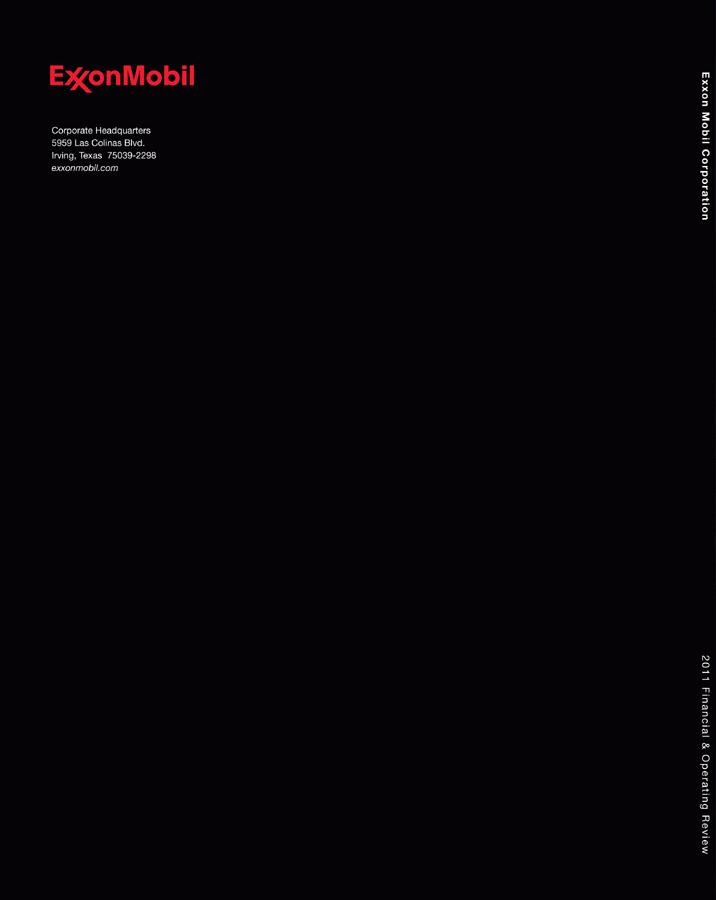
| Corporate Headquarters 5959 Las Colinas Blvd. Irving, Texas 75039-2298exxonmobil.com |
